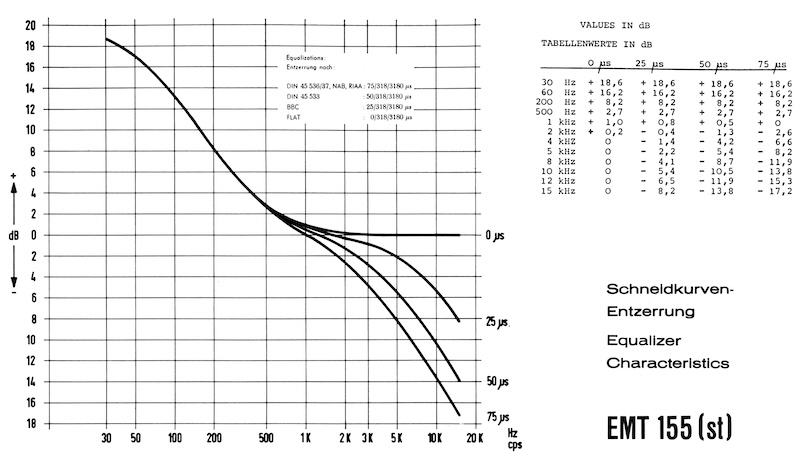EQカーブの歴史 や ディスク録音の歴史を、私が学ぶ過程を記録した本シリーズ。前回 Pt.24 では、録音チェーンおよび再生環境における周波数応答特性や位相特性が変化しうるパターンについて調べ、可変イコライザ等の使用による音作りが(特にポピュラー音楽系で)多く行われていることを改めて学びました。また、各種CDリイシュー音源の比較により、当時のシングルマスター、当時のLPマスター、マルチトラックマスターからのリマスター、などを比較することで、ディスク録音イコライザを通過する前の音の違いが確認できることも紹介しました。
This series have documented my process of learning the history of EQ curves and disc recording. In the previous Pt.24, I examined the patterns in which frequency response characteristics and phase characteristics can be changed in the recording chain and reproducing environment, and I learned again that the sound creation (especially in popular music) is often done through the use of variable equalizers and the like. I also introduced the comparison of various CD reissues to confirm the differences in sound between single masters of the time, LP masters of the time, remastered from multi-track masters, etc., before passing through the disc recording equalizer.
最終回 となる今回 Pt.25 は、2年以上に及び調べ学んできた膨大な内容を総括した 要約(復習)です。諸説多きディスク録音EQカーブについて、現時点で分かっていることを整理し、現時点での私の理解に基づき、最後に結論めいたものを記しています。また、少しでも読みやすくするため、仮想キャラ2名によるカジュアルな対話形式を挿入してみました(笑)
This Pt.25, which will be the final part, is a summary of the vast amount of information that I have learned and researched over the past two years. I will then summarize what is currently known — and some tentative summary and conclusion based on my current understanding of many thories — about the EQ curves of disc recordings. Also, in order to make it as easy to read as possible, I have inserted casual dialogues between two virtual characters 🙂
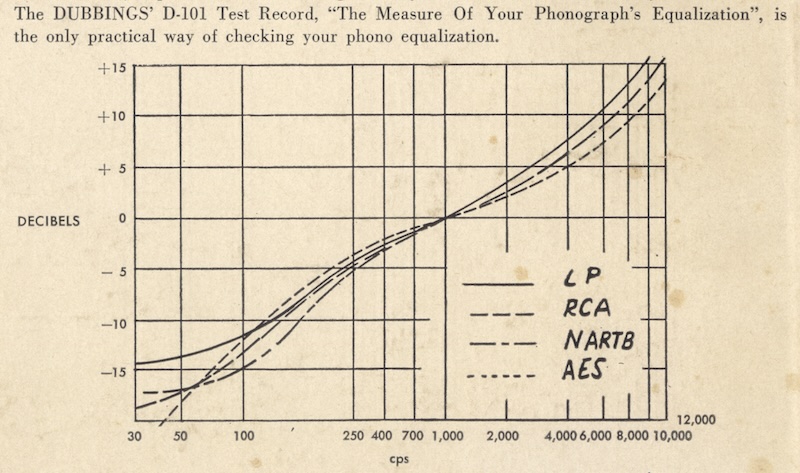
source: The Measure of Your Phonograph’s Equalization (Dubbings D-101, 1953)
from my own collection
毎回書いている通り、筆者自身の学習過程を記したものですので、間違いの指摘や異論は遠慮なくお寄せください。
As I noted in every part of my article, this is a series of the footsteps of my own learning process, so please let me know if you find any mistakes on my article(s) / if you have different opinions.
Contents / 目次
- 25.0 Before We Proceed / はじめに
- 25.1 How the “Disc Recording Equalizing” was born
- 25.2 Toward the Inception of “High-Frequency Pre-Emphasis”
- 25.3 Electrical Transcription Discs
- 25.4 Pre-emphasis with consumer 78rpms
- 25.5 Piezoelectric Pickups and its Reproducing Characteristics
- 25.6 NAB Standards (1942) and Sapphire Club in the WWII Era
- 25.7 The Birth of “Long-Playing” “Microgroove” Records and More
- 25.8 NARTB (1953) / AES (1954) / RIAA (1954) Characteristics
- 25.9 After The Standardization
- 25.10 Frequency Test Records
- 25.11 Phono EQs in Consumer Amplifiers
- 25.12 History and Variety of EQ Curve List
- 25.13 Conclusion and My Final Thoughts / 結論、および雑感
- 25.14 Notable References (for my entire articles)
- 25.15 Special Thanks To…(titles omitted, 敬称略)
25.0 Before We Proceed / はじめに
本 Pt.25 は、この2年強を通じて学んできたことのざっくりまとめとなります。大量の書籍、技術資料、論文、雑誌記事と出会ったことを改めて実感しました。また、非常に多くの有益な知見が得られた2年間でした。
This Pt.25 is a rough summary of what I have learned throughout the past 2+ years. I am reminded once again of the large amount of books, technical documents, academic papers and magazine articles that I have encountered. Also, it has been such a two-year period in which I have got a great deal of useful knowledge and insights.
例によって、非常に長いページとなっており、目を通されるのも一苦労かもしれません(すみません) が、Pt.0 〜 Pt.24 の大量の内容を可能な限りぎゅっと圧縮し、ほぼ時系列にディスク録音の歴史を追った内容となっています。
As usual, this here is a very lengthy page, and you may have a hard time reading through it (sorry for that), but the vast contents from Pt.0 to Pt.24 have been compressed as tightly as possible, and the history of disc recording has been followed almost in chronological order.
この灰色バックの囲みには、各セクションの概要を記しています。
This gray-back enclosure outlines each section.
本文中では、原則として「さまざまな資料や論文から分かった客観的事実」を述べています。
The main text states “objective facts known from various sources and papers” as a general rule.

仮想キャラ2名による吹き出しのカジュアルな会話部分には、
Casual dialogue parts between the two virtual characteris in the speech baloons like this…
わたし自身の理解と解釈に基づいた仮説・推測、および余談などが含まれています。
…contains hypotheses and reasonings based on my own understanding and interpretation, as well as digressions.

25.1 How the “Disc Recording Equalizing” was born
以下、特記なき場合は、すべて米国における歴史です。本稿では、英国や欧州における歴史についてはほとんど扱われていません。
All of the followings, unless otherwise noted, is a history in the U.S., while very little on the history in the U.K. or Europe is covered in the entire series of my articles.
まずは、ディスク録音の原理と録音EQカーブ誕生について。1920年代後半あたりの話です。
First, this section 25.1 deals with the summary of principles of disc recording, and the birth of recording EQ curves. The timespan is approximately the late 1920s.
25.1.1 Nature of Disc Recording: Constant Velocity
音をレコード溝の振幅に変換する際、周波数の高低によって刻まれる振幅に差が生じる。すなわち、音のレベルが同じであれば、低音(低周波数)は大きな振幅として記録され、高音(高周波数)は小さな振幅として記録される、すなわち定速度 (constant velocity) の特性を備える( Pt.1 セクション 1.1.1)。
When sound is converted into continuous groove amplitude engraved on the record surface, there is a difference in the amplitude engraved depending on the high and low frequencies. That is, if the sound levels are the same, low tones (low frequencies) are recorded as large amplitudes, and high tones (high frequencies) are recorded as small amplitudes, i.e. they have the property of constant velocity ( Pt. 1 Section 1.1.1).

ラウドスピーカーのウーファーは、目に見えるくらい前後に動くけど、スコーカーやツイーターはそこまで動いてないようにみえる、ってのと似てるような気がする。
It seems similar to how the woofer in a loudspeaker moves visibly back and forth, but the mid-range unit and the tweeter don’t seem to move that much.
確かに、同じ音圧レベル (SPL) であれば、低周波の方が大きく動くし、高周波では小さく動くことになるから、同様に考えられるね。
Certainly. For the same sound pressure level, the same would be true for low frequencies, which would move more, and for high frequencies, which would move less.

レコードのように螺旋状に横振動記録する場合、振幅が大きくなればなるほど、隣接する溝と接触しないように溝間隔を広くとる、すなわち1インチあたりの溝の数 (gpi, grooves per inch) の値を小さくする必要がある。しかし、そのことで、盤面に記録可能な時間が少なくなってしまう。また、振幅が大きすぎると、再生針が正確にトレースしにくくなってしまう問題もある( Pt.1 セクション 1.1.1)。かといって、全体的に記録レベルを下げて振幅を小さくすると、音量が下がり、結果としてサーフェズノイズに埋もれてしまうことになる。
In the case of spiral horizontal vibration groove like a disc record, the larger the amplitude, the wider the groove spacing must be to avoid contact with adjacent grooves, i.e. the smaller the value of the number of grooves per inch (gpi). However, this reduces the amount of time that can be recorded on the disc. Another problem is that too large an amplitude makes it difficult for playback needle to trace accurately ( Pt.1 Section 1.1.1). On the other hand, if overall recording level is lowered to reduce the amplitude, the volume will be reduced as well and consequently buried in the surface noise.

もし、低域を抑制せずに(ターンオーバーなしの定速度フラット)記録したとしたら、記録時間はどのくらい短くなるんだろう?
If it was to be recorded with unattenuated bass (constant velocity throughout all range without “turnover”), how much shorter would the recording time be?
一概には言えないけど、相当短くなるだろうね。一例として、英Wireless World誌1954年10月号に掲載された O.J. Russell 氏の解説記事 “Stylus in Wonderland” 中では、12インチ78回転盤は通常片面に5分くらい記録できるが、「もし低域抑制なしにしたら1分未満になるだろう」と書かれてるね。
It’s hard to say, but I guess it would be considerably shorter. As an example, in the article “Stylus in Wonderland” by O.J. Russell in the Oct. 1954 issue of Wireless World UK magazine, it says that a 12-inch 78rpm disc can usually hold about 5 minutes on each side, but “it would have a possible playing time of less than a minute with an unattenuated bass characteristic”.


そんなに違うんだ!低域の振幅ってそんなに幅をとるんだね。
It was that different! The amplitude of the low frquency range takes up so much width.
250Hz あたりが下限だったアコースティック録音時代と比べて、電気録音時代にはさらに低域がカッティングできるようになったから、この問題が生じたってことだね。ちなみに、電気録音最初期の特性グラフをみると、低域はおおよそ100Hz、がんばって80Hzくらいまではいけてたみたいだ。
Compared to the acoustic recording era, when the lower limit was around 250Hz, the electrical recording era allowed for even more low-freqency cutting, which was why this problem arose. Incidentally, looking at the characteristic graph of the early period of electrical recording, it seems that the lowest frequency was approximately 100Hz, or down to 80Hz at the best effort.


それに、当時は可変ピッチなんてなくて、基本的には固定ピッチでカッティングしてたんだよね( LPのオールアナログカッティングとディジタルディレイ 参照)。
Besides, there was no such thing as “variable pitch” cutting back then, and the recording was cut with a “fixed pitch” ( see also: All Analogue Cutting vs Digital Delay, written only in Japanese).
いわゆる「ダイレクトカッティング」だからね。また、ディスク録音機器もまだそんなに複雑な制御ができなかった時代だろうしね。
It was what we call “direct-to-disc” cutting. Also, disc recording equipment of the time would not have been capable of such complicated control.

25.1.2 The Dawn of Electrical Recoring and “Turnover Frequency”
アコースティック録音の時代は、実質的に記録可能な周波数帯域が非常に狭く(せいぜい 250Hz〜2,500Hz 程度)、また、そもそも録音用ホーンで収音した音をダイアフラムでそのまま振動に変換するしかなかった( Pt.1 セクション 1.1.1)。しかし、電気録音になると、最終的に下は 30Hz 程度まで捉えることが可能になったため、溝間隔の問題が顕在化することとなった。
In the acoustic recording era, the frequency range that could be practically recorded was very narrow (250Hz to 2,500Hz at most), and to begin with, the sound collected by a recording horn could only be converted directly into vibration by a diaphragm ( Pt.1 Section 1.1.1). However, when it came to electrical recording, it became possible to capture sounds down to about 30Hz at best, and the problem of groove spacing became appaent.
そこで、ある周波数より下の領域を定振幅 (constant amplitude) の特性( Pt.1 セクション 1.1.2)に抑え込む、すなわち1オクターブ下がるごとに -6dB となるように記録することで、溝間隔を広げずに記録することを可能とした。そして再生時には、その分低域を増幅することとした。
Therefore, the region below a certain frequency was suppressed to the constant amplitude characteristic ( Pt.1 Section 1.1.2), i.e. -6dB down per octave, which made it possible to record without widening the groove spacing. The low frequency range is then amplified during playback.
この定速度と定振幅の切り替わりとなる周波数のことを、ターンオーバー周波数 と呼ぶ。
The frequency at the boundary between constant velocity and constant amplitude is called the turnover frequency.

つまりこのグラフが電気録音最初期の録音カーブってことかな。ターンオーバー f0 のところがなだらかになってるのはどうしてだろう?
So, I guess this graph is the recording curve of the very early electrical recordings. Why is that the turnover f0 so smooth and round?
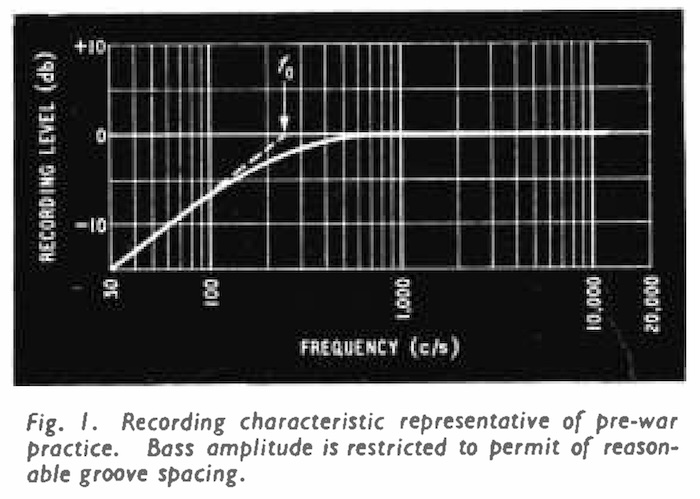
source: “Stylus in Wonderland”, O.J. Russell, Wireless World, Oct. 1954, p.505.
厳密に f0 で折れ曲がる理想的な特性を実現するには、実現する回路が複雑になってしまうからだね。後年のカーブ、例えば 1942 NAB カーブの元となった RCA Victor / NBC Orthacoustic カーブの解説記事でも「理想的なカーブを実現するためには非常に複雑な多段フィルタが必要となり、これを避けるために角を丸めるのが認められている」とあるよ( Pt.5 セクション 5.2.3)。
In order to accomplish the ideal characteristics such that the curve bends strictly at f0, the circuit to realize it would be complicated. Even in the 1942 article of RCA Victor / NBC Orthacoustic curve, which was the origin of the 1942 NAB curve, it reads that “In actual practice the corners at 100 cps and 500 cps are permitted to round off slightly thus avoiding the use of more complicated multiple section filters” ( Pt.5 Section 5.2.3).

実用化された世界初の電気録音は、Bell Telephone Laboratories (以下 Bell Labs) の J.P. Maxfield と H.C. Harrison によって開発され、1925年4月に初の電気録音盤が市販された( Pt.2 セクション 2.1.5)。また、1926年に Bell Systems Technical Journal に電気録音に関する技術論文「Methods of High Quality Recording and Reproducing of Music and Speech Based on Telephone Research」が発表された( Pt.1 セクション 1.1.1)。
The world’s first practical electrical recording was developed by J.P. Maxfield and H.C. Harrison of Bell Telephone Laboratories (Bell Labs), and the first electriccally recorded disc was commercially released in April 1925 ( Pt.2 Section 2.1.5). A technical paper on electrical recording, “Methods of High Quality Recording and Reproducing of Music and Speech Based on Telephone Research”, was published in the Bell Technical Journal in 1926 ( Pt.1 Section 1.1.1).
当時は、再生機器がアコースティックであり、ヴィクトローラ・クレデンザ のロガリズミックホーンを巧妙に設計し低域を絶妙に増幅することで、電気録音の録音特性にマッチした再生特性を実現していた( Pt.1 セクション 1.2.2)。
At that time, the reproducing equipment was still acoustic, and the Victrola 8-30 Credenza‘s logarithmic horns were cleverly designed to exquisitely amplify the low frequencies, thus matching the electrically recorded characteristics ( Pt.1 Section 1.2.2).
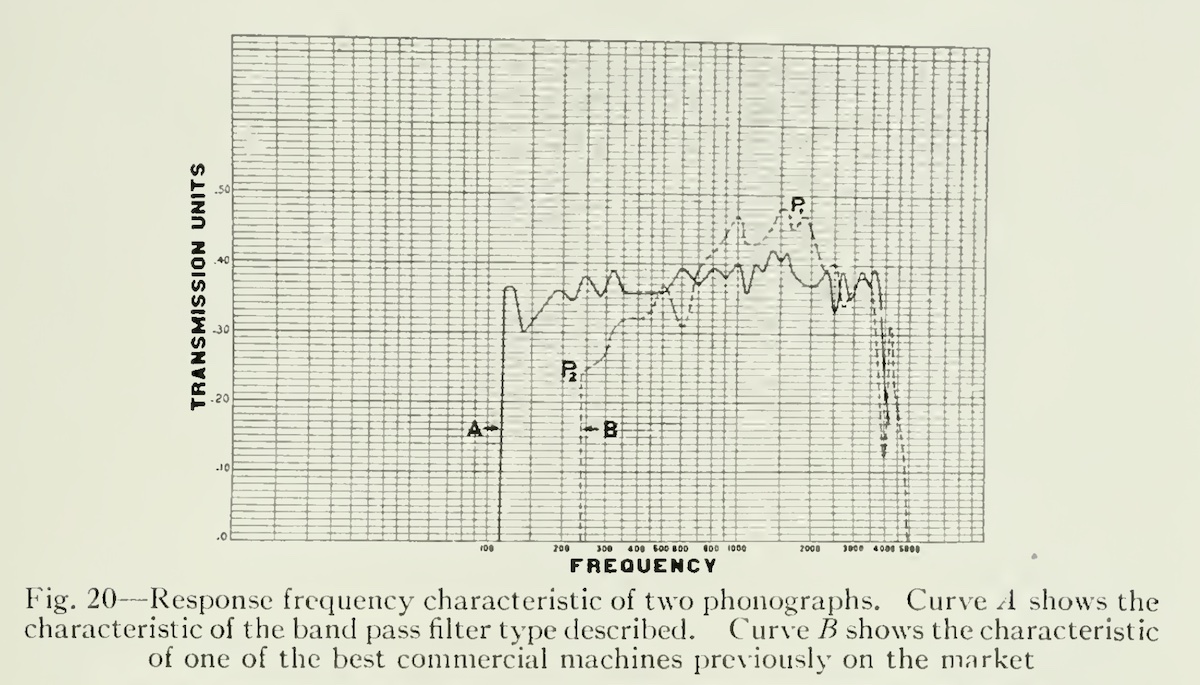
source: “Methods of High Quality Recording and Reproducing of Music and Speech Based on Telephone Research”, by J.P. Maxfield and H.C. Harrison, Bell System Technical Journal Vol.5, pp.493-523, 1926
この周波数特性グラフのAが、当時の電気録音ディスクを Victrola Credenza で再生した際の特性

電気録音でも、最初はアコースティック再生だったんだね。で、電蓄というか、電気再生はいつ頃始まったんだろう?
Even for electrical recordings, reproduction was initially acoustic! By the way, what was the first electric reproducer?
民生用としては、Victor より先に Brunswick が1925〜26年頃 Panatrope という電蓄を出したのが最初らしいよ( Pt.2 セクション 2.2.1)。その後少し遅れて Columbia から Kolster が、Victor Talking Machine から Electrola が登場したようだね( Pt.2 セクション 2.2.2)。
The first electroic reproducing system for consumer arguably was Brunswick’s Panatrope, introduced around 1925-26. It came out before Victor’s ( Pt.2 Section 2.2.1). Then, a little later, Kolster from Columbia and Electrola from Victor Talking Machine appeared on the market ( Pt.2 Section 2.2.2).

25.1.3 “Rubberline” Recorder and Its Recording Characteristics
この最初期電気録音当時のターンオーバー周波数は 250Hz であったとされている( Pt.1 セクション 1.2)。しかし実際には「200Hz〜300Hz」程度のゆるい精度で規定されていたことが、現存する当時の Bell Labs の技術資料から明らかとなっている( 2022 ARSC Conference における Nicholas Bergh 氏の発表スライド、ARSC 会員のみ閲覧可能)。
The turnover frequency at the time of this earliest electrical recording is said to have been 250Hz ( Pt.1 Section 1.2). However, Bell Labs’ technical documentation from that time, which is still in existence, reveals that the turnover frequency was actually specified with a loose accuracy of “200Hz to 300Hz” ( slides presented by Nicholas Bergh at the 2022 ARSC Conference, available only to ARSC members).

「200Hz〜300Hz」って、とてもゆるい定義だったんだね。
The definition of the turnover “between 200Hz and 300Hz” was very loose, I guess.
後年〜現代のような録音イコライザがなかった時代、カッターヘッドを巧妙に作り込むことでターンオーバーを実現していたからね。それだけ、のちの技術の発展がすさまじいってことでもある。
When there were no such things as recording equalizers like there were in later years and there are today, turnover was achieved by cleverly built physically in a cutter head. That’s how much technology has developed since then.


じゃあ大したことなかったってこと?
So you’re saying it wasn’t a big deal?
とんでもない。むしろ、今から100年前に、当時としては最先端だったラジオなどの電気工学の知見を援用して、機械的に等価になるように物理的に作った、ってのは、とてつもなく凄いことだよ。
It really was! Rather, it is tremendously amazing that 100 years ago, they were able to develop a mechanical equivalent by using the most advanced electrical engineering knowledge of the time, such as that of radios.

また、この電気録音黎明期においては、ディスク録音イコライザのような機器は使用されておらず、ターンオーバーの制御は、Bell Labs / Western Electric 製の通称「ラバーラインレコーダ」という当時のカッターヘッドの物理特性によって巧妙に実現されていた( Pt.1 セクション 1.2)。つまり、カッターヘッドの物理特性が、そのままディスク録音特性を規定していたことになる。
Also, in these early days of electrical recording, devices such as disc recording equalizers were not yet used, and turnover control was cleverly achieved by the physical characteristics of the cutterheads of the time, commonly known as “rubberline recorders” developed by Bell Labs / Western Electric ( Pt.1 Section 1.2). In other words, the physical characteristics of the cutterhead directly defined the disc recording characteristics.
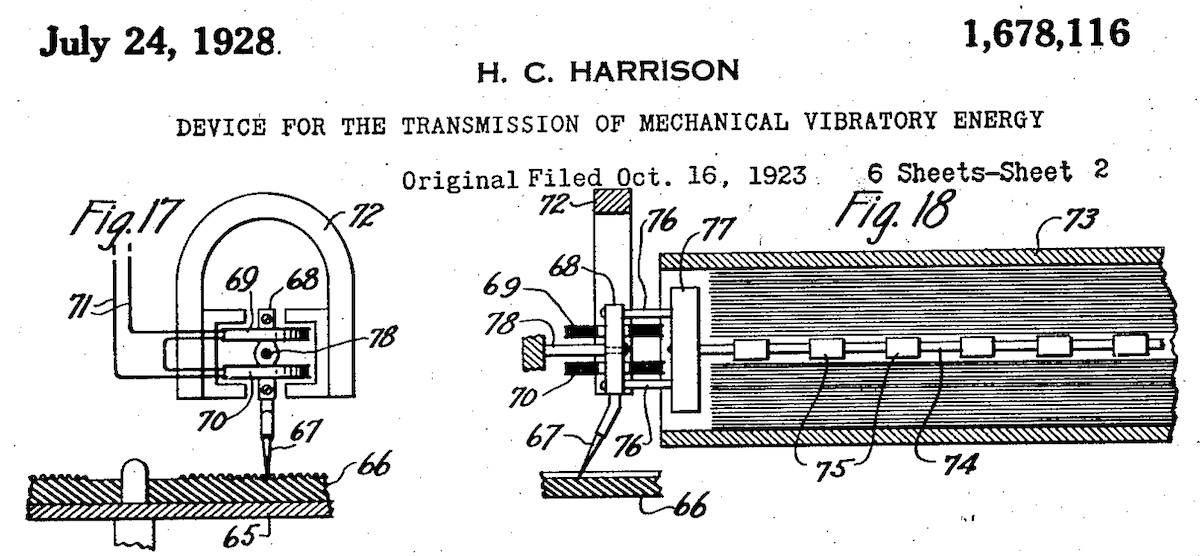
source: “Device for the transmission of mechanical vibratory energy“, US Patent 1,678,116A, 1928
特許資料に登場する、ラバーラインとカッターヘッドの図版
Illustrations of “rubber-line” and electromagnetic cutter head, as shown in the Harrison’s patent document
そのため、経年劣化によりターンオーバーが変化してしまったり、気温や湿度によって特性が変化しやすかったと言われている( Pt.1 セクション 1.2.1)。よって、セッションによってターンオーバー周波数が一定でなかった可能性も考えられる。
Therefore, it is said that the turnover changed over time and that the properties were easily affected by temperature and humidity ( Pt.1 Section 1.2.1). Consequently, it is possible that the turnover frequency was not constant from a recording session to another.

抵抗やコンデンサの交換とか、スイッチの切り替えで微調整できたわけではなかった時代、録音特性の調整は大変だっただろうね。
It must had been difficult to fine-tune the recording characteristics in an era when it was not possible to replace resistors and capacitors, nor to adjust switches.
そうだね。それと、念の為強調しておくけど、確かに戦後以降は再生側にスイッチ切替式の可変フォノイコとかあるけど、ディスク録音イコライザは較正用ポジションを除き基本的には固定のものしかなかったからね。
Exactly. Also, just to emphasize for the record, there have been indeed switchable/adjustable variable phono equalizers on the playback side, especially since the post war period, but the disc recording equalizers were basically only fixed ones, except they had “FLAT” position for calibration.


で、この当時はどうやってターンオーバー値の調整をやっていたんだろう?
So, how were they fine-tuning turnover values at that time?
おそらく、テストカッティングをして現在の録音特性をチェックし、ずれていればラバーラインレコーダを Bell Labs / Western Electric に送り、微調整/リファービッシュ/新品交換を依頼、とかしていたんだろうね。けど、全てのレーベルが予算的に潤ってたわけではなかっただろうから、ずれていても気にせず使い続けられた、はたまた、ずれてることに気づかないまま使われていた、そんな例は少なからずありそうだね。
They probably did a test cutting to check the current recording characteristics, and if they found any discrepancies, they would send the rubberline recorder to Bell Labs / Western Electric for fine-tuning/refurbishing/replacing with new ones. However, not all labels at the time had a large budget, so there might have been a few cases where they continued using the recorders even if the cutters were out of alignment (or they didn’t even notice the difference).

高域はというと、当時の技術的限界から、当初は 4,500Hz あたり、ほどなく 5,500Hz あたりを上限にフラットに記録され、それより上は定加速度特性で急速減衰されていた( Pt.1 セクション 1.2)。これは、記録してもサーフェスノイズに埋もれてしまうから、という意味もあった。
High frequencies were initially recorded flat at around 4,500Hz and soon after at around 5,500Hz, due to the technical limitations of the time, and the above frequencies were rapidly attenuated by the constant acceleration characteristic (Pt.1 Section 1.2). This was conducted partly because the high-frequency portion of the recordings would be buried in surface noise.
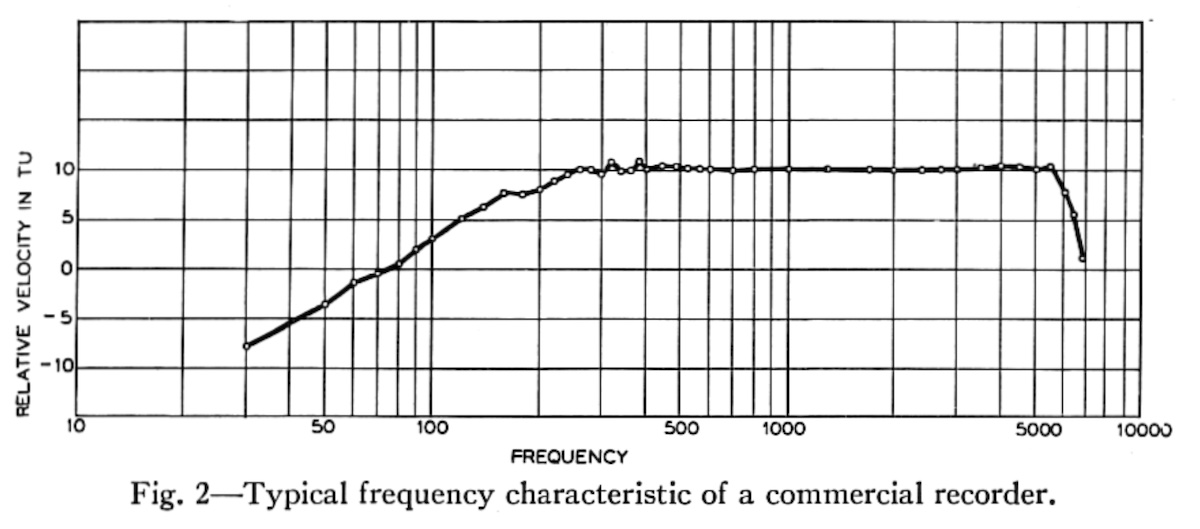
source: “Recent Advances in Wax Recording”, Halsey A. Frederick, Bell System Technical Journal, Vol.8, Issue 1, pp 159-172 (January 1929)
archived at Internet Archive (archive.org)

電気録音黎明期って、高域はそんなに記録されてなかったってことなんだね。
So, in the early days of electrical recording, high frequencies were not recorded that much.
それでもアコースティック録音の頃と比べるとものすごい進化だったのは事実だよね。
Still, it is true that it was a tremendous evolution compared to the days of acoustic recordings.

25.2 Toward the Inception of “High-Frequency Pre-Emphasis”
続いて、録音EQのうち、高域プリエンファシス部分誕生前夜までの流れです。1920年代前半からラジオにシェアを奪われレコード売上枚数が激減( Pt.2 セクション 2.4)、追い討ちをかけるように1929年暮れに世界恐慌となった時期(Pt.3 セクション 3.2.1)、それでもレコードの技術開発と進化は地道に進んでいました。1920年代暮れ〜1930年代前半あたりの話です。
The next section is the eve of the birth of the high-frequency pre-emphasis portion of recording EQ. It had been a time when took market share away from records and sales declined sharply ( Pt.2 Section 2.4), followed by the Great Depression at the end of 1929 (Pt.3 Section 3.2.1). Nevertheless, technological development and evolution of phonograph records continued to progress steadily. The timespan is approximately from the late 1920s to the early 1930s.
25.2.1 Vitaphone and “33⅓ rpm”
1926年、無声のみだった映画の世界にトーキーが登場、当初は映像を収めたフィルムと同期してディスクから音声を再生させるシステム Vitaphone によって実現されていた( Pt.4 セクション 4.1)。
In 1926, “talkies” were introduced, initially realized with the Vitaphone, a system that synchronized the playback of sound from a disc with the film containing the moving pictures ( Pt.4 Section 4.1).

サウンド・オン・フィルム(映像フィルム上の光学録音)ではなくて、サウンド・オン・ディスク(映像フィルムとレコードを同期させて再生)の時代だね。1931年頃にはサウンド・オン・フィルムに駆逐されたそうだけど。
Hmmm, it was the era of sound-on-disc, not sound-on-film (optical sound recording), which was apparantly eclipsed by sound-on-film around 1931.
ただ、当初サウンド・オン・ディスクの設備に投資したけど設備更新の余裕がなかった映画館が少なくなかったため、光学録音からダビングした Vitaphone の提供は1937年頃まで続いていたと言われているよ。
However, many movie theaters initially invested in sound-on-disc equipment but could not afford to upgrade their facilities, so Vitaphone dubbed from optical recordings continued to be offered until around 1937.

この Vitaphone は16インチ盤で、33⅓回転であり、現在の LP レコードの回転数はここに由来する。
The Vitaphone was a 16-inch disc with 33⅓ rpm, from which the current rpm of LP records is derived.

ところで前から疑問だったんだけど、33⅓ rpm っていう非整数な回転数に決められたのはなぜなんだろう?
By the way, I’ve wondered for a while, why 33⅓ rpm — which is a non-integer value — was chosen?
AC 60Hz 電源で 3,600 rpm て定速回転するモータがあったとして、これに 108:1 の比率のギアを使って減速すると、3,600 / 108 = 33.3333… = 33⅓ rpm となるよね。同様に、80:1 のギア比だと 3,600 / 80 = 45、これが 45rpm で、46:1 のギア比だと 3,600 / 46 = 78.2608695652、これが 78rpm と呼ばれているものの正確な回転数、ってことだね。で、当時の1,000フィートの35mmフィルムで11分間で、16インチの Vitaphone で11分間記録可能な線速度を実現する回転数ということで、33⅓ rpm が採用されたってことみたいだね。
Suppose we have a motor that rotates at a constant speed of 3,600 rpm on a 60Hz AC power supply. If we use a gear ratio of 108:1 to reduce the speed, we get 3,600 / 108 = 33.3333… = 33⅓ rpm. Simiarly, with an 80:1 gear ratio, we get 3,600 / 80 = 45 rpm, and with a 46:1 gear ratio, 3,600 / 46 = 78.2608695652 rpm, which is the exact speed of what is called 78 rpm. So, it seems that 33⅓ rpm was adopted to achieve a line speed that would allow recording on a 16-inch Vitaphone for 11 minutes on 1,000 feet of 35mm film at the time.

プロフェッショナル用途であったこの Vitaphone の技術は、のちにもう1つのプロフェッショナル分野であるラジオ放送局用のメディア、トランスクリプション盤の礎となり、その技術は折に触れ民生用レコードへと応用されていくこととなった。1931年に RCA Victor が民生用に販売した33⅓回転長時間レコード Program Transcription もその1つであった( Pt.4 セクション 4.2)。シェラック盤よりも高品質な合成樹脂を使用した Victrolac もこの際開発された( Pt.4 セクション 4.2.1)。
Technology of Vitaphone for professional use later became the foundation for another professional field of media, electrical transcription discs for radio stations, and it also was later applied to consumer records from time to time. RCA Victor’s “Program Transcription Records” for consumer use, 33⅓ rpm long playing records, was one of them ( Pt.4 Section 4.2). Victrolac, one of the earliest artificial plastic and better quality than shellac, was developed at the time ( Pt.4 Section 4.2.1).
25.2.2 Evolution of Rubberline Recorders and “500Hz” Turnover
民生用レコードのカッティングに使われていた Bell Labs / Western Electric 製ラバーラインレコーダは、徐々に改良が進み、1929年頃には 8,000Hz 程度まで記録可能となっていた( Pt.3 セクション 3.4.2)。ただし、カッティングされたワックス盤やメタルマスターには 8,000Hz 程度まで記録できていたとしても、当時の民生用シェラックレコードはシェラック樹脂が3割、残る7割が石灰岩や粘板岩を粉砕した粉(マイカパウダー)、カーボンブラック、コーパルガム、タールピッチなどで構成されていたため、サーフェスノイズが大きく、実際にはS/N比は30dBがせいぜいであった。
The Bell Labs / Western Electric’s rubberline recorders used for cutting consumer records were gradually improved, and by around 1929 they were capable of recording up to about 8,000Hz ( Pt.3 Section 3.4.2). However, even though wax discs (cut by rubberline recorders) and metal masters could record up to about 8,000Hz, consumer “shellac” 78rpm records at that time were made of shellac resin (30%), and the remaining 70% was made of crushed limestone or slate powder, carbon black, copal gum, tar pitch, etc., and such records’ S/N ratio was 30dB at best.

シェラック盤のシェラック含有率が3割だけで、岩を粉砕した粉が多く含まれていたなんて。それじゃシェラック盤じゃなくむしろ岩粉盤だね。
I can’t believe that the shellac content of the shallac record was only 30% and that it contained a lot of ground-up stone! Then it should not be called a “shellac record”, but rather a “rock-powder record” or something!
当時の蓄音機の針圧は数百グラムとかザラだったし、さらに鉄針だった。だから、純粋なシェラック樹脂だけでサーフェスノイズの少ない盤を作ったとしても、あっという間に溝が削られてしまう、だから岩粉を混ぜて針も摩耗させるようにしていた、って側面もあるよね。それで当時は岩粉のことを「抗摩耗剤」って呼んでいたんだと思う。
The needle pressure of phonographs at that time was usually several hundred grams, and moreover, the needles were made of iron. So even if a disc with low surface noise was made of pure shllac resin, the grooves would be worn away in no time, so rock ground-up stone was mixed in to wear away the needle. I think that’s why they called the ground-up stone “abrasive” back then.

一方、このラバーラインレコーダを使用するライセンス料金が非常に高く、1929年の
On the other hand, the license fees to use these rubberline recorders were extremely expensive, and the Great Depression of 1929 coincided ( Pt.3 Section 3.2.1). To avoid paying the expensive license fees, major companies began developing their own recording systems ( Pt.3 Section 3.2). However, the surviving actual recorders reveal that many of them were carbon-copy version ( Pt.3 Section 3.4.3) ( slides presented by Nicholas Bergh at the 2022 ARSC Conference, available only to ARSC members).

世界恐慌を受けて、米国でのレコード業界が壊滅的な打撃を受けたんだったよね。
The Great Depression devastated the record industry in the U.S., didn’t it?
なにしろ、1929年には全米で1億枚以上だったレコード販売枚数が、1932年には600万枚にまで落ち込んだんだからね。販売価格を大幅に下げざるをえなくなり、多くのレーベルが倒産したり大手レーベルに買収されたりしたのが1930年代前半だね。
In 1929, record sales in the U.S. were over 100 million copies, but by 1932, they had dropped to 6 million. The sales price had to be drastically reduced, and many labels wenb bankrupt or were bought out by major labels in the early 1930s.


それにしても、ライセンス料支払い回避のためにクローン開発なんて、法的にはかなりグレーな気がするけど…
Still, I think developing carbon-copy clones to avoid paying licensing fees is a very gray area legally…
当時はそういう時代だったんだろうね。そして、1940年代まで続く各社の秘密主義ってのも、ここら辺りが源流の可能性はありそうだね。
I guess that’s the way things were back then. And the secrecy of the companies that continued until 1940s may have its origin in these circumstances.

また、Columbia は 1930年〜1931年頃、RCA Victor は 1932年頃、それぞれターンオーバーを 500Hz に引き上げていたことが、当時のさまざまな資料から確認できる( Pt.3 セクション 3.4.2 および セクション 3.5)( 2022 ARSC Conference における Nicholas Bergh 氏の発表スライド、ARSC 会員のみ閲覧可能)。ちょうどこの1930年代前半頃に、米国における民生用レコードの録音特性は、ターンオーバー 500Hz がほぼ標準となっていた。一方、英国や欧州では、1950年代初頭までターンオーバー 250Hz(200Hz〜300Hz)がほぼ標準であった。
Various documents from the period confirm that Columbia and RCA Victor had increased their turnover frequency to 500Hz by about 1930-31 and 1932, respectively ( Pt.3 Section 3.4.2, Section 3.5) ( Pt.3 Section 3.4.3) ( slides presented by Nicholas Bergh at the 2022 ARSC Conference, available only to ARSC members). Just around this time in the early 1930s, the turnover frequency of 500Hz was almost the standard recording characteristic for consumer records in the U.S., while in the U.K. and Europe, the turnover of about 250Hz was the standard until the early 1950s.

米国だけターンオーバーが引き上げられたのには何か理由があったんだろうか。
Was there any reason why turnover was raised only in the U.S.?
まず、ターンオーバーを引き上げる、ということは、それだけ低域を十分に記録するための措置だよね。で、米国では早くから電気再生が普及したから、再生側でターンオーバー変更は、コンデンサ容量や抵抗値を変えるだけで対応可能ってことだね。
First of all, raising the turnover, that’s a measure to record enough low frequencies, right? And since electrial playback became popular in the U.S. early on, this means that turnover changes on the playback side can be handled by simply changing capacitance and resistance values.


じゃあ逆に、英国や欧州でターンオーバーが変更されなかったのは?
On the other hand, why was turnover not changed in the U.K. and Europe?
植民地が多かった英国・欧州では、アコースティック蓄音機が依然主流だったから、むやみにターンオーバーを引き上げられることがなかった、と言われているよ。同じ理由で、英国や欧州で遅くまで高域プリエンファシスが使われなかった(あるいは米国より控えめであった)という考察もあるね( Pt.9 セクション 9.2)。
It is said that in the U.K. and Europe, where there were many colonies, acoustic phonographs were still the norm, so turnovers were not raised unnecessarily. For the same reason, there is also the consideration that high-frequency pre-emphasis was not used (or was more modest than in the U.S.) until later in the U.K. and Europe ( Pt.9 Section 9.2)

25.2.3 Ribbon Microphones and “Voice Effort Equalization”
当時の民生用レコードでは、サーフェスノイズに負けないように高域を増幅して記録するための意図的な高域プリエンファシスはまだ用いられていなかったが、電気録音初期から使われていたコンデンサマイクは 3,500Hz あたりに +5〜6dB のピークを持つ特性であった(録音イコライザ目的ではなかったことに注意)( Pt.3 セクション 3.4.4)。これが、結果としてサーフェスノイズ対策の役目を果たしていたという説もある。
High-frequency pre-emphasis to amplify and record high frequencies to overcome surface noise was not yet used in consumer records at that time, but condenser microphones used since the early days of electrical recording had a characteristic of +5 to 6dB peak around 3,500Hz (note that this was not for recording equalization purposes) ( Pt.3 Section 3.4.4). Some believe that this served as a surface noise suppressor as a result.

録音・再生カーブ前提のプリエンファシスじゃなくて、当時のマイクの特性によって、たまたま高域がサーフェスノイズに埋もれないレベルで記録されていた、ってことだね。
So it was not the pre-emphasis as a recording/reproducing curve, but rather the characteristics of the microphones of the time, which happened to record high frequencies at a level where they were not buried by surface noise.
そうなるね。だから、電気録音黎明期については、そのような特性のマイクが使われてたか判明している盤については、そのマイクの特性も込みで高域を下げて再生してあげる方がいい、という立場の人もいるね。例えば、最初期の盤は 250N-6(ターンオーバー250Hz、ロールオフ 6dB at 10kHz)や 250N-8 が望ましい、とか。
That’s what it means. Therefore, there are those who argue that, in the early days of electrical recording, it is better to play back with the high frequencies lowered to include the characteristics of the microphones used, if it is known that microphones with such characteristics were used. For example, they suggest that 250N-6 or 250N-8 is preferable for reproducing early U.S. electrical 78 rpms.

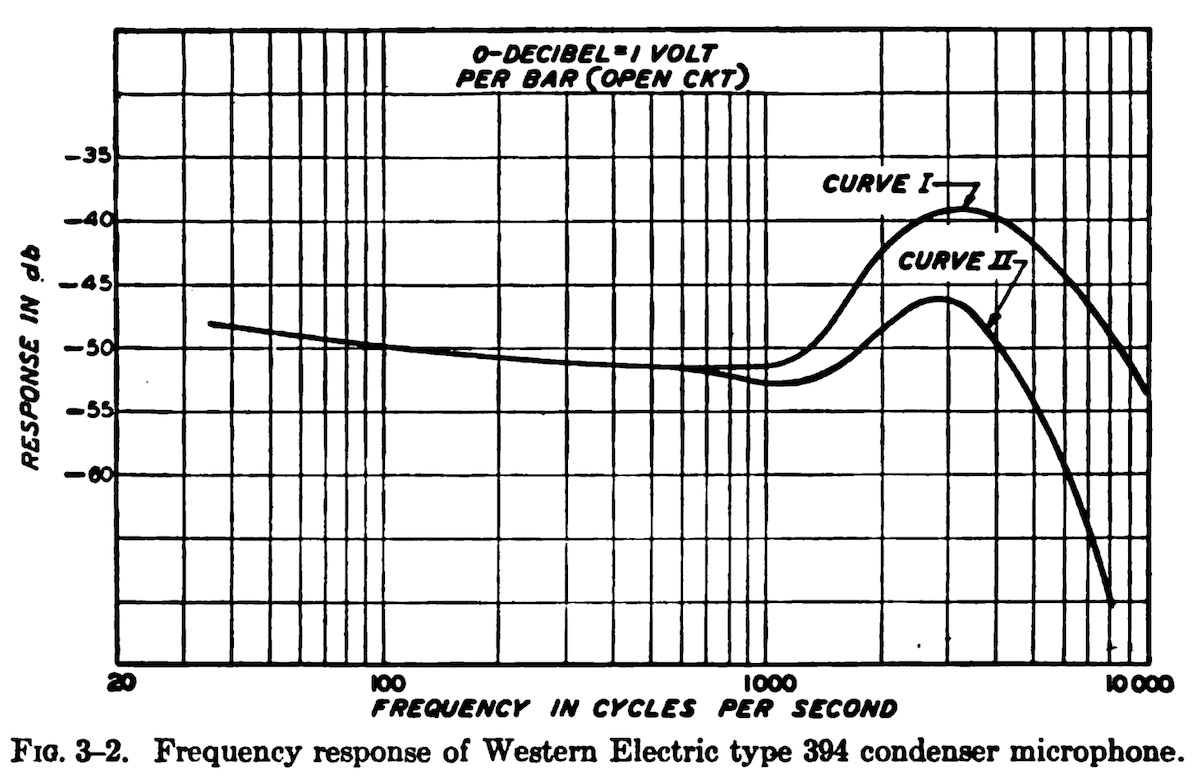
source: “Elements of Sound Recordings”, p. 36, by John G. Frayne and Halley Wolfe, 1949.
Western Electric 394 コンデンサマイクの周波数特性グラフ。3.5kHz に +10dB 以上のピークがみられる

なるほどね、マイクのハイ上がりを打ち消したら、元の音に近づけられる、と。
I see. So if the microphone’s high rise was canceled, we would get closer to the original sound.
一方で、いやいや、そういうマイクの特性も込みで当時録音されたのだから、高域はそのままで再生する方がいい、つまり 250N-FLAT(ターンオーバー250Hz、ロールオフ 0dB at 10kHz)でいい、という立場の人もいるわけだね。どちらにも一理あることになる。ともあれこれが、78回転盤の再生カーブ一覧表が、諸説分かれている原因のひとつでもあるってことだ。
On the other hand, there are those who say “No, no, no, it’s better to reproduce the high frequencies as they are, since they were recorded at that time with such microphone characteristics included, so it’s adequate to be played with 250N-FLAT”. Both sides have a point. Anyway, this would be one of the reasons why there are so many different theories about the playback curves of 78 rpm recordings.

1931年にフラット特性のリボンマイクが登場した際、RCA ではコンデンサマイクの中高域ピークの音の方が好まれたため、リボンマイクのプリアンプにコンデンサマイクの中高域ピークをエミュレートするための回路 “voice effort equalization” が追加された( Pt.3 セクション 3.4.4 および セクション 3.4.5)。これがのちに、録音イコライザとしての高域プリエンファシスの源流となった可能性が指摘されている。
When ribbon microphones with flat characteristics were introduced in 1931, the mid-high peaks of condenser microphones were preferred at RCA studios, so an equalizer called “voice effort equalization” was added to the ribbon microphone preamplifier ( Pt.3 Section 3.4.4, Section 3.4.5). It has been pointed out that this may later had been the origin of the high-frequency pre-emphasis as a recording equalizer.

「高域プリエンファシスの源流」ってのは少し眉唾っぽい気もするけど、ともあれ、当初はコンデンサマイクの特性をエミュレートする回路をマイクプリアンプに取り入れ、これが後年ミキシングコンソールの後段に移動したってのは、R.C. Moyer 氏の有名な解説記事「Evolution of a Recording Curve」に書かれてるね。
The “origin of high-frequency pre-emphasis” seems to be a bit of an eyebrow-raising theory, but at any rate, R.C. Moyer’s famous article “Evolution of a Recording Curve” explains that the circuitry to emulate the characteristics of condenser microphones was initially incorporated into microphone preamplifiers, which were later moved to the rear stage of mixing consoles.
リボンマイク導入により、今まで慣れ親しんできた音が急に変わって、ミュージシャンからもスタジオエンジニアからも「前の音の方がよかった」と言われた、だからマイクのプリアンプに “voice effort equalization” が追加された、ってのは興味深いエピソードだね。
It is interesting enough that the introduction of ribbon mics suddenly changed the sound they had become accustomed to, and both musicians and studio engineers said that they preferred the sound of the condensor mics, so a “voice effort equalization” was added to the micrphone preamp.


で、その “voice effort equalization” の分を再生時にデエンファシスするか、しないか、も、また意見が分かれる、と。
And then there is also a difference of opinion as to whether the “voice effort equalization” should be de-emphasized during playback or not, right?
そうだね。更に言えば、例えば RCA Victor では、1938年頃までは 4,500〜5,500Hz 以上から、それ以降1947年頃までは 8,500Hz 以上から、それぞれロールオフした上でカッティングしていたそうだ。他レーベルもいろいろやっていただろうけど、詳細は記録に残っておらず確認できそうにない。そういった事情もあり、厳密にこだわろうとすると、単純な「ターンオーバー」「ロールオフ」の値の話だけでは解決しそうにないね。可変フォノイコを使っても「推奨近似値」でしかない、と。
Exactly. Furthermore, RCA Victor, for example, used to roll of and cut from above 4,500〜5,500Hz until about 1938, and from about 8,500Hz until about 1947, respectively. Other labels may have done so as well, but the details are not documented and survived and cannot be confirmed. Because of these circumstances, if we try to be strict about the theory, it is unlikely to be solved by just talking about simple “turnover” and “roll-off” values. Even if you use a variable phono preamp, it is only a “recommended approximation”.

25.3 Electrical Transcription Discs
続いては、民生用レコードとは独立して技術開発が進み、のちの標準規格化の礎になった、放送局用トランスクリプション盤について。録音特性に高域プリエンファシスとベースシェルフが登場しました。縦振動盤と横振動盤があり、当初は縦振動盤が高品質とされ有利だったが、Pierce & Hunt の研究により横振動盤の優位性が証明され、横振動盤が主流を勝ち取るまでの流れです。1930年代全般です。
This section summarizes the broadcast transcription disc, which was developed independently of the consumer records, and became the foundation for later standardization. High-frequency pre-emphasis and bass shelf appeard in recording characteristics. There were vertical and lateral discs, and initially vertical discs were considered to be of higher quality andhad an advantage, until Pierce & Hunt’s research proved the superiority of the lateral discs, then the lateral discs won the mainstream. The timespan is approximately in the entire 1930s.
25.3.1 “Hill-and-Dale” Vertical Electrical Transcription Discs
生放送が主流だったラジオ放送局で、録音済の音源を放送するメディアとして1929年に誕生した トランスクリプション盤 は、当初は78回転だったが、長時間放送対応のためほどなく16インチ33⅓回転盤が主流となった( Pt.4 セクション 4.3)。
Electrical Transcriptions, a.k.a. Radio Transcription Discs, debuted in 1929 as a medium for broadcasting pre-recorded sound sources on radio stations where live broadcasts were the norm, were initially 78 rpm. But soon became the norm for 16-inch 33⅓rpm discs to accomodate longer broadcast time ( Pt.4 Section 4.3).

16インチって大きいね。片面何分くらい収録できたんだろう。
16 inches is big! I wonder how many minutes could be recorded on one side?
当時の民生用78回転盤 (3mil) よりほんの少し細い溝 (2.5mil) で、まだマイクログルーヴじゃないから、LPよりは収録時間が短くて、片面最大15分程度だね。内周スタートのものと外周スタートのものがあり、レーベル面に記載があることが多かった。
The groove was slightly thinner (2.5mil) than the consumer 78 rpm discs of the time (3mil), and since they were not microgroove yet, the recording time was shorter than that of LPs, about 15 minutes maximum per side. There were two types of transcriptions, one with an inside start and the other with an outside start, which were often indicated on the label.

その頃、Bell Labs / Western Electric により1931年に初お披露目された高音質縦振動盤が登場( Pt.4 セクション 4.4)、World Program Service や Muzak などトランスクリプションレーベルで広く採用された。
Around that time, Bell Labs / Western Electric introduced high-quality vertical recording discs initially unveiled in 1931 ( Pt.4 Section 4.4), which was widely used by transcription labels such as World Program Service and Muzak.
Bell Labs / Western Electric が縦振動記録方式を採用した理由は、横振動記録に比べて記録密度をあげられること、当時の重いピックアップやトーンアームを使う横振動盤に比べて再生歪の点でも有利と結論づけられたこと、であった( Pt.4 セクション 4.4)。
Bell Labs / Western ELectric adopted the vertical recording method because it could increase recording density compared to lateral recording method, and it was concluded that it was advantageous in terms of playback distorton compared to lateral discs that used heavy pickups and tonearms of the time ( Pt.4 Section 4.4)

エジソンの蝋管やダイヤモンドディスクで採用されていた縦振動記録がまた復活したんだね。しかも当時は「横振動盤より高音質」が謳われていたんだよね。
Vertical (hill-and-dale) recording, which was used in Edison’s wax cylinders and diamond discs, was back again. And at the time, it was claimed to have “higher sound quality” than lateral discs, wasn’t it?
縦振動記録でピンチ効果歪の払拭、12インチ盤で最大片面20分の記録が可能、抗摩耗剤なしの盤質(当初はセルロースアセテート製)と針圧が5〜25グラムでサーフェスノイズが大幅減少、10,000Hz まで記録可能、と、当時としては夢のような高音質レコードだったんだね。
It was claimed that vertical recording eliminated pinch effect distortion; 12-inch discs could record up to 20 minutes per side; the disc quality (initially made of cellulose acetate) without abraisive and needle pressure of 5 to 25 grams greatly reduced surface noise; and recording was possible up to 10,000Hz… So this was a dream record of high sound quality at the time.


民生用78回転盤では結局採用されなかったけど、当時その可能性を高く評価する人が多かったんだね。
It was not adopted for consumer 78 rpms after all, but many people at that time highly valued the potential of “hill-and-dale” records.
一例として、Fortune 誌1939年9月号の記事「Phonograph Records」では、民生用レコードの新フォーマットとして縦振動盤を出したらいい、と力説されていたね( Pt.5 セクション 5.1.5)
As an example, in the article “Phonograph Records”, in the Sep. 1939 issue of Fortune magazine, it was strongly argued that the vertical discs should be introduced as a new format for consumer records ( Pt.5 Section 5.1.5).

また、この WE 縦振動トランスクリプション盤で、世界で初めて 高域プリエンファシス を含んだ録音再生特性が採用された( Pt.4 セクション 4.4.1)。
In addition, this WE vertical transcription disc was the first in the world to adopt recording and reproducing characteristics that included high-frequency pre-emphasis ( Pt.4 Section 4.4.1).
この縦振動盤用録音再生カーブは1種類で、パッシブLCR回路で構成された専用イコライザが使われた。録音特性を測定しプロットされた当時のグラフからも明らかなように、そのカーブは横振動盤用カーブとは大きく特性が異なり、現在の可変フォノイコライザ(ターンオーバー、ロールオフ、ベースシェルフ切替式)では正確な再生が不可能と考えられる( Pt.4 セクション 4.4.1)。
There was only one type of recording and reproducing curve for this vertical disc, and it used a dedicated equalizer composed of a passive LCR circuit. As is clear from the graphs of the time in which the recording characteristics were measured and plotted, the characteristics of that curve differed significantly from those of the curve for lateral transcription discs, and accurate reproduction would be impossible with today’s variable phono EQs (turnover, roll-off, bass-shelf switchable) ( Pt.4 Section 4.4.1).

下のグラフが、1942年NAB規格で採用された、縦振動盤用(と横振動盤用)の録音カーブのプロットだね。縦振動盤のグラフは、横振動盤とはまったく違うスロープになってるね。
The graph below is a plot of the recording curves for the vertical / horizontal transcription records, as adopted in the 1942 NAB Standard. The graph for the vertical disc has a completely different slope than that for the lateral disc.
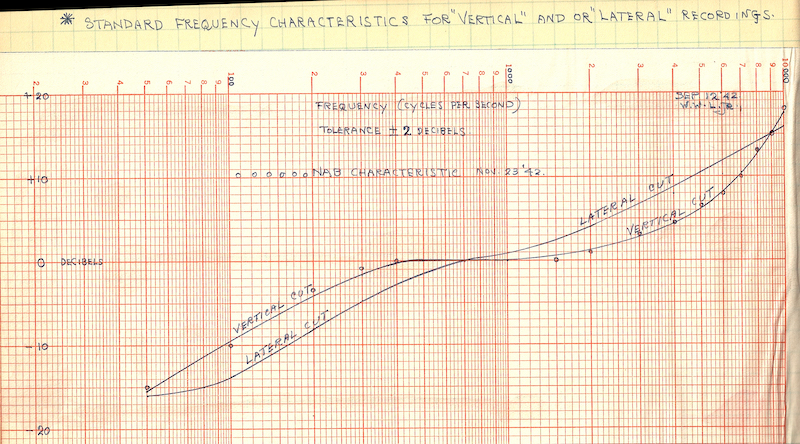
Western Electric Vertical/Lateral Recording Characteristics (1942 NAB), drawn on Nov. 23, 1942
Western Electric 社の縦振動/横振動用録音カーブ (1942 NAB vertical/lateral) をプロットした貴重なグラフ (Nicholas Bergh さん提供)
photo courtesy of Nicholas Bergh.
Pt.4 セクション 4.4.1 に載せた、Nicholas Bergh さん所有のホンモノの縦振動盤用再生イコライザの写真をみても分かる通り、本格的で大掛かりな構造の専用LCR録音再生イコライザが使われていて、特性も横振動盤とは全然違うスロープで急峻な高域プリエンファシスになってるね。これは確かに、現代の可変フォノイコでは正確な再生は無理で、当時の専用品を使うか、回路図を元に再生EQを作り直すかする必要がありそうだね。
As you can see from the photo of Nicholas Bergh’s real reproducing equalizer for vertical records in Pt.4 Section 4.4.1, a full-scale, large-scale structure dedicated LCR recording and reproducing equalizer is used, and its characteristics are completely different from those of lateral records in terms of slope and steep high-frequency pre-emphasis. It is certainly impossible for a modern variable phono preamps to reprodue this accurately, and it would be necessary to use a dedicated product of the time, or to rebuild the dedicated phono preamp based on the circuit diagram.

また 1937年には、モーショナルフィードバック の技術を用いたフラット特性の WE 縦振動盤用カッターヘッドが Bell Labs / Western Electric により発表され、史上初めて録音イコライザがカッターヘッドから完全に独立した例となった( Pt.4 セクション 4.4.2)。
In 1937, Bell Labs / Western Electric introduced a cutterhead for WE vertical discs with flat response characteristics using the motional feedback technique, which was the first example in history where the recording equalizer was completely independent of the cutterhead. ( Pt.4 Section 4.4.2)
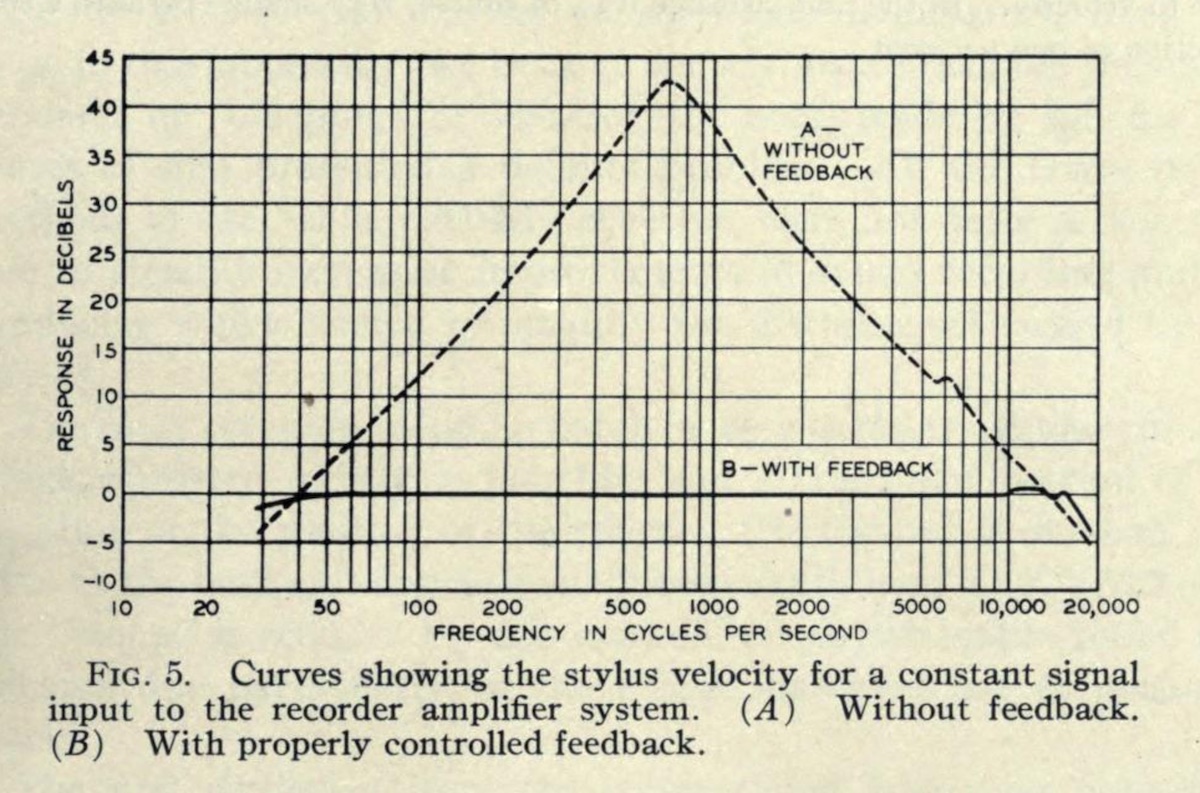
source: “Recent Development in Hill and Dale Recorders”, Journal of the Society of Motion Picture Engineers, January 1938, p.103.
フィードバック回路が備わったカッターヘッドで、フラットな周波数特性での記録が可能に

横振動盤用のフィードバックカッターが米国で初お目見えしたのは1949年、本格的に使われ出したのは1950年代前半だから、10年以上も先駆けていたことになるし、当時の縦振動盤の技術は本当にすごかったんだね。
Feedback cutters for lateral records did not appear until the early 1950s — over ten years — so the technology for vertical records at the time was really astonishing, wasin’t it?
ベル研とストコフスキーの実験的ステレオ録音のエピソードも有名だね( Pt.5 セクション 5.1)。
Also famous is the episode of the experimental stereo recording between Bell Labs and Stokowski ( Pt.5 Section 5.1).


それにしてもベル研って本当に多くの研究開発で貢献していたんだね。
By the way, Bell Labs really contributed in countless research and development efforts.
ベル研は数えきれないほど貢献をしてきたよね。録音再生技術だけではなく、トーキー映画、ファクシミリ、テレビ送受信などもそうだね。さらにコンピュータの発展にも多大な貢献をしていて、リレー式コンピュータの開発、トランジスタやLSIの発明はもとより、ハミング符号やシャノンの暗号理論など、アルゴリズムの世界でも巨大な礎を作ったね。macOS や Linux の源流である UNIX、そしてプログラミング言語 C もベル研で開発されたものだね。
They definitely has made a lot of tremendous contributions. Not only in sound recording/reproducing technology, but also in many fields like “talkie” moving pictures, facsimile technology, television transmittion, and so on. They also made great contributions to the development of computers, including early relay computers, the invention of the transistor and LSI, researches on algorithms such as the Hamming code and Shannon’s theory of cryptography. UNIX (the origin of macOS and Linux) and the programming language C were also developed at Bell Labs.

25.3.2 Pierce & Hunt’s Paper to Prove Superiority of Lateral Recordings
しかし、ハーバード大学の Cruft 研究所の John Alvin Pierce と Frederick Vinton Hunt 両氏により、横振動盤再生時に針が溝底につかず側壁でサポートされている場合、縦振動盤と比べて横振動盤の方が圧倒的に高調波歪が少なくて済むことが1938年の論文で示されたことにより、縦振動盤の優位性が否定されることとなった( Pt.6 セクション 6.2)。
However, a 1938 paper by John Alvin Pierce and Frederick Vinton Hunt of the Cruft Lab at Harvard University showed that when the needle is not on the groove bottom but supported by the side walls during lateral disc playback, the lateral disc has far less harmonic distortion than the vertical disc, negating the superiority of the vertical disc ( Pt.6 Section 6.2).
また両氏は、当時としては画期的に超軽針圧(HP6A は 5g、HP26A は 1g)で再生可能なピックアップ開発も行い、現代に繋がるレコード再生ピックアップ技術の礎 を築いた( Pt.6 セクション 6.3)。
They also developed pickups that could play at revolutionarily ultra-light needle pressure (5 grams for the HP6A, and 1 gram for the HP26A), laying the foundation for the record playback pickup technology that has continued to the present day ( Pt.6 Section 6.3).

このお二人の研究によって、レコード再生技術が圧倒的に進化したんだね。
The research of these two men has led to a tremendousadvancement in record reproducing technology, hasn’t it?
せっかく特許までとったのに、第二次世界大戦時に戦時研究従事のためこの分野から離れ、どこも訴えず、特許も放棄した、ってエピソードがシビレるよね。それにしても、1938年のJSMPE論文とElectronics誌解説記事は大興奮したよ。
It is fascinating to hear the story of how they left the field during World War II to engage in war research, never sued anyone, and abandoned their patents, even though they had already patented the technology. By the way, the 1938 JSMPE paper and the Electronics magazine article really excited me.


どこがそんなに凄いと思ったの?
What did you find so great about it?
だって、秘密主義が当たり前だった当時の蓄音機業界において、数学的・物理学的・科学的に正しく調査研究を行い、それが発表されていたこと。さらにその研究が、横振動盤の優位性を示し、同時に側壁サポートがのちのマイクログルーヴ盤による高品質再生の最も重要な礎の1つになっていること。初めて読んだ時。もう感動で震えが止まらなかったね。両氏には感謝と尊敬しかないよ。
Because, in the phonograph industry at that time, where secrecy was the norm, the research and studies were mathematically, physically, and scientifically appropriate, and they were published. Furthermore, that the research showed the superiority of the lateral discs, and at the same time, that the side wall support was one of the most important cornerstones of the later high quality reproduction with the microgroove discs. When I first read these, I couldn’t stop shaking with emotion. I have nothing but gratitude and respect for both of them.


その「側壁サポート」ってどういうこと?
What does that “side wall support” mean?
かつては、抗摩耗剤入りのザラザラした盤を重い針圧で再生していた。ということは、針がどんどん削れて針の先端が音溝の底に当たった状態で再生される。しかしこれだと、ピンチエフェクト(横振動記録であっても針が上下動する現象)への対応が不十分であり、満足な再生ができない、ってことだね。だから、軽針圧で、針の先端は音溝の底につかず、音溝の側壁と針だけが接してる状態であるのが、横振動盤再生には理想である、更には軽針圧であれば、抗摩耗剤抜きのスムーズな材質でレコードを作ればいいし、その方がもっと高品質な再生ができる、というリクツだね。
In the past, scabrous discs with abrasive agents were played back with heavy needle pressure. This meant that the needle would play back with the tip of the needle hitting the bottom of the groove as the needle was being scraped off. But this also means that the response to the pinch effect (phenomenon in which the needles moves up and down even tracing a lateral groove) is insufficient, and satisfactory playback is not possible. Therefore, Pierce & Hunt concluded that the ideal condition for lateral disc reproduction is that the needle tip does not touch the bottom of the groove, but only the side wall of the groove, under light needle pressure.

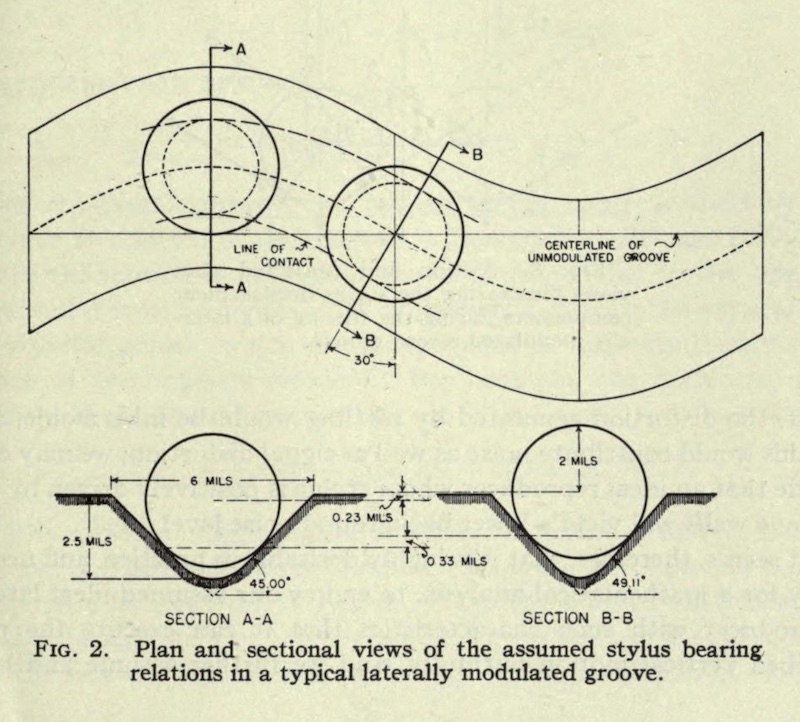
source: “Distortion in Sound Reproduction from Phonograph Records, J.A. Pierce and F.V. Hunt, Journal of the Society of Motion Picture Engineers, Vol. 31, No. 2 (August 1938), p.163
カッターヘッドの形状、進行方向と振幅方向の関係により、音溝に2点で接触する針先の場合、その通過する位置により上下動(ピンチエフェクト)が生じるため、縦方向の柔軟性(コンプライアンス)が必要
Laterally recorded groove creates vertical pinch effects, resulting the necessity of reproducing pickup’s vertical compliance.

針先は溝の底に当たらず、針は溝の側壁のみと接した状態で再生される、かつてはこれが当たり前ではなかったのはびっくり。
The needle tip does not hit the bottom of the groove, the needle is played back in contact only with the side walls of the groove… It is really surprising that this was not the norm in the past.
そうだね。けど Pierce & Hunt の研究によって広く知られるようになり、戦後くらいにはすでに一般的な知見となっていたそうだね。
Yes it is. I heard that it became widely known through the research of Pierce & Hunt, and was already a common knowledge in the postwar period.


なるほど、本当にお二人のおかげで今のレコード再生技術があるわけだね。
I see, so it really is thanks to the both of them that we have the record playing technology we have today.
どこのメーカにもレーベルにも所属しない純粋な研究者だったから可能だったんだろうね。それと、この両者の研究がなければ、縦振動盤は更に生きながらえかもしれない。そうすると、マイクログルーヴ盤登場やステレオLP誕生がもっと遅れていたり、あるいは今とは違うレコード再生の世界になっていたかもしれない。そう考えると、胸アツだね。
I guess it was possible because the both of them were pure researchers who were not affiliated with any manufacturer or label. Also, without the research of Pierce & Hunt, the vertical discs might have survived further. If so, the appearance of the microgroove discs and the birth of the stereo LP might have been delayed, or the world of record and its reproduction might have been different from what it is today. Isn’t it very exciting just to think so?

25.3.3 Lateral Electrical Transcription Discs and “Orthacoustic”
横振動記録のトランスクリプションも多く流通し、当時の民生用レコードより高音質・長時間であったが、録音再生カーブがレーベルによってまちまちであり、同時に企業秘密となっていたため、ラジオ局は正しい再生に苦慮していた。そんな中、RCA Victor / NBC が、横振動トランスクリプション盤用に Orthacoustic 特性カーブ を開発し、1939年に発表した( Pt.5 セクション 5.2.1)。
Lateral transcription discs were also widely distributed and had better sound quality and longer playing time than the consumer records of the time, but the recording / reproducing curves varied from label to label, and at the same time were a trade secret, so radio stations struggled to reproduce them correctly and properly. Under such circumstances, RCA Victor / NBC developed the Orthacoustic characteristics curve for lateral transcription records and announced it in 1939 ( Pt.5 Section 5.2.1).
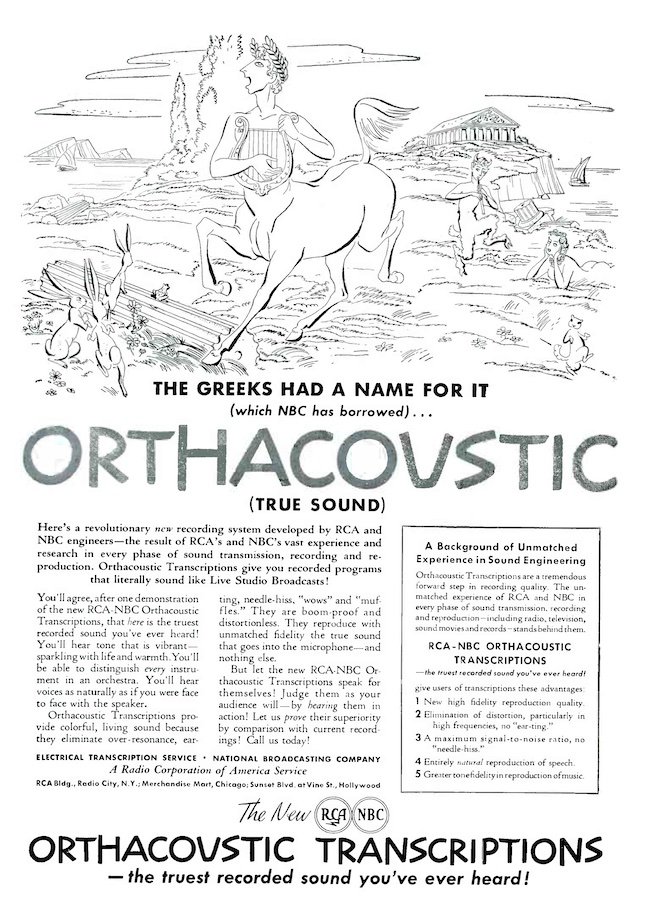
source: Orthacoustic Transcriptions Ad, ATE Journal, December 1939, p.0
ATE Journal 1939年12月号に掲載された Orthacoustic トランスクリプションの広告

ラジオ局用トランスクリプション盤の世界でも、当然横振動盤が多く使われていたんだね。
Naturally, lateral discs were widely used in the world of electrical transcription records as well.
ラジオで民生用78回転盤もトランスクリプション盤もかける場合、再生機器を共通化できるからね。また、トランスクリプション盤を出すレーベルでも、縦振動の Western Electric 派でないところもあったわけで。実際のところは、ラバーラインレコーダの時と同様、Bell Labs / Western Electric の縦振動盤特許を回避するためだったようだね。
When playing both consumer 78 rpm discs and transcription discs on the radio, it was possible to share the same playback equipment. Also, there were some labels that produced transcription discs that were not Western Electric groups with vertical discs. The possible truth would be, as with the “rubberline recorders”, that the adoption of lateral recordings for transcription records was to avoid the Bell Labs / Western Electric’s patent.

この Orthacoustic カーブの高域プリエンファシスは、当時開発中のFM放送で実験用に使われていた 100μs高域プリエンファシス を援用したものであった(のちに米国FM放送のプリエンファシスは75μsと定められた)( Pt.5 セクション 5.2.3)。
The high-frequency pre-emphasis of the Orthacoustic curve was based on the 100μs high-frequency pre-emphasis used experimentally in FM broadcasts under development at the time (the pre-emphasis for U.S. FM broadcast was later set at 75μs) ( Pt.5 Section 5.2.3).

へぇ、ディスク録音カーブのプリエンファシスは、FMラジオのプリエンファシスからヒントを得ていたんだね。
That’s interesting. The pre-emphasis of the disc recording curve was inspired by the pre-emphasis of FM radio!
絶対そうだ、という証拠があるわけではないんだけど、FM放送の開発ペースと、ディスク録音でプリエンファシスが導入された時期が近いこと、また、採用された時定数が100μs/75μs/50μsと、FMで使われていたものと全く一緒であることから、以前からそのように考えられているね。
There is no proof that this is absolutely true, but it has long been tought to be the case because the pace of development of FM broadcasting is close to the time when pre-emphasis was introduced in disc recording, and the time constants used are 100μs / 75μs / 50μs, exactly the same as those used in FM.

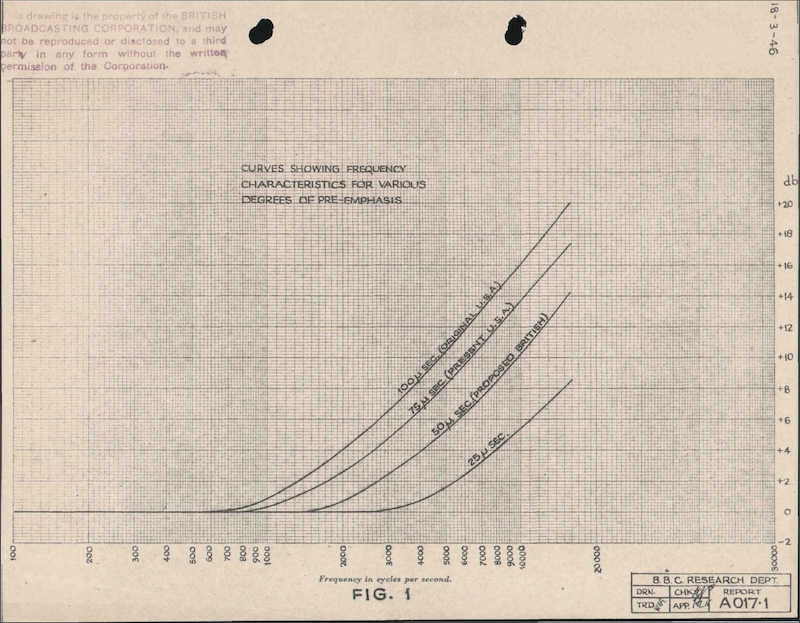
source: BBC Research Department: Frequency Modulation (Report No. A.017, Serial No. 1946/4).
1946年4月にBBC研究部門が発行したレポートより。FM放送における高域プリエンファシスのグラフ。
“100μsec (original U.S.A.)”, “75μsec (present U.S.A.)”, “50μsec (proposed British)” とある。

ところで、さらっと出てきたけど、「μs(マイクロ秒)」って何を表してるの?
By the way, just out of curiosity, what does “μs (microseconds)” stand for?
電子回路における 時定数 の単位だね。RL回路(抵抗とコイル)や RC回路(抵抗とコンデンサ)を使った信号処理系において、周波数応答の特徴を表すために用いられる。例えば、「ターンオーバー 500Hz」(500Hz 以下は定振幅、500Hz 以上は定速度)は、下の計算式のように時定数が 318μs となる。
It is a unit of time constant in electronic circuits and is used to characterize the frequency response in signal processing systems using RL (resistor and inductor) or RC (resistor and capacitor) circuits. For example, “turnover 500Hz” (constant amplitude below 500Hz and constant velocity above 500Hz) has a time constant of 318μs, as shown in the formula below.


なるほど、正直よくわからないけど、ディスク録音再生カーブの特性を正確に表現するパラメータってことかな。
Okay, I honestly don’t understand it, but I guess it’s a parameter that accurately represents the characteristics of the disc recording / reproducing curves, right?
そういうことだね。例えば、現在の RIAA 録音特性を時定数で表すと、ベースシェルフは 3,180μs、ターンオーバーは 318μs、高域プリエンファシスは 75μsとなり、それぞれグラフで表現すると以下のようになるね。この3つを合成したものが RIAA 録音特性ってことだ。
That’s what I mean. FOr example, if we express the current RIAA recording characteristics in terms of time constants, the bass shelf is 3,180μs, turnover is 318μs, and high-frequency pre-emphasis is 75μs, each of which can be graphically represented as follows. The RIAA recording characteristics are the composite of these three.

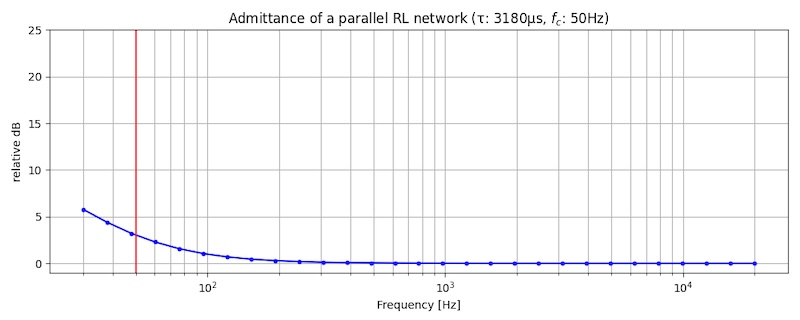
Admittance of a parallel RL network (τ: 3,180μs, fc: 50Hz)
graph plotted using PySpice and Matplotlib.
時定数3,180μs、ターンオーバー周波数 50Hz の並列RL回路のアドミタンス
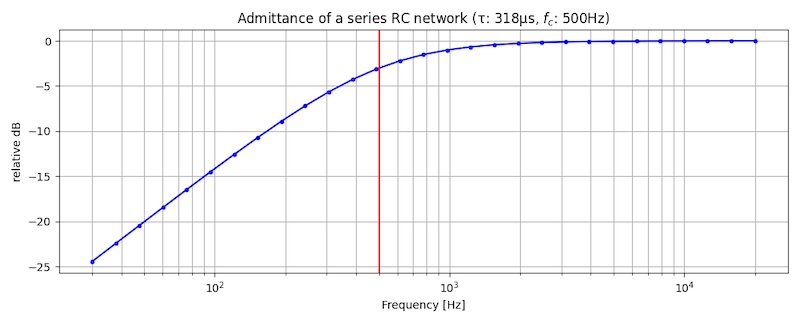
Admittance of a series RC network (τ: 318μs, fc: 500Hz)
graph plotted using PySpice and Matplotlib.
時定数318μs、ターンオーバー周波数 500Hz の直列RC回路のアドミタンス
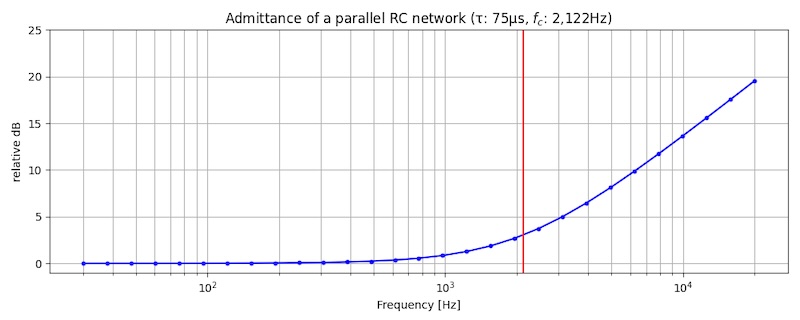
Admittance of a parallel RC network (τ: 75μs, fc: 2,122Hz)
graph plotted using PySpice and Matplotlib.
時定数75μs、ターンオーバー周波数 2,122Hz の並列RC回路のアドミタンス
また、78回転より遅い33⅓回転であったために、ランブルノイズやレコードの反りに敏感であり、それに対応すべく、Orthacoustic はベースシェルフ(低域プリエンファシス)を採用した最初の例となった( Pt.5 セクション 5.2.3)。
Also, because the transcription records were 33⅓ rpm (slower than 78 rpm), it was sensitive to rumble noise and record warping. Orthacoustic was the first to adopt a bass shelf (low-frequency pre-emphasis) to deal with this problem ( Pt.5 Section 5.2.3).

へぇ、Columbia LP カーブや RIAA カーブでお馴染みのベースシェルフは、Orthacoustic トランスクリプション盤の時代に初めて採用されたんだね。
Wow, the bass shelf familar from the Columbia LP curve and RIAA curve was first used in the era of Orthacoustic transcription discs.
78回転から33⅓回転と一気に線速度が遅くなると、ランブルノイズ(ゴロ)が目立ちやすくなるからだね。関係ないけど、LP時代のアンプにもランブルノイズ低減の目的で「サブソニックフィルタ」がついているものがあったよね。
That’s because rumble noise becomes more noticeable when the line speed (linear velocity) slows down from 78 rpm to 33⅓ rpm. On an unrelated topic, some LP-era amplifiers also had “subsonic filters” to reduce rumble noise, right?

Orthacoustic における 500Hz ターンオーバーは、依然としてカッターヘッド自体の特性、および 500Hz ターンオーバーに揃える補正回路、の合計で実現されていた。結果として、Orthacoustic 録音カーブ全体は、カッターヘッドの特性 + それを 500Hz ターンオーバーに微調整する回路 + 100μsプリエンファシスおよび3,180μsベースシェルフの回路、という構成であった( Pt.5 セクション 5.2.3)。
The 500Hz turnover in Orthacoustic was still achieved by the sum of the characteristics of the cutterhead itself, and the correction circuitry to adjust it to 500Hz turnover. As a result, the entire Orthacoustic recording curve consisted of the characteristics of the cutterhead + the circuitry tofine-tune it to 500Hz turnover + 100μs pre-emphasis and 3,180μs bass shelf circuitry ( Pt.5 Section 5.2.3).
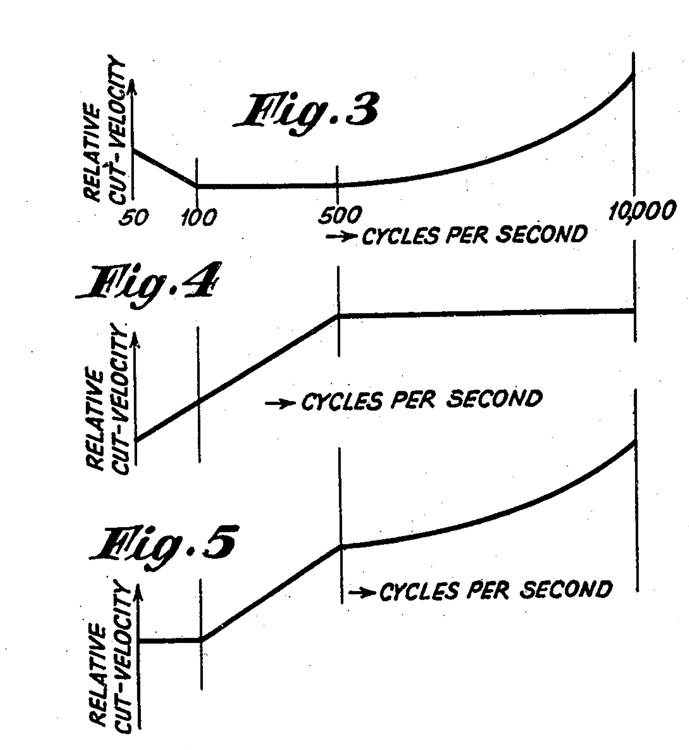
source: “Sound Translating System”, US Patent 2,286,494, Roland A. Lynn & Jarrett L. Hathaway, 1940
Pt. 5 で紹介した、Orthacoustic の特許文書より
Fig.4 がカッターヘッドの電気機械的記録特性(追加で補正回路を使う場合もあり)、
Fig.3 が Orthacoustic プリエンファシスフィルタ(録音イコライザ)特性、
Fig.5 が両者を合計した最終的な記録特性
Fig.4: Cutterhead’s Frequency Response (sometimes accomplished with additional circuits)
Fig.3: Frequency Response of the Orthacoustic pre-emphasis (recording) filter
Fig.5: Final recording characteristics of Orthacoustic, a combination of Fig.4 and Fig.3

この頃もまだ、カッターヘッドの特性がフラットではなかったから、ターンオーバー部分はカッターヘッドが担っていたんだね。
Even at this time, the cutterhead characteristics were not yet flat, so the cutterhead was still responsible for the turnover portion.
まだ横振動盤用のモーショナルフィードバックカッターが存在しなかったからね。だから以前からの伝統に則った方法で録音カーブが設定されていたわけだね。
THere was no motional feedback cutter for lateral cut records yet. So the recording curves had to be set in the traditional way.

この Orthacoustic は、本格的なLCR回路ではなく廉価なRC回路でも「±2dBの誤差の範囲内で」再生可能にすることを念頭にして定義されたものであった( Pt.5 セクション 5.2.3)。これらの技術詳細は推奨回路図込みで公開されたが、企業間の秘密主義が一般的だった当時としては貴重なものであった。
This Orthacoustic was intended to allow reproductin “within ±2dB deviation” with inexpensive RC circuits rather than full-scale LCR circuits ( Pt.5 Section 5.2.3). These technical details were published with recommended circuit diagrams, which were valuable at a time when secrecy among companies was common.

LCR 回路と RC 回路だと周波数特性や位相に微妙に差が出てしまうけど、当時は ±2dB は許される誤差だった、ってことかな。
The LCR and RC circuits have subtle differences in frequency response and phase, but at the same time, ±2dB was an acceptable deviation.
まぁそういうことだね。LCR 回路は、L つまりコイルにコストがかかり、同時に特性を安定させるのが非常に難しいから、歩留まりも悪く、どうしても高価になってしまう。RCA Victor / NBC は、廉価に製造できる RC 回路でも再生可能、と明言することで、気軽に参入可能であることをアピールした、すなわち Orthacoustic の普及を狙っていたのかもしれないね。実際、Orthacoustic の解説論文 (1939) 中でも「録音再生特性の実現を、可能な限りシンプルかつ廉価に行いたい」と書かれてるんだ。
Well, that’s what I mean. LCR circuits are expensive because of the cost of the L (coil) and the difficulty of stabilizing the characteristics, which also results in low yields and high prices. RCA Victor / NBC might have been trying to promote Orthacoustic by stating that RC circuits, which can be manufactured inexpensively, can also be used for reproduction. As a matter of fact, the technical paper (1939) on Orthacoustic reads: “a desire to achieve the recording and compensating characteristics as simply and economically as possible”.


なるほどね。低コストであれば、採用してくれるところも増えるしね。
I see. If it were low-cost, there would be more studios and radio stations willing to adopt it.
±2dBにした他の理由として、当時は再生用ピックアップの応答特性も千差万別だったから、というのもあるね。そのほかには、近似した録音特性を採用しているスタジオであれば、±2dB の範囲内だから録音イコライザの改造や新調にコストをかけず現状維持でもオッケー、というのも狙ってた可能性も考えられるね。その緩さ、あるいは柔軟性のおかげで、1942年NAB規格として Orthacoustic 特性が採用されたのかもしれないね。
Another possible reason for the ±2dB deviation is that the response characteristics of playback pickups varied widely at that time. Another possibility is, if the studios employed a recording characteristic that was close to the Orthacoustic within the ±2dB deviation, the studios could have maintained the recording equalizers as they were, without the cost of modifying or replacing the equalizers. This looseness or flexibility may have led to the adoption of Orthacoustic characteristics as the 1942 NAB Standard.

25.4 Pre-emphasis with consumer 78rpms
高域プリエンファシスの適用が、米国の民生用レコードにも進んでいった流れについて。そして、ワックス盤ではなくラッカー盤にカットする、アセテート録音機が登場し、オープンリールテープ登場までの間、即時再生用のディスク録音が徐々に普及した流れも。1930年代〜1940年代前半あたりの話です。
Next is the trend toward the application of high-frequency pre-emphasis to consumer records in the United States, as well as the trend toward the gradual spread of instantaneous disc recorders, until the advent of reel-to-reel tape recorders. The timespan is approximately from the 1930s to the early 1940s.
25.4.1 RCA Victor’s Compensator Circuit for Home Domestic Recordings (1940)
放送局用トランスクリプション盤に続き、民生用レコード(78回転盤)のカッティングにおいても、500Hzターンオーバー特性のカッターヘッドの後段への自社製高域プリエンファシス回路の追加が1930年代末頃から行われるようになった。ただし、ベースシェルフの採用はまだだった。
Following broadcast transcription records, the addition of in-house high-frequency pre-emphasis circuits to the rear stage of the cutter head with 500Hz turnover characteristics began in the late 1930s for cutting of records for consumer use (78 rpm discs). However, the bass shelf had not yet been adopted.
RCA Victor の1940年当時の社内技術文書で回路図とグラフが現存しており、当時の RCA Victor の民生用78回転レコードの高域プリエンファシスは LCR 回路ではなく RC 回路で構成されていることが確認できる( 2022 ARSC Conference における Nicholas Bergh 氏の発表スライド、ARSC 会員のみ閲覧可能)( “Master Reference Book for Disc Recording”, RCA Manufacturing Company, Inc., February 1940)。
RCA Victor’s internal technical documents from 1940 with surviving schematics and graphs confirm that the high-frequency pre-emphasis circuit for RCA Victor’s consumer 78rpms at that time consisted of an RC circuit, not an LCR circuit ( slides presented by Nicholas Bergh at the 2022 ARSC Conference, available only to ARSC members) ( “Master Reference Book for Disc Recording”, RCA Manufacturing Company, Inc., February 1940).
他レーベルにおいてもおそらくは、同様に高域プリエンファシス追加の取り組みが行われていたと考えられる。しかし、技術資料がほとんど残っていないため、または公になっていないため、正確なパラメータなどは不明である。よって、出回っているカーブ一覧表は試聴による主観判断によるものがほとんどであると考えられる。
Other labels probably made similar efforts to add high-frequency pre-emphasis, but since few technical documents remain or have been made public, the exact parameters are unknown. Therefore, it is believed that most of the curve lists that are available are based on subjective judgements based on through listening.
25.4.2 Instantaneous Disc Recorders and Cutterhead Characteristics
1934年の Presto 6D アセテート録音機、1941年の Presto 6N アセテート録音機は大ヒットとなり、レコード制作目的のフィールドレコーディングに用いられたほか、熱狂的なアマチュアにも録音手段がもたらされることとなった( Pt.6 セクション 6.1)。Alan Lomax による有名な膨大なフィールドレコーディングも Presto 6D で行われた。
Presto’s instantaneous disc recorders, such as Presto 6D (1934) and Presto 6N (1941) were big hits, used for field recording for record production purposes, and also providing a means of recording for enthusiastic amateurs ( Pt.6 Section 6.1). Alan Lomax’s famous voluminous field recordings were also made on the Presto 6D.

そういえば、「アセテート盤」ってよく呼ばれるけど、正確にはニトロセルロースをアルミニウム円盤に塗布した「ラッカー盤」が正確なんだよね。
Oh, by the way, they often call it an “acetate disc”, but the exact term is “lacquer disc”, which is an alminium disc coated with cellulose nitrate.
上で紹介した Bell Labs / Western Electric の縦振動盤が当初はセルロースアセテート製だったから、または最初期のラッカー盤はセルロースアセテート製だったから、そのコトバだけが残ったという説もあるみたいだね( Pt.6 セクション 6.1)。一方、少なくとも日本では、即時録音再生メディアとして「アセテート盤」、プレスマスターとして「ラッカー盤」、と区別して使用しているかもしれないね。
There seems to be a theory that, because the vertical records by Bell Labs / Western Electric (mentioned above) was initially made of cellulose acetate, or because the very early lacquer discs were made of cellulose acetate, the word “acetate” remained for naming “lacquer” ( Pt.6 Section 6.1). On the other hand, at least in Japan, cellulose nitrate discs may be called as “acetate discs” when used for instantaenous recording; “lacquer discs” when used for press masters.

このアセテート録音機用のカッターヘッド、Presto 1-B / 1-C / 1-D は、民生用レコードカッティング用にも広く使われた。その応答特性や補正回路も資料が多く残されており、民生用レコード用スタジオ録音システムと同様、カッターヘッドの特性に補正回路を加えて500Hzターンオーバーを実現し使用されていたことが確認できる( Pt.6 セクション 6.1.1)。アマチュアやセミプロは、ターンオーバー500Hz、高域プリエンファシスなし、という録音特性を使っていた。
The Presto 1-B / 1-C / 1-D cutterheads for instantaneous disc recorders were also widely used for consumer record cutting. Many documents have survived that show the response characteristics and correction circuits of the Presto cutterheads, confirming that they were used in the same way as studio recording systems for consumer records, with a 500Hz turnover achieved by adding a correction circuit to the cutterhead characteristics ( Pt.6 Section 6.1.1). Most amateurs and semi-professionals used recording characteristics with a turnover of 500Hz and no high-frequency pre-emphasis.

なるほど、カッターヘッドの裸特性は 500N-FLAT じゃなかったんだね。
Hmmm, the bare characteristic of the cutterhead was not 500N-FLAT.
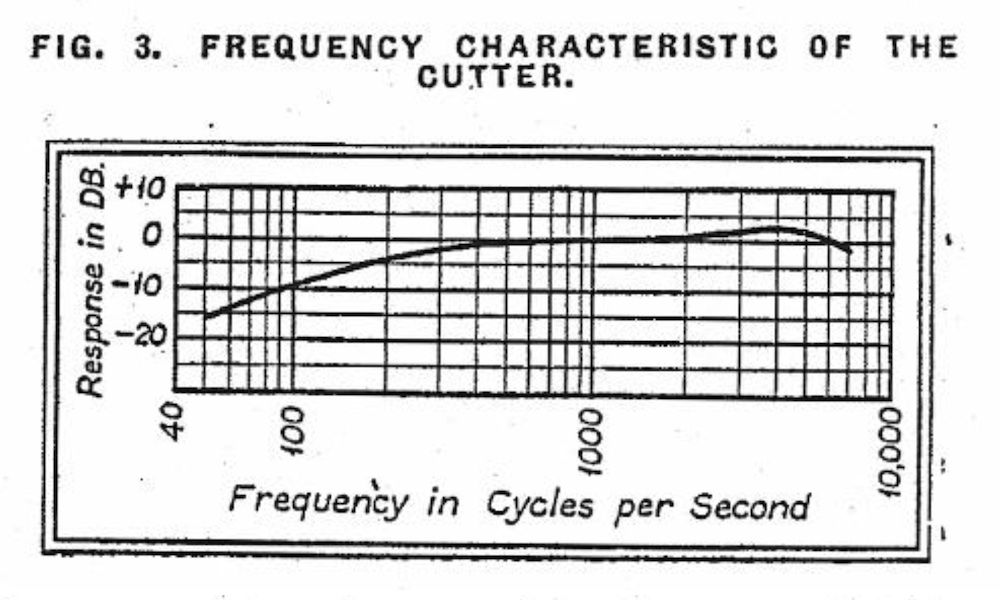
source: “An Instantaneous Recording Head”, George J. Saliba, Communication and Broadcast Engineering, March 1937 (archived at World Radio History), p.8
Presto チーフエンジニアによる、1-B カッターヘッドについての解説記事
1-B technical article, authored by the Presto’s chief engineer
そうだね。これに簡単な補正回路を足して、500N-FLAT を達成していたんだね。
That’s right. Then a simple correction circuit was added to achieve 500N-FLAT.

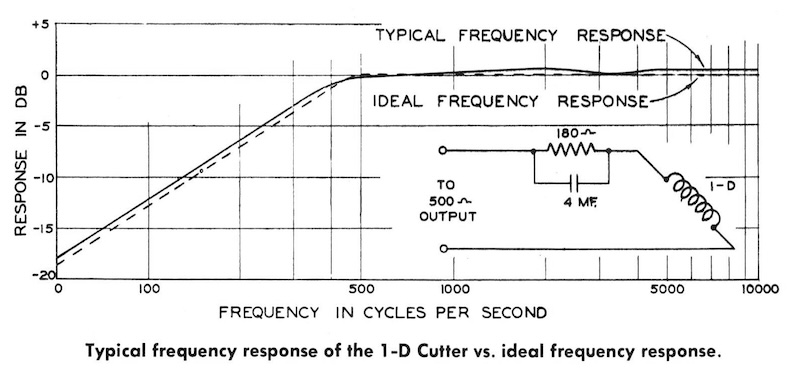
Typical frequency response of the 1-D Cutter (with a simple RC network)
source: Presto Recording Corp. 1948 Catalog, p.19
簡単なRC回路で補正してターンオーバー500Hz、6dB/オクターブスロープを実現
米国の民生用レコードレーベルは、社外秘の独自の録音特性を使っていたと言われているが、RCA Victor などごく一部のレーベル以外、なんの資料も残っていない(または公になっていない)ため、確認できない。ただ、民生用レコードのカッティングで Sculley カッティングレースと Presto カッターヘッドを組み合わせていたスタジオは多く確認されている( Pt.6 セクション 6.1.2)。
It is said that U.S. consumer record labels used their own proprietary recording characteristics that were kept secret from the public, but this cannot be confirmed because no documentation has survived (or is not publicly available), except for a few labels such as RCA Victor. However, many studios are known to have used a combination of Sculley cutting lathes and Presto cutterheads for cutting consumer records ( Pt.6 Section 6.1.2).
さらに、特にクラシック音楽では、ターンオーバーを最大 1,000Hz にまでひきあげ、記録可能な周波数帯域を競っていた一部のレーベルがある、という当時の噂話、さらには 3kHz 近辺を意図的に盛り上げた録音をするレーベルを評して「高域を強調すれば廉価な再生機でキンキン聞こえて良い、というインチキハイファイが始まった」と苦言を述べる1944年当時の評論記事もある( Pt.9 セクション 9.2.1)。しかし、こういった録音特性について公になった情報はなにもなく、また当時の民生用再生機器にはせいぜいトーンコントロールやスクラッチノイズ低減用の高域アッティネータ程度しか存在しなかったため、正しい特性で再生する以前の問題であった。
In addition, it is possible to confirm the rumor of the time that some labels were competing for recordable frequency bandwidth by raising the turnover to a maximum of 1,000Hz, especially for classical music. Furthermore, there is an article from 1944 in which a critic complained about some labels that intentionally boosted the frequency range around 3kHz, saying “‘phony high fidelity’ with a spurious brilliance that sounded ‘nice’ on the cheap sets” ( Pt.9 Section 9.2.1). However, there was no public information about such recording characteristics, and consumer playback equipment at that time had only tone controls and a high-frequency attenuator to reduce scratch noise at best. So the situation at the time was far from “high fidelity with correct response characteristics”.

この話がホントなのかどうかは確認のしようがないけど、一部のレーベルではかなりテキトーに録音特性をいじってたってことなのかな。
There is no way to confirm whether this story is true or not, but I wonder if it means that some labels were actually tweaking the recording characteristics in a very unorthodox way.
そうだね。業界での標準的な規格もなかった時代、再生機器側も十分な対応がとれなかった時代、民生用では忠実再生なんてまだ夢だった時代だからね。ある意味では、このターンオーバーを競っていたさまは(もし本当にそんなことが行われていたのであれば)、20世紀末〜21世紀初頭の「ラウドネス・ウォー」(音圧競争)に似てる気もするね。
It may be so, or may not. Anyway, it was a time when there were no industry standards, when playback equipment could not adequately respond, and when faithful reproduction was still a dream for consumer use. In a sense, this competition for the turnover (if it really existed) seems similar to the “loudness wars” of the late 20th and early 21st centuries.

一方、英国や欧州では、先述の通り 250Hz ターンオーバー、高域プリエンファシスなし、という録音特性が、比較的後年まで一般的であった。
On the other hand, in the U.K. and Europe, the recording characteristics of 250Hz turnover and no high-frequency pre-emphasis, as mentioned above, were common until relatively later years.
25.5 Piezoelectric Pickups and its Reproducing Characteristics
定速度特性のマグネットカートリッジとは異なる定振幅特性を備えた圧電式カートリッジが登場、ジュークボックスや廉価な民生用再生機器で一気に普及した流れについて。ふたたび1930年代〜1940年代前半あたりの話です。
This section deals with the emergence of piezoelectric pickups with constant amplitude characteristics that differ from magnetic pickups with constant velocity characteristics, and a trend that quickly spread to jukeboxes and inexpensive consumer playback equipment. The timespan is, again, approximately from the 1930s to the early 1940s.
25.5.1 Birth of Piezoelectric Pickups
1930年代前半にクリスタルカートリッジに代表される圧電式カートリッジが登場、ジュークボックス市場の発展とあわせるかのように一気に普及が進み、民生用の再生システムで長らく主流となった( Pt.7 セクション 7.1)。
In the early 1930s, piezoelectric pickups, as represented by crystal cartridges, were introduced, and their use spread rapidly, as did the development of the jukebox market, and they remained the mainstream in consumer playback systems for a long time ( Pt.7 Section 7.1).

そういえば、あの Shure って、元々は圧電式装置を積極的に開発していたんだよね。
Come to think of it, that Shure company was originally actively developing piezoelectric devices, wasn’t it?
Shure Brothers 社は、圧電素子関連の特許を持つ Brush Development と協力して、1933年にOEM用のクリスタルカートリッジを製造、1935年には Model 70 / 71 クリスタルマイクをラインアップに追加、その後も戦前は圧電式装置を製品ラインアップのメインにしていたみたいだね。
Yes. The Shure Brothers Company, in cooperation with Brush Development, which held patents related to piezoelectric elements, produced crystal cartridges for OEM use in 1933, added the Model 70 / 71 crystal microphones to its lineup in 1935. Shure continued to make piezoelectric devices a main part of its product lineup during the prewar period.

圧電式ピックアップは定振幅特性であり、ターンオーバーより下は定振幅記録、ターンオーバーより上は定速度記録、および高域プリエンファシス、という通常のディスク録音特性とは異なる。しかし、マグネットカートリッジより出力電圧が非常に大きく、かつ再生イコライザなしで(あるいはほんの少しの補正回路だけで)「そこそこいい感じで」再生されるため、廉価なこともあり非常に重宝された( Pt.7 セクション 7.1.4)。
Piezoelectric pickups have constant amplitude characteristics, which is different from the usual disc recording characteristics of “constant amplitude below turnover frequency, constant velocity above turnover, plus high-frequency pre-emphasis”. However, the output voltage is much higher than that of magnet cartridges, and the playback is “reasonably good and acceptable” without a playback equalizer (or with only a little correction circuitry), so they were very useful due to their low price ( Pt.7 Section 7.1.4).
圧電素子ブームも後押しし、一時期は圧電式カッターヘッドも登場するなど、レコードの記録再生特性を全周波数帯域で定振幅にする、という提案が一部で試みられた( Pt.7 セクション 7.1.4)。
The piezoelectric element boom also encouraged the appearance of piezoelectric cutterheads, and for a while, some companies tried to propose that the recording and playback characteristics of records be constant amplitude over the entire frequency range ( Pt.7 Section 7.1.4).

つまり、これが圧電式カッターヘッドの理想的な記録特性で…
So, below is the ideal recording characteristics of the piezo-electric cutterhead…
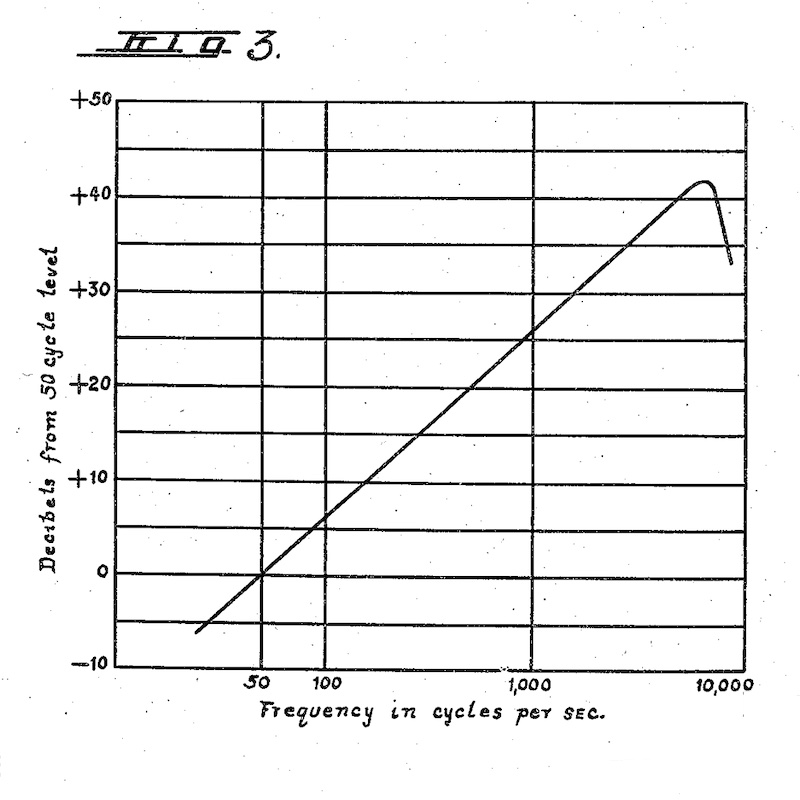
source: “Sound recording and reproducing system”, US Patent 2,139,916, by Stuart W. Seeley.
定振幅 (constant amplitude) で盤に記録する際の周波数特性グラフ
この特性で記録された盤を圧電式ピックアップで再生するとフラットレスポンスになる
Frequency response of the disc recorded with constant amplitude characteristic
そう、そしてこれが圧電式ピックアップの再生特性だね。
And below is the reproducing characteristics of the piezo-electric pickup.

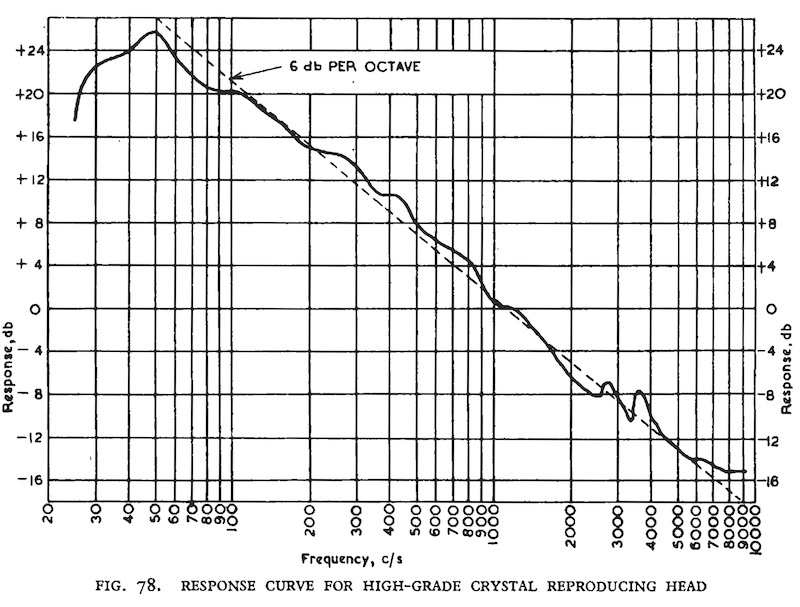
source: “BBC Recording Training Manual”, 1953, p.89.
1950年発行のBBC社員向けトレーニングマニュアルに掲載された、高性能クリスタルピックアップの再生特性
しかし、圧電式ピックアップが温度・湿度変化に弱いこと、全周波数帯域で定振幅にすると高域増幅が過剰になりすぎてカッティング時の問題が多いことなど( Pt.7 セクション 7.1.5)から、最終的には「廉価な再生装置」としての地位に落ち着き、1930〜1970年代の一般リスナーのシステムで大いに普及した。
However, because piezoelectric pickups are susceptible to changes in temperature and humidity, and because constant amplitude over the entire frequency range causes excessive high-frequency amplification and many problems during cutting ( Pt.7 Section 7.1.5), piezoelectric pickups eventually settled on their position as “low-cost reproduction equipment” and became very popular in general listening systems from the 1930s through the 1970s.

放送局などのプロフェッショナルユースやハイファイマニア、そういったシリアスなユーザ以外の一般リスナーの間では、クリスタルカートリッジ/セラミックカートリッジなどの圧電式ピックアップが長らく主流だったんだね。
Aside from professional users such as broadcasting stations and serious users such as Hi-Fi enthusiasts, piezo-electric pickups (crystal/ceramic cartridges) have long been the mainstream among casual general listeners.
そうだね。なによりマグネットピックアップに比べて出力が非常に大きいし、そのままライン入力できる(あるいはごく簡単な補正回路をはさむだけで済む)から、一般リスナー向けに廉価な再生機器を提供できるからね。
That’s right. Compared to magnetic pickups, its output voltage is much higher, and its output can be directly connected into the line input (or with a very simple compensation circuit), making it possible to provide inexpensive playback equipment for general listeners.


なるほどね。正確な再生特性にはならないけど、フォノイコなしで「そこそこ」再生できる、ってのは当時の大半のリスナーにとっては十分ってことだね。
I see. it doesn’t have exact reproducing characteristics, but it can reproduce “reasonably well” without a phono compensation circuit, which is good enough for most listeners at that time.
そういえば、1948年6月18日、Columbia がマイクログルーヴLPレコードを世界初お目見えした際、同時発表された世界初のLPプレーヤ、Philco M-15 Album-Length Record Player にも、圧電式クリスタルカートリッジが装着されていたんだ( Pt.11 セクション 11.1.3)。なんとその Philco M-15 のデッドストック新品と全付属品 を紹介する動画が YouTube にあるね。
By the way, the Philco M-15 Album-Length Record Player, the world’s first LP player, was also equipped with a piezoelectric crystal pickup. It was unvailed at the same time when the Columbia introduced the Long Playing Microgroove Record for the first time on June 18, 1948 ( Pt.11 Section 11.1.3). Surprisingly, there’s a YouTube video introducing a new old stock of Philco M-15 Player.

25.6 NAB Standards (1942) and Sapphire Club in the WWII Era
1939年頃から議論が行われ、放送局用トランスクリプション盤専用とはいえ、米国で初めてディスク録音カーブを含む標準規格が NAB によって1942年5月に策定された流れ、そして同時に第二次世界大戦中、民生用レコードの方でも、企業やレーベルの壁を超えて技術協力体制が整い出していった流れについて。1940年代前半、第二次世界大戦前後の話です。
This section deals with the trend that began around 1939, when the first U.S. Standard including disc recording curve was established by NAB in May 1942, even though it was only for bradcast transcription discs. And also the trend during the World War II, technical cooperation among companies and labels began to develop in the field of consumer records. The timespan is approximately in the early 1940s, before and after the World War II.
25.6.1 NAB Standards (1942/1949) for Transcription Discs
横振動トランスクリプション盤の録音特性がバラバラであることでラジオ局は大変な苦労をしていたため、規格標準化が求められていた。
Radio stations were experiencing great difficulties due to the disparate recording characteristics of lateral transcription records, and tehre was a need for standardization.
そこで NAB (National Association of Broadcasters, 全米放送事業者協会)が主体となって、ディスク録音技術の標準化のため、技術調査・検討委員会が複数構成され、1941年〜1942年に度重なる会合で議論が行われていたことが、当時の機関誌 NAB Reports の記事で確認できる( Pt.8 全体)。この議論には、放送局、レーベル、スタジオ、機器製造メーカなど、幅広いメンバ(1941年8月時点で58名)が参加していた( Pt.8 セクション 8.1.5)。
The National Association of Broadcasters (NAB) took the lead in forming a number of technical research and study committees to standardize disc recording technology, and repeated meetings were held from 1941 to 1942 to discuss the issue, as confirmed in an article in NAB Reports, the journal of the time ( Pt.8). The discussions were attended by a wide range of engineers (58 as of August 1941) from related industries, including broadcasters, labels, studios, and equipment manufacturers ( Pt.8 Section 8.1.5).

プロフェッショナル用途のトランスクリプション盤の世界でも、当初は記録特性の混乱があったんだね。
Even in the world of transcription discs for professional use, there was some confusion about recording characteristics in the beginning!
1941年、NAB が全米の放送局にアンケートをとった結果、最大10種類の再生イコライザ設定が必要とされていることが判明した(これでも対応が不十分)、って報告されているね( Pt.8 セクション 8.1.2)。とはいえ先述の通り、縦振動トランスクリプション盤の録音再生特性は1種類だったんだけど。
In 1941, it was reported that NAB surveyed broadcasters across the U.S. and found that up to 10 different reproducing equalizer settings were required (which still wasn’t enough) ( Pt.8 Section 8.1.2), while there was one recording / reproducing characteristic for the vertical transcription records though, as mentioned earlier.

NAB Reports の報告を時系列に追っていくと、業界に広くアンケートをとり( Pt.8 セクション 8.1.4)、専門的な技術研究者によって議論が行われ( Pt.8 セクション 8.1.9)、各企業の思惑やこだわりを超えて、放送業界一体となって民主的に標準規格化作業が行われたことが確認できる( Pt.8 セクション 8.1.13)。
Following the chronological order of the NAB Reports article, it can be confirmed that the industry was widely surveyed ( Pt.8 Section 8.1.4), that discussions were held by specialized technical researchers ( Pt.8 Section 8.1.9), and that the standardization work was conducted democratically by the broadcast industry as a whole, transcending the agendas and concerns of individual companies ( Pt.8 Section 8.1.13).
ちょうど第二次世界大戦に突入し、米国でも戦時研究が優先されるようになったため、全項目の議論と策定は戦後にまわすこととして、最低限必須とみなされた16項目が急ぎ1942年5月頃に 1942 NAB 標準規格 として策定され、1942年8月発行の IRE(Institude of Radio Engineers, 無線学会)論文誌に掲載された( Pt.8 セクション 8.1.13)。その後、戦時中は委員会審議が中断していた( Pt.8 セクション 8.1.11)。
With the entry into World War II, wartime research became a priority in the U.S., so the discussion and formulation of all items were postponed until after the war, and the minimum 16 items deemed essential were hastily formulated into a standard around May 1942. The 1942 NAB Standards was published in the August 1942 issue of the Institute of Radio Engineers (IRE) Journal ( Pt.8 Section 8.1.13). Subsequently, committee deliberation were suspended during the war ( Pt.8 Section 8.1.11).
録音特性の標準化は議論伯仲したが、どのように伯仲したかの記録は公になっていない。ともあれ、結果として、RCA Victor / NBC の Orthacoustic が横振動盤用に、Bell Labs / Western Electric の特性が縦振動盤用に、それぞれ採用された( Pt.8 セクション 8.2)。ただし、録音特性は、周波数グラフプロットのみの提示で、細かいパラメータなどは何も記載されていない。
The standardization of recording characteristics was a contentious issue, but there is no public record of how it was resolved. As a result, RCA Victor / NBC’s Orthacoustic was adopted for lateral discs, and Bell Labs / Western Electric’s characteristics was adopted for vertical discs ( Pt.8 Section 8.2). However, the recording characteristics are presented only as frequency graph plots, with no detailed parameters or anything else.

録音特性はグラフプロットのみでの提示だったんだ。
Recording characteristics were presented only as a graph plot!
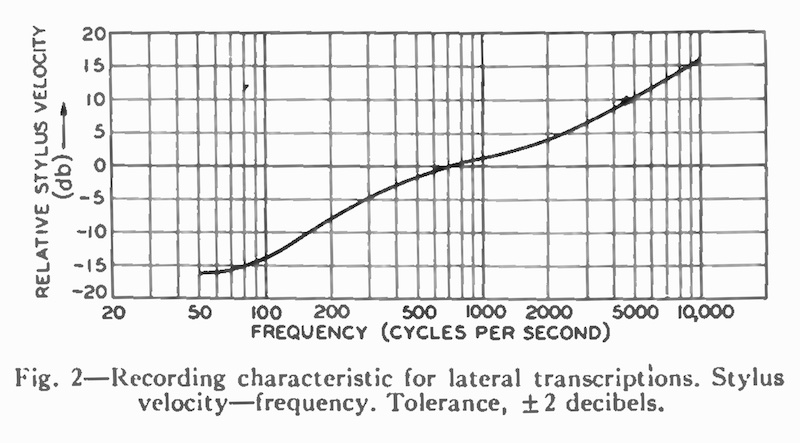
source: “Recording and Reproducing Standards”, Proceedings of the I.R.E., August 1942, Vol.30, No.8, pp.355-356
1942年NAB録音・再生標準規格の第13項目として定義された、横振動用録音周波数特性グラフ
推奨回路図とかも公式には公開されていなかったから、当時の現場のエンジニアは、グラフとにらめっこしながら、実現する回路を考えたりしていたのかもしれないね。
Recommended schematics were not officially published, so engineers in the field at that time were probably staring at graphs while trying to figure out the circuits to be realized.

第二次大戦後、標準化の作業が再開し、1949年4月に 1949 NAB 標準規格 が承認されたが、当時急速に普及していたテープ機器(下の セクション 25.7.2 も参照)に関する規格策定が優先されたため、ディスク録音再生規格については1942年版を踏襲するものであった( Pt.10 全体)。
After World War II, standardization work resumed, and in April 1949, 1949 NAB Standards was approved. Because priority was given to the development of standards for tape equipment (which was rapidly becoming popular at the time) (see also: Section 25.7.2 far below), and the disc recording and reproducing standards adhered fundamentally to those of the 1942 version ( Pt.10).
ただし、この作業の過程で、100μsの高域プリエンファシスが強すぎトレーシング歪や高域歪が増加しているから、せめて米国FM放送と同じ75μsに下げるべきだ、という意見が多くのエンジニアや研究者から盛んに出されていたことは特筆すべき点である( Pt.10 セクション 10.1.3 その他)。この議論のおかげで、のちの1953年 NARTB (NAB の当時の名称) 標準規格において、75μsプリエンファシスに変更されたという経緯がある。
It should be noted, however, that during the process of this work, many engineers and researchers actively voiced the opinion that the high-frequency pre-emphasis of 100μs was too strong and increased tracing distortion and high-frequency distorton, and that it should be lowered to 75μs, the same as that of U.S. FM broadcasting ( Pt.10 Section 10.1.3, etc.). Thanks to the debate, the 75μs pre-emphasis was later adopted in the 1953 NARTB (the then name of NAB) Standards.

この「100μsは過剰である」という意見が多数出されていた、ってのは、今回の歴史探究の大きな収穫のひとつだったね。
This “100μs is excessive” opinion that was expressed by many were one of the major takeaways from our historical exploration.
そうだね。ステレオLP時代でも Columbia LP カーブでカッティングされていた、なんてことはありえない、ってことを裏付ける情報とも言えるね。
Yes, I agree. I think this information confirms that fact that it is impossible that the LPs were cut with Columbia LP curve even in the stereo LP era.


ちなみに、1942/1949 NAB 標準規格では、定義された周波数帯域は後年より狭かったんだよね。
By the way, in the 1942/1949 Standards, the frequency range defined were narrower than in later years.
この頃はまだ 50Hz〜10,000Hz の定義域だったね。1951 AES / 1953 NARTB / 1954 新 AES / 1954 RIAA では 30Hz〜15,000Hz まで拡大された。
At that time, the definition range was still 50Hz to 10,000Hz, while the 1951 AES / 1953 NARTB / 1954 New AES / 1954 RIAA expanded the range to 30Hz to 15,000Hz.

当時はまだホットスタイラス方式のカッターが存在せず、線速度の遅い33⅓回転では内周で高域が十分にカッティングできなかったため、100μsという強めの高域プリエンファシスをかけていた、という事情もあった。そのため、カッターヘッドが内周に向かえば向かうほど、高域プリエンファシスをさらに強くかける、という自動補正イコライザ(Automatic Diameter Equalizer)も一般的に使用されていた( Pt.17 セクション 17.3.3 コラム)。
At that time, hot stylus cutters did not yet exist, and the slow 33⅓rpm linear velocity did not allow for sufficient high-frequency cutting on the inner circumference, so a strong high-frequency pre-emphasis of 100μs was applied. Therefore, an Automatic Diameter Equalizer was also commonly used, which applied a stronger high-frequency pre-emphasis as the cutterhead moved toward the inner circumference ( Pt.17 Section 17.3.3 Column).

その「ホットスタイラス」方式ってのは?
What’s that “hot stylus” method?
その名の通り、スタイラス、つまりカッター針を電熱線で加熱しながらカッティングする方法のことだね。バニシングファセットのないカッター針でラッカー盤にカッティングするとS/N比がとても悪くなる、しかしバニシングファセットありにすると高域損失が増大してしまう。当時のエンジニアはこのジレンマに悩まされていたんだけど、ホットスタイラス方式だとS/N比劣化と高域損失を共に抑制できる。これに気付いた Columbia の William S. Bachman 氏が LP カッティングに採用したんだ。そしてこの方式がマイクログルーヴ時代の一般的なプラクティスになった、というわけだね。
As the name suggests, it is a method of cutting while heating the cutting stylus with an electric heating wire. Cutting a lacquer disc with a cutter needle without burniching facet results in a very poor signal-to-noise ratio, but with a burnishing facet, the loss of high-frequency increases. Engineers at that time were troubled by this dilemma, but with the hot stylus method, both the S/N ratio deterioration and the loss of high-frequency could be suppressed. William S. Bachman of Columbia Records realized this and adopted this method for LP cutting. This method then became a common practice in the microgroove era.


ふむ、下の図の 1a と 1b の部分がバニシングファセットか。
Hmm, the 1a and 1b in the figure below are burnishing facets.
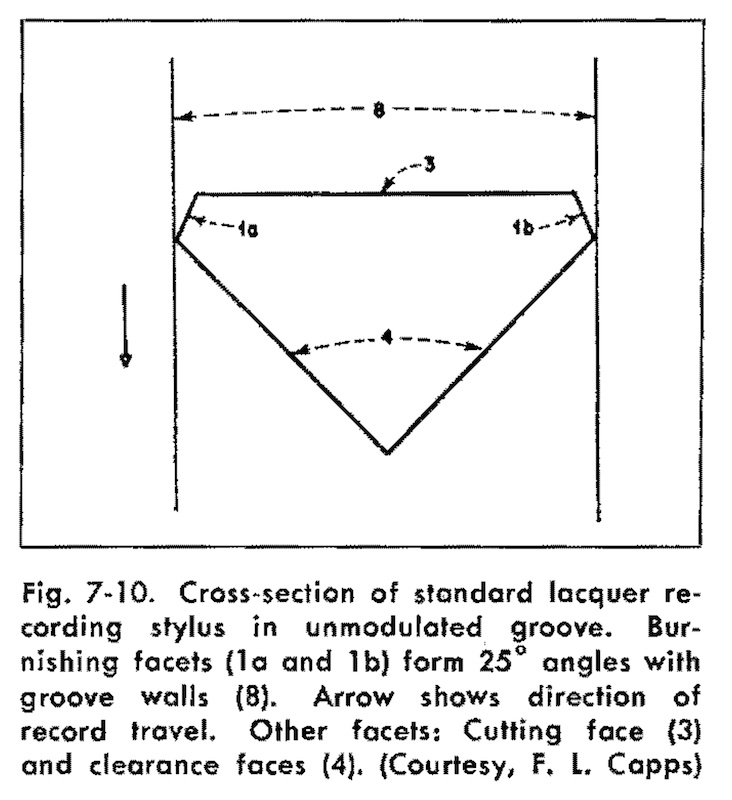
source: “The Recording and Reproduction of Sound”, Oliver Read, 2nd Edition, 1952, p.113
バニシングファセットがないと、ラッカー盤とカッター針の抵抗が大きすぎて、カットされた溝の側壁がザラつき、S/N比が低下する。かといってバニシングファセットを広くしすぎると、細かい溝が刻みにくい、すなわち高域が十分にカッティングできなくなる。このバランスをとるのが難しかったということだね。ホットスタイラス方式が実現してからは、バニシングファセットを最小にしても S/N比を高くとれ、同時に高域まで微細にカッティングできるようになったんだ。
Without a burnishing facet, the resistance between the lacquer disc and the cutter needle is too great, causing the sidewalls of the cut grooves to be rough and lowering the signal-to-noise ratio. On the other hand, if the burnishing facet is made too wide, it is difficult to cut fine grooves, i.e. the high-frequency range cannot be cut sufficiently. It was difficult to strike a balance between the two. After the hot stylus method was realized, it became possible to achieve a high S/N ratio even with a minimum burnishing facet, and at the same time, it became possible to cut high frequencies in fine increments.

25.6.2 Sapphire Group
第二次世界大戦中、米国では多くの原材料が軍需優先物質となり、レコード業界も影響を受けていた。また、レコードの重要な原材料であるシェラックは、東南アジアや南アジアが主たる原産地であり、大戦中日本が進出していたため、シェラック不足の危機が訪れた( Pt.16 セクション 16.2.1)。これにより、シェラックの代替となる合成樹脂の開発が加速し、戦後のポリ塩化ビニル製レコードが実現した側面もある。
During the World War II, many raw materials became wartime priority materials in the U.S., and the record industry was also affected. In addition, shellac, an important raw material for phonograph records, was mainly originated in Southeast and South Asia, and Japan’s expansion during the war led to a shellac shortage ( Pt.16 Section 16.2.1). This accelerated the development of synthetic resins to replace shellac, and in some aspects, polyvinyl chloride (PVC) records were realized in the postwar period.
門外不出の企業秘密で技術を囲い込み、他社をライバル視していた各社だったが、シェラック、モンタンワックス、アルミニウム、真空管などが不足する状況を共同で解決すべく、各レーベルのエンジニアたちが定期的に会合を開き、ラッカー盤や真空管の余剰分を融通し合うなど、ビジネス面での協力をするようになった( Pt.16 セクション 16.2.1)。
The companies had been keeping their technology a closely guarded trade secret and viewed each other as rivals. However, in order to jointly solve the shortage of shellac, montan wax, alminium and vacuum tubes, the engineers of each label began to meet regularly and cooperate in business, for example by exchanging surplus lacquer discs and vacuum tubes ( Pt.16 Section 16.2.1).
同時に、エンジニア同士が、企業やレーベルの垣根を超えて、技術的な議論や協力を活発に行うようになった。この「サファイア・グループ」または「サファイア・クラブ」と呼ばれる会員制会合はみるみる規模を拡大、分家のように生まれた西海岸支部「ハリウッド・サファイア・グループ」では、ビジネス面よりも技術面での議論や協力がますます進んでいった( Pt.16 セクション 16.2.2)。
At the same time, engineers began to actively engage in technical discussions and cooperation with each other, transcending the boundaries between companies and labels. These “Sapphire Groups” or “Sapphire Club” as they were called, grew in size, and the West Coast division “Hollywood Sapphire Group”, which sprang up like an offshoot, increasingly focused on technical, rather than business, discussions and cooperation.
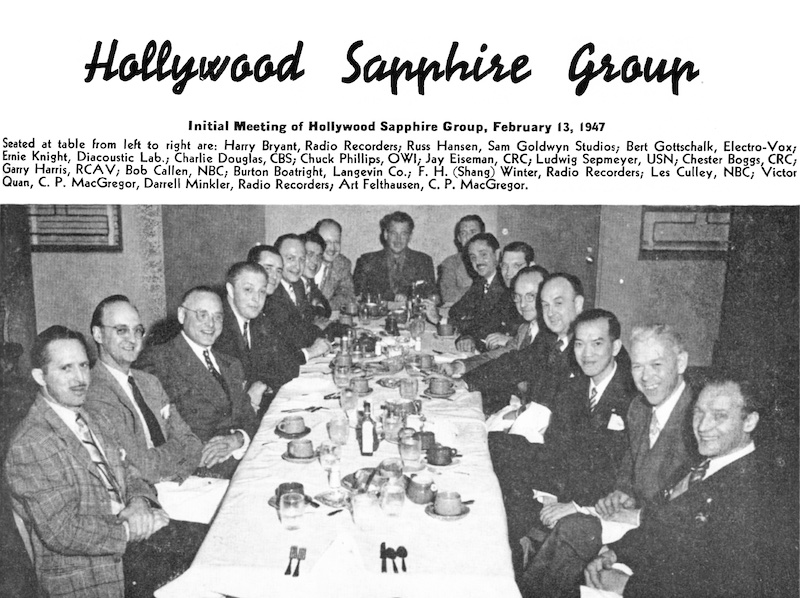
source: “Hollywood Sapphire Group”, Robert J. Callen, Audio Engineering Magazine, Vol.32, No.1, January 1948, pp.17,39-41.
1946年2月13日、Hollywood の Brittingham’s レストランで模様された、Hollywood Sapphire Group の初会合の写真 (写真キャプションの1947年は間違い)
一例として、Electronic Industries 誌の1946年11月号に掲載された、CBS のディスク録音解説記事と Capps のカッター針解説記事の並列掲載がある( Pt.16 セクション 16.2.3)。これらは共に、当時は完全に秘密主義が徹底されていた、市販レコード盤の制作に関する内容であり、サファイア・グループの取り組みによって技術情報の公開と共有、標準化の機運がますます高まっていたことを示すものである。
One example is the parallel publication in the November 1946 issue of Electronic Industries magazine of a CBS article describing disc recording and a Capps article describing the cutter stylus ( Pt.16 Section 16.2.3). Both of these articles were about the production of consumer phonograph records, which at the time were completely secretive, and they demonstrate the increasing momentum for the disclosure, sharing, and standardization of technical information that was being generated by the Sapphire Group’s efforts.
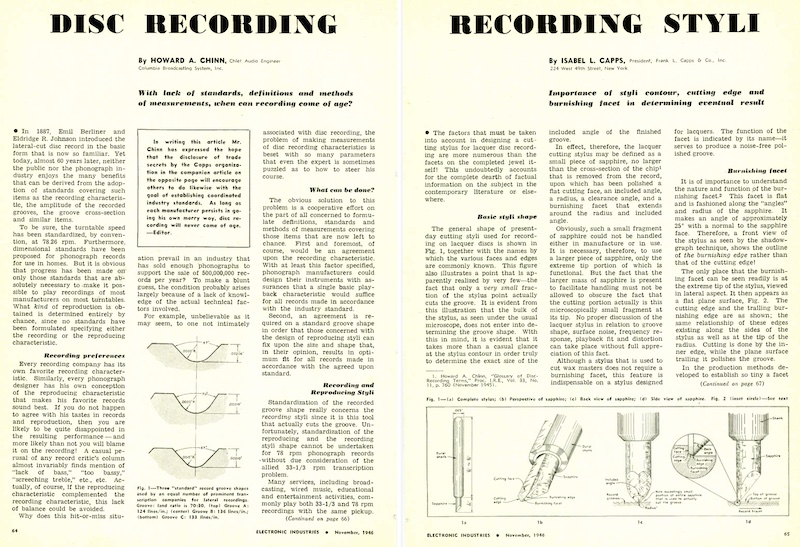
source: “Disc Recording”, by Howard A. Chinn, Electronic Industries, November 1946, pp.64 & 66.
and “Recording Styli”, Isabel L. Capps, Electronic Industries, November 1946, pp.65,67,100,102,104,106,108 & 110.

秘密主義が徹底されていた当時、こんな「企業秘密を公にする」記事の掲載って、すごくインパクトがあっただろうね。
At the time when secrecy was throughly enforced, the publication of such articles “making public a trade secret” must have had a huge impact.
編集長が「業界における企業秘密を公開することで、他社も同様に情報開示を行い、さらに協調的な業界標準を確立へと進むことを願っている」とか「各メーカが独自の道を歩み続ける限り、ディスク録音の時代はやって来るはずもない」と書いてるくらいだからね。大量の論文や記事を時代に沿って読んでくると、この頃から風向きが変わったのかも、と感じられるね。
Definitely, and the editor commented as “the hope that the disclosure of trade secrets … will encourage others to do likewise with the goal of establishing coordinated industry standards” and “as long as each manufacturer persists in going his own merry way, disc recording will never come of age”. Reading through the large number of papers and articles from the period, it seems like that there has been wind shifts since then.


で、この2つの記事は、具体的にはどんな内容が書かれていたわけ?
So, what exactly did these two articles say?
まず、CBS の当時のチーフエンジニア Howard A. Chinn 氏の「Disc Recording」では、民生用レコードの音溝の断面形状が各社ごとにバラバラであり、再生針形状も規格化されていないため、溝と針との接触位置にバラつきが生じている、という平易な解説記事だね。
The first article “Disc Recording” by Howard A. Chinn, chief engineer at CBS, briefly describes the cross-sectional shape engraved on the lacquer / wax masters varied from company to company, and the standard shape of the reproducing needle had not yet been standardized, which resulted in the contact position between the groove and the needle varied.


さすが、NAB 規格の執行委員会メンバらしい記事だね。ところでもうひとつの記事の方は?
That’s a very typical article from a member of the NAB Standards Executive Committee! By the way, what about the other article?
録音カッター針の研究開発や製造で著名な Frank L. Capps and Co., Inc. の Isabel L. Capps 氏による「Recording Styli」では、さきほど上で説明したバニシングファセットの解説だね。彼女もまた、NAB 規格のプロジェクトグループA小委員会メンバだったね。
“Recording Styli” by Isabel L. Capps of Frank L. Capps and Co., Inc., a famous company for researching and developing recording styli, describes the burnishing facet that we talked about earlier in this article. By the way, she was also a member of NAB Standards Project Group A.

また、サファイア・グループの活動が、NAB標準規格委員会の活動や、のちの RIAA 標準規格の活動の源流となったことは明らかである。さらには、初のオーディオ工学専門の学会 AES の設立( Pt.16 セクション 16.1.4)、そしてのちのAES再生カーブ策定グループの活動( Pt.16 セクション 16.2.4)へとつながっていった。事実、NAB録音再生規格委員会にも、AES標準再生カーブ規格委員会にも、サファイア・グループのメンバが多くが含まれていた( Pt.16 セクション 16.4.1)。
It is also clear that the activities of the Sapphire Group were the origin of the activities of the NAB Standards Committee and later of the RIAA Standards. It also led to the establishment of the AES, the first society dedicated to audio engineering ( Pt.16 Section 16.1.4), and later to the activities of the AES Standards Committee for formulating AES Playback Curve ( Pt.16 Section 16.2.4). In fact, both the NAB Recording and Reproducing Standards Committee and the AES Standards Committee included many members of the Sapphire Group ( Pt.16 Section 16.4.1).
25.7 The Birth of “Long-Playing” “Microgroove” Records and More
次世代のフォーマットである Columbia LP、および RCA Victor 45回転盤が1948〜49年に登場、同時期にオープンリールテープが登場、ほどなくハイファイブームも始まったタイミングで「高忠実再生」にも注目が集まり、当初の技術的欠陥と複数の録音再生特性の登場のせいで、無駄に混乱が広がってしまった、そんな時期のあれこれについて。1940年代後半〜1950年代前半の話です。
This section deals with the Columbia LP, the next generation format in 1948, and the RCA Victor 45 rpm disc appeared in 1949, when at the same time reel-to-reel tapes were introduced. Then soon after the Hi-Fi boom began, “high-fidelity playack” also attracted attention. The initial technical flaws and the introduction of multiple recording / reproducing characteristics led to the spread of confusion. The timespan is approximately from the late 1940s to the early 1950s.
25.7.1 “Battle of the Speeds: 33⅓ vs 45”
1948年6月18日に初お披露目された、Columbia による 33⅓回転の Long Playing (Lp) Microgroove レコード( Pt.11)、そして、半年遅れで1949年1月10日に初お披露目された、RCA Victor による 7インチ45回転盤( Pt.13)、がそれぞれ登場した。共に従来の78回転盤やトランスクリプション盤より微細な溝でカッティングされたヴィニライト盤で、従来のレコードより圧倒的に静粛で高音質を実現可能な技術であった( Pt.12 セクション 12.2 および Pt.13 セクション 13.2)。
Two innovative disc formats debuted almost simultaneously, six months apart: 33⅓ rpm Long Playing (Lp) Microgroove Records by Columbia, first unveiled on June 18, 1948 ( Pt.11); and 7-inch 45 rpm records by RCA Victor, first introduced on January 10, 1949 ( Pt.13). Both were vinylite discs cut with finer grooves than conventional 78 rpms and electrical transcription discs, a technology that made them significantly quieter than regular records and capable of achieving high sound quality ( Pt.12 Section 12.2 as well as Pt.13 Section 13.2).
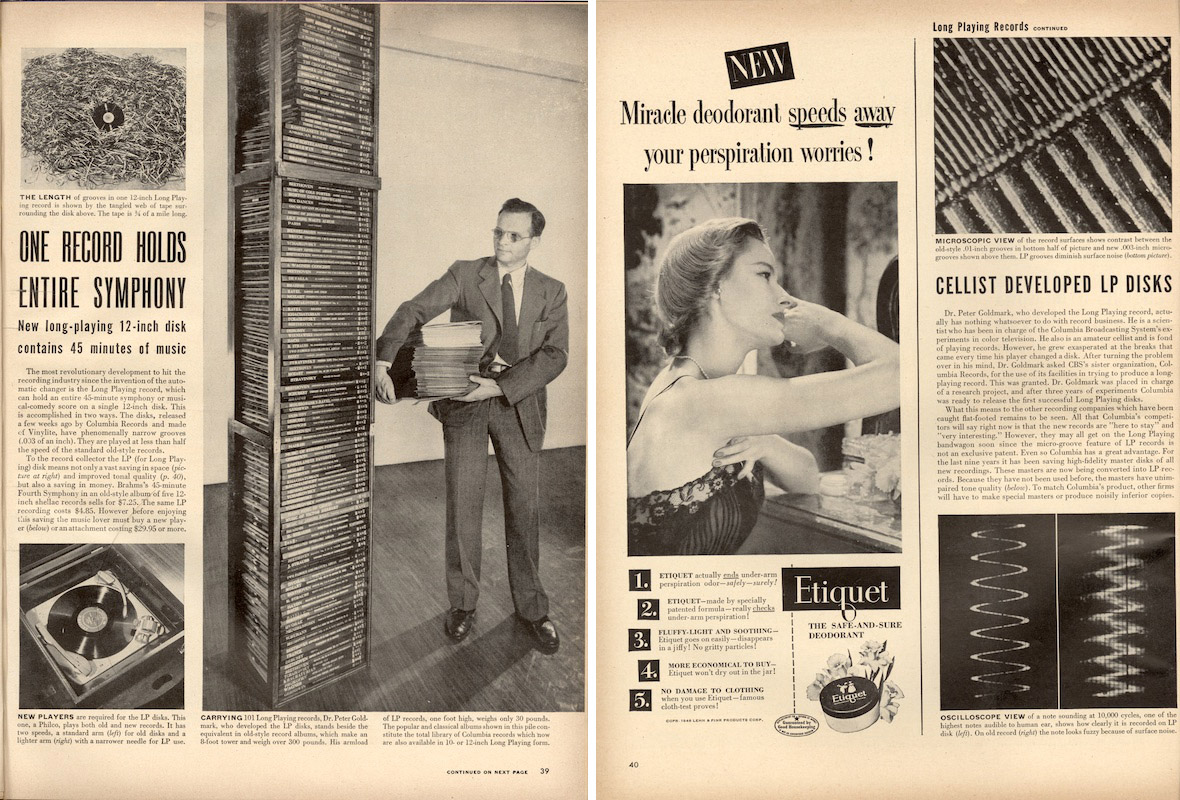
source: LIFE Magazine, July 26, 1948, pp.39-40
LIFE誌1948年7月26日号でLP誕生を伝える記事
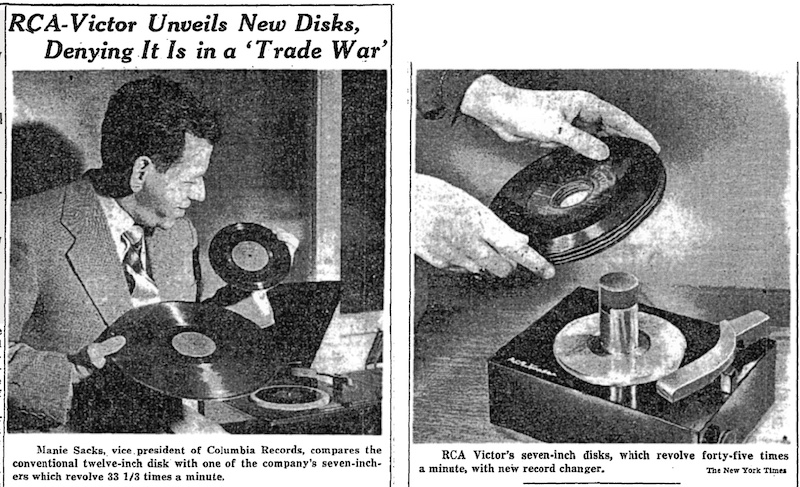
“RCA-Victor Unveils New Disks, Denying It Is in a ‘Trade War’”
source: The New York Times, Tuesday, January 11, 1949, p.29.
左が Columbia 7インチ 33 1/3回転盤、右が RCA Victor 7インチ 45回転盤

Columbia LP 誕生のストーリーは、いろんな立場からいろんな話があって、かなり興味深かったね。
The story of the birth of Columbia LP was quite interesting, with many different stories from many different perspectives.
RCA から引き抜かれて Columbia 社長になった Edward Wallerstein 氏と、CBS の自称「異端の発明者」 Peter Goldmark 氏、この両者の確執のせいか、LP開発の真の立役者が誰なのか語り部によって錯綜しているね。さらには Columbia Masterworks 部門副代表 Goddard Lieberson 氏の当時の記事、CBS 社長の Frank Stanton 氏の回顧録、技術面で多大な貢献をした Columbia チーフエンジニア William S. Bachman 氏のインタビュー、全て互いに言い分が微妙に違うんだよね( Pt.11 および Pt.12 を参照)。
Perhaps it is because of the feud between Edward Wallerstein, who was brought over from RCA to become president of Columbia Records, and Peter Goldmark of CBS, the self-proclaimed “Maverick Inventor”, that the storytellers are confused as to why really played a leading role in the development of LP records. In addition, an article by Goddard Lieberson (Vice President of Columbia Masterworks division), a memoir by Frank Stanton (President of CBS), and an interview with William S. Bachman (Chief Engineer at Columbia, who made significant technical contributions) — all of which have slightly different version of the same story ( Pt.11 and Pt.12).

ここから、米国内全レーベルを巻き込んだ音楽メディアの次世代フォーマットをめぐる激しい主導権争い、通称「回転数戦争」が始まったが、1950年中頃に「長尺のクラシック音楽やアルバムは33⅓回転LP」「78回転盤代替としてのシングルは45回転盤」という棲み分けによる併存、で落ち着くことになった( Pt.14 全体)。
A fierce battle for leadership over the next-generation format of music media involving all labels in the U.S., known as the “Battle of the Speeds”, began. But by mid-1950, it had settled into a coexistence based on the segregation of “33⅓ rpm LPs for long classical music and albums” and “45 rpm for singles as a substitute for 78 rpms” ( Pt.14).
25.7.2 Advent of Reel-to-Reel Tape Recorders
戦後直後からテープ装置は各メーカが盛んに開発・製造していたが、マイクログルーヴ盤登場とほぼ同時期の1948年に、Ampex 200A テープレコーダが登場、その当時としては圧倒的な高品質と便利さから、後継機種の Ampex 201 と Ampex 300 は、米国の録音スタジオであっという間にスタンダードな存在となった( Pt.17 セクション 17.2)。
Immediately after the war, reel-to-reel tape equipment was actively developed and manufactured by various manufacturers, and the Ampex 200A tape recorder was introduced in 1948, about the same time the microgroove records were introduced. Because of its overwhelmingly high quality and convenience for its use, its successors, the Ampex 201 and Ampex 300, quick became the standard in U.S. recording studios ( Pt.17 Section 17.2).

奇しくも、マイクログルーヴLP登場と同じ年の1948年に、テープレコーダが登場し、あっという間に録音現場に浸透したんだね。
Coincidentally, the tape recorder was introduced in 1948, the same year the microgroove LP was introduced, and it quickly penetrated the recording scene.
1947年10月に、ラジオ番組 Bing Crosby Show で初めて Magnetophon テープレコーダが使用され、その便利さがあっという間に広まり、さらには Bing Crosby が Ampex に資金協力をしたおかげで、Ampex 200 が誕生したんだよね(Pt.17 セクション 17.2.1)。さらには Capitol が1948年8月からテープレコーダを本格導入し、勢いが加速したんだね(Pt.17 セクション 17.2.2)。
In October 1947, Magnetophone tape recorders were used for the first time on the Bing Crosby Show radio program, and their usefulness spread quickly, and thanks to Bing Crosby’s financial support of Ampex, the Ampex 200 was born (Pt.17 Section 17.2.1). Capitol’s full-scale introduction of tape recorders in August 1948 accelerated the momentum (Pt.17 Section 17.2.2).

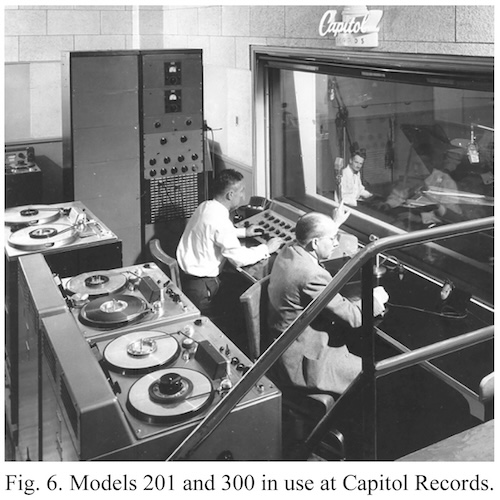
source: “History of The Early Days of Ampex Corporation, as recalled by John Leslie and Ross Snyder”, AES Historical Committee, December 17, 2010.

特に LP 黎明期は、78回転盤音源の LP 再発が多かったから、テープの登場と導入が奇跡的にほぼ同時期だったのは本当に助かったはずだよね。
Especially in the early days of LPs, there were many LP reissues of 78 rpm recordings, so it must have really helped that tape recorders miraculously appeared were introduced at about the same time.
そうだね、テープがなければ、複数の78回転盤マスターを再生しつつリアルタイムでカッティングしていたことになったわけだからね。Columbia の Ike Rodman 氏が1943年に出願し、1947年に特許となったシステムが、まさに複数台のターンテーブルとカッティングレースを同期するシステムだったからね。
Yes, because without tapes, engineers would have been cutting in real time while playing back multiple 78 rpm masters. The system that Ike Rodman of Columbia applied for in 1943 and was patented in 1947 was a system that synchronized multiple turntables and a cutting lathe.

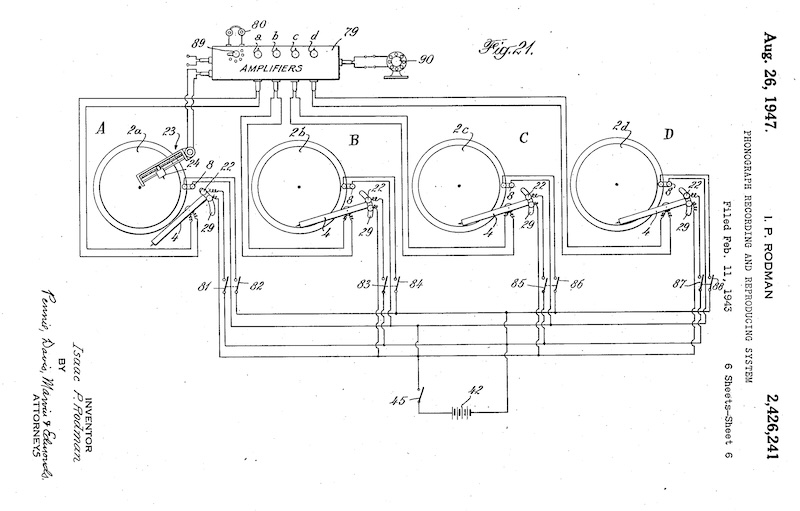
source: “US2,426,241A: Phonograph recording and reproducing system (Issac P. Rodman)”.
Columbia の Ike Rodman 氏によって出願された、複数枚のディスクから新たなブランクディスクに複製する装置の特許
これにより、ワックス盤やラッカー盤に直接演奏を録音するダイレクトカッティングから、テープに録音してからスプライシングなど編集を施し、最終的にカッティングを行う、というプラクティスに急速に置き換わっていった。また同時に、録音した時のマスターテープから、カッティングする直前のカッティングマスターテープを制作する過程で、イコライザなどさまざまな機器を駆使して音作りを施すことも一般的になっていった。
This rapidly replaced the practice of direc-to-disc recording, where performances were recorded directly onto wax or lacquer discs, with the practice of recording to tape, then editing by splicing etc., and finally cutting. Also at the same time, it became common practice to use various equipment such as equalizers to create sound in the process of producing a cutting master tapes from the recorded master tapes.
25.7.3 Flooded with Many Recording Characteristics
1950年代前半のマイクログルーヴ盤用録音カーブは複数が乱立し、混乱を極めていたと思われるが、客観的な技術資料に乏しいため、一部のレーベルを除き正確なところは不明である( Pt.17 セクション 17.5)。
The recording curves used for U.S. microgroove records in the early 1950s were multiple and confusing, but due to a lack of objective technical data, the exact details are unknown with the exception of a few labels ( Pt.17 Section 17.5).
米国において、1950年代前半当時に存在していた録音カーブを大別すると、およそ「Columbia / NAB」「(old) Orthophonic / New Orthophonic」「AES」「Bartók」「Decca ffrr」の5つのグループに分けられる。
In the United States, the variety of recording curves that existed in the early 1950s can be roughly divided into approximately five groups: “Columbia / NAB”, “(old) Orthophonic / New Orthophonic”, “AES”, “Bartók”, and “Decca ffrr”.
[1] まず、本家本元である Columbia LP カーブ(500C-16: 500Hzターンオーバー、高域プリエンファシス100μs、ベースシェルフ1,590μs)( Pt.17 セクション 17.5.1、セクション 17.6.1)。LP 開発元である Columbia は当然、録音イコライザも当初は自社開発であった。また Columbia にマスタリングとプレスを委託したレーベルもこれが使われたことになる。
[1] First, Columbia LP curve (500C-16: 500Hz turnover, 100μs high-frequency pre-emphasis, 1,590μs bass shelf) ( Pt.17 Section 17.5.1, Section 17.6.1). Columbia, the original developer of LP, naturally developed its own recording equalizers. Thus, this curve would also have been used by the labels that oursourced mastering and pressing to Columbia.
放送局用トランスクリプション盤用 1942/1949 NAB カーブ(500B-16: 500Hz ターンオーバー、100μs高域プリエンファシス、3,180μsベースシェルフ)( Pt.17 セクション 17.6.1)をそのままマイクログルーヴ盤に適用したものも、このグループに属する。Columbia LP カーブは元々、NAB カーブからベースシェルフだけ変更し開発されたものである。LP参入時に、トランスクリプション盤カッティング用の既存の録音イコライザを流用し Columbia LP カーブの互換としたスタジオもあったと考えられる。例えば、最初期の Reeves Sound Studios は恐らく NAB カーブを使用していたと考えられる( Pt.17 セクション 17.5.4)。
The 1942/1949 NAB curve (500B-16: 500Hz turnover, 100μs high-frequency pre-emphasis, 3,180μs bass shelf) ( Pt.17 Section 17.6.1), which arguably was used at several studios for cutting microgroove records as well, also falls in this group. As a matter of fact, the Columbia LP curve was originally based on this NAB curve, with only the bass shelf changed. It is thought that some studios diverted the existing NAB recording equalizers (for electrical transcription) for cutting microgroove records, treating it as a very close / compatible with the Columbia LP curve. For example, the early Reeves Sound Studios probably used the NAB curve for cutting microgroove records ( Pt.17 Section 17.5.4).
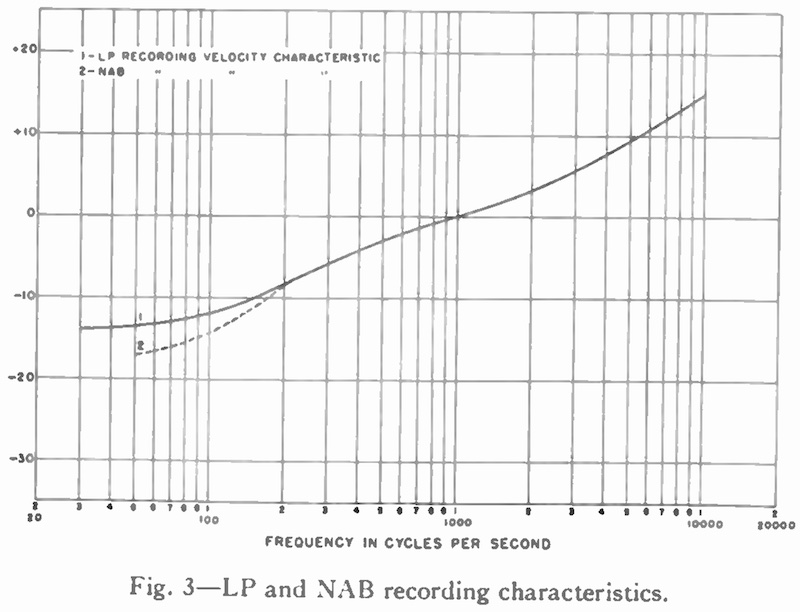
source: “The Columbia Long-Playing Microgroove Recording System”, Proceedings of the I.R.E., August 1949, Vol.37, No.8, pp.923-927.
Columbia LP 論文より。NAB カーブと Columbia LP カーブではベースシェルフのみ異なる
[2] 続いて、RCA Victor が採用していた (old) Orthophonic カーブ(500N-13.7: 500Hzターンオーバー、高域プリエンファシス75μs、ベースシェルフなし。ただしローパスフィルタが使われていたため 500N-12 または 500N-12.7 とされる場合もある)。1952年8月より、ベースシェルフが加えられローパスフィルタが撤廃された New Orthophonic カーブ(500R-13.7: 500Hzターンオーバー、75μs高域プリエンファシス、3,180μsベースシェルフ)へと移行した( Pt.17 セクション 17.5.2、セクション 17.6.2)。当初録音イコライザは全て自社開発であった。RCA Victor にマスタリングとプレスを委託したレーベルもこれらが使われたことになる。詳細が不明な通称 MGM カーブ(500N-12)も、(old) Orthophonic と同一であった可能性も指摘されている。
[2] Next, the (old) Orthophonic curve used by RCA Victor (500N-13.7: 500Hz turnover, 75μs high-frequency pre-emphasis, no bass shelf; however, since a low-pass filter was applied, it is sometimes referred to as 500N-12 or 500N-12.7). In August 1952, a bass shelf was added and the low-pass filter was eliminated in favor of the New Orthophonic curve (500R-13.7: 500 Hz turnover, 75 μs high-frequency pre-emphasis, 3,180 μs bass shelf) ( Pt.17 Section 17.5.2, Section 17.6.2). Initially, all recording equalizers were developed in-house; labels that outsourced mastering and pressing to RCA Victor would also have used this curve. It has been suggested that the MGM curve (500N-12), of which details are unknown, may have been identical to the (old) Orthophonic.
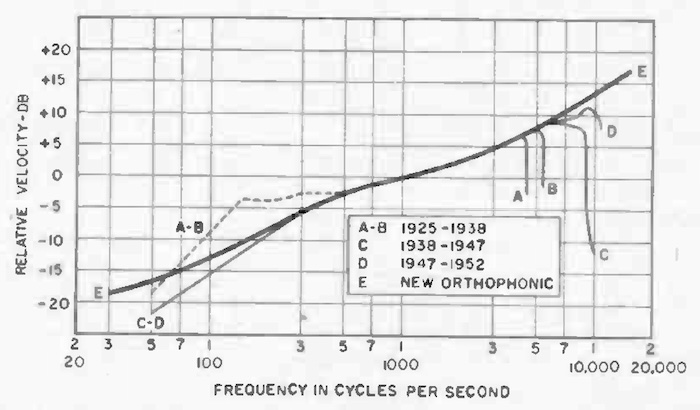
source: “Evolution of a Recording Curve”, R.C. Moyer, Audio Engineering, Vol. 37, No. 7, July 1953, p. 20.
D がいわゆる Old Orthophonic、E が New Orthophonic
この図を信用するならば、Old Orthophonic は 6〜7,000Hz より上は意図的に減衰させているようにみえる
また、重低域ターンオーバ(ベースシェルフ)が存在していない
[3] 1947年に設立されたオーディオ工学専門の学会 AES (Audio Engineering Society) が1951年に提唱した AES 再生カーブ(400N-12: 400Hz ターンオーバー、高域プリエンファシス63.7μs、ベースシェルフなし)( Pt.17 セクション 17.5.4、セクション 17.5.5、セクション 17.6.3)。これは再生用カーブであることに注意。英国や欧州のレコード、米国の新旧様々なレコード、それらすべてを「そこそこ」再生できるようにするための妥協案的なものとして生み出された。よって、録音用カーブとして設計されたものではなかったが、この AES 再生カーブを念頭に録音イコライザを設計しカッティングしたレーベルも存在した。Capitol が RIAA 以前に採用していたとされるカーブ(400N-12.7)( Pt.17 セクション 17.5.3、セクション 17.5.6)も、この AES カーブと (old) Orthophonic カーブを意識したもの、という説もある。
[3] AES Playback Curve (400N-12: 400Hz turnover, 63.7μs high-frequency pre-emphasis, no bass shelf) proposed in 1951 by AES (Audio Engineering Society) which was established in 1947 ( Pt.17 Section 17.5.4, セクション Section and Section 17.6.3). Please note that these are playback curves. It was formulated as a compromise to allow playback of British / European recordings, as well as various old and new U.S. recordings, all of which can be played back “so-so” with a uniform curve. Therefore, although it was not designed as a recording curve, some labels designed and cut their recording equalizers with this AES playback curve in mind. Some say that the curve (400N-12.7) which Capitol is said to have adopted before the RIAA ( Pt.17 Section 17.5.3, Section 17.5.6), was designed with this AES curve and the (old) Orthophonic curve in mind.
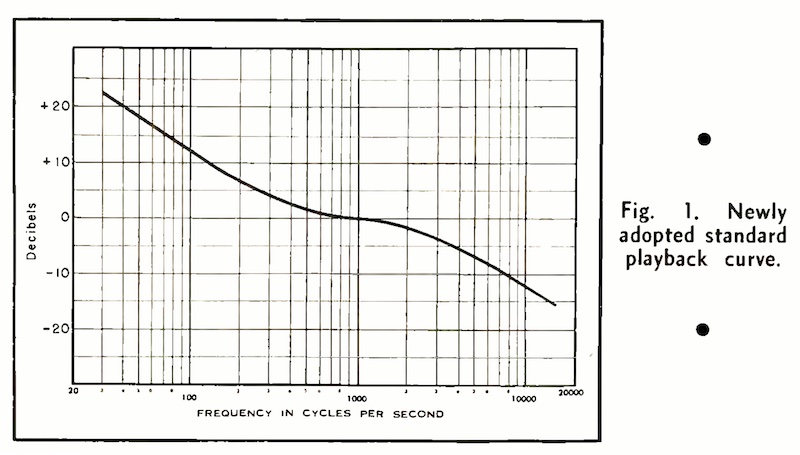
source: Audio Engineering, Vol. 35, No. 1, January 1951, p. 22, Fig. 1.
論文で提示された AES 再生カーブのグラフ
重低域ターンオーバーがないこと、低域ターンオーバー周波数が 400Hz であること、
高域ロールオフが -12dB at 10,000Hz、そして 15,000Hz までプロットされている

AES 再生カーブにあわせた録音イコライザの推奨回路図も公開されていたんだよね。これがプロフェッショナル用LCRネットワークか。
A recommended schematic for a recording equalizer to match the AES Playback curve was also published. This is a professional LCR network, right?
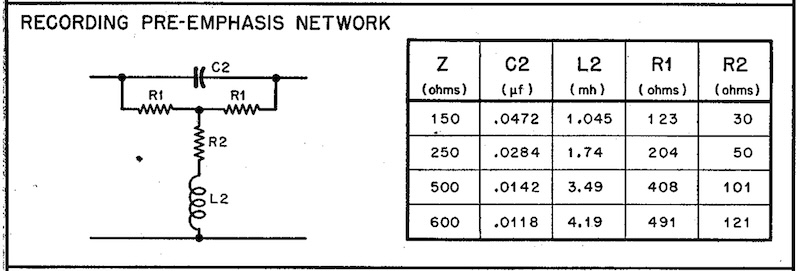
source: Audio Engineering, Vol. 35, No. 1, January 1951, p. 45, Fig. 3.
AES 再生カーブに対応するプロフェッショナルユースのLCR録音イコライザ回路図
そうだね。論文に「このイコライザは、プロの業務用設備向けに、これらの(AES録音カーブの)ネットワークの構築を容易にするために示したものである」と添えられているね。その他、プロフェッショナル用のLCRネットワークを使った再生イコライザ回路図、そして民生用のシンプルなRCネットワークの再生イコライザ回路図も掲載されている。
Exactly. The paper reads “the equalizer is shown in order to facilitate the construction of these networks for use in professional installations”. Other information includes a reproducing equalizer schematic with an LCR network for professional use, and another reproducing equalizer schematic with a simple RC network for consumer use.

[4] Peter Bartók が独自に使用していた Bartók カーブ(629C-16 または 629B-16 または 629N-16: 629Hz ターンオーバー、高域プリエンファシス100μs、ベースシェルフ1,590μsまたは3,180μsまたはなし)( Pt.17 セクション 17.5.7、セクション 17.6.4)。NAB や Columbia LP カーブを基本としつつ、ターンオーバーを 629Hz にまでひきあげたバリエーション。Peter Bartók 氏がマスタリングに関わったレーベル(Bartók、Period、Caedmon、Elektra、Lyrichord など)で一部に使われたものとされる。該当する盤は、レーベルや裏ジャケに「629(Hz)」の記載が確認できることが多い。
[4] Peter Bartók’s original Bartók curve (629C-16 or 629B-16 or 629N-16: 629Hz turnover, 100μs high-frequency pre-emphasis, 1,590μs or 3,180μs bass shelf or none) ( Pt.17 Section 17.5.7, Section 17.6.4). It was a variation of the NAB and Columbia LP curves, but with turnover raized to 629Hz, used by some of the labels that Peter Bartók mastered for (Bartók, Period, Caedmon, Elektra, Lyrichord, etc.). The corresponding records are often marked with “629(Hz)” on the label or back cover.
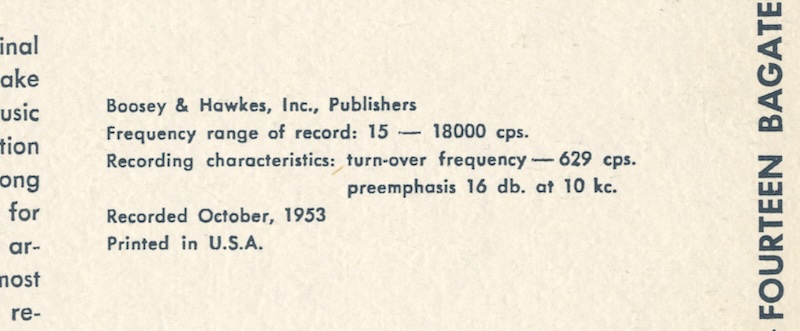
from my own collection of Bartók BR-918 (1954).
1953年10月録音、1954年リリースの Bartók BR-918 の裏ジャケより
“Recording characteristics: turn-over frequency — 629 cps. preemphasis 16 db, at 10 kc.” と明記されている
[5] いわゆる Decca ffrr カーブ(500C-10.5 または 500N-10.5: 500Hzターンオーバー、高域プリエンファシス50μs、ベースシェルフ1,590μsまたはなし)( Pt.17 セクション 17.5.8)。英 Decca で製造された米 London レーベルがこれに該当する。高域プリエンファシス50μsは、当時の英国と欧州のマイクログルーヴ盤向けスタンダードであった。
[5] So-called Decca ffrr curve (500C-10.5 or 500N-10.5: 500Hz turnover, 50μs high-frequency pre-emphasis, 1,590μs bass shelf or none). The U.S. London label manufactured by U.K. Decca falls into this category. The 50μs high-frequency pre-emphasis was the standard for microgroove recordings in the U.K. and Europe at the time.
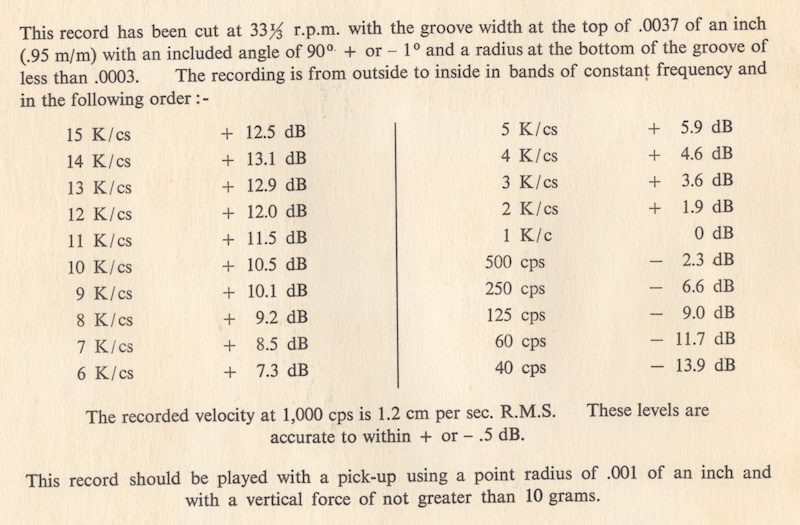
DECCA Microgroove Frequency Test Record (Decca LXT 2695)
early matte (non-glossy) flipback cover
from my own collection
78回転盤用の初代 ffrr カーブ (300N-5.5) ではなく、マイクログルーヴ盤用の2代目 ffrr カーブ (500N-10.5) でカッティングされた周波数テストレコード、1952年頃リリース

で、さっきからいろんな表記が入り乱れてるけど、ここで整理してもらっていいかな。
Well, there have been a lot of notations mixed up since a while ago, so I’ll let you sort it out here.
了解。まず、「500C-16」とか「400N-12」とかの表記は、3つのパラメータから構成されている簡易表記だね。冒頭の数字はターンオーバー周波数を表し、続くアルファベット1文字はベースシェルフを表す(B: NAB, C: Columbia LP, R: RIAA, N: ベースシェルフなし)。最後の数字は、高域プリエンファシスを表し、10kHz でのブースト量(dB)を表しているんだ。
Roger. First of all, the notation “500C-16” or “400N-12” is a simplified notation consisting of three parameters. The first number represents the turnover frequency; followed by a letter of the alphabet representing the bass shelf (B: NAB, C: Columbia, R: RIAA, N: no bass shelf); the last number representing the high-frequency pre-emphasis, which is the amount of boost (in dB) at 10kHz.


なるほど。で、時定数による表記もあるわけね。
I see. So there is also a notation by time constants.
時定数表記(μs)でも、基本的にはベースシェルフ、ターンオーバー、高域プリエンファシス、という3つのパラメータを指定していることに変わりはない。NAB や RIAA のベースシェルフは 3,180μs、Columbia LP のベースシェルフは 1,590μs、ターンオーバー500Hzは318μs、NAB や Columbia LP の高域プリエンファシス 16dB at 10kHz は 100μs、RIAA の高域プリエンファシス 13.7dB at 10kHz は 75μs、って感じだね。
The time constant notation (μs) still basically specifies three parameters: bass shelf, turnover, and high-frequency pre-emphasis. For example, the bass shelf for NAB and RIAA is 3,180μs, that of Columbia LP is 1,590μs; 500Hz turnover is 318μs; pre-emphasis for NAB and Columbia LP (16dB at 10kHz) is 100μs, that of RIAA (13.7dB at 10kHz) is 75μs; and so on.

RCA Victor の (old) Orthophonic / New Orthophonic 録音特性は、周波数応答特性グラフ、録音イコライザの回路図ともに現存している。また、1951 AES カーブ用再生イコライザの推奨回路図は当時広く公開された。
RCA Victor’s (old) Orthophonic / New Orthophonic recording characteristics can be confirmed by the surviving frequency response graphs and by the recording equalizer schematics. Also, recommended schematics for the playback equalizer for the 1951 AES curve were widely published at the time.
しかしこれらは非常に例外的で、Columbia LP カーブについては、周波数応答特性のグラフプロットが当時公開されたが、当時 Columbia 社内で採用されていた録音イコライザの回路図は公になっていない。その他のカーブについても、資料が存在しないか、あるいはいまだ公になっていないため、聴感による主観的判断がほとんどである。1942/1949 NAB 標準規格でも、グラフプロットのみの提示であったこと、そして各種解説記事でも回路実装例がバラバラであった。
However, these are very exceptional. For the Columbia LP curve, a graph plot of the frequency response characteristics was published at that time, but the circuit diagram of the recording equalizer used in Columbia has not been made publis. As for the other curves, since no data exists or has not been made public yet, most of them are subjective judgements based on audition. Even in the 1942/1949 NAB Standards, only graphical plots were presented, and various explanatory articles also had varying examples of circuit implementation.
25.8 NARTB (1953) / AES (1954) / RIAA (1954) Characteristics
そしてついに、現代の標準的録音再生特性が生まれた、その時期のあれこれについて。1953年および1954年の話です。
And finally, the standard recording and reproducing characteristics of the modern era was born. This section deals with this and that. The timespan is between 1953 and 1954.
25.8.1 NARTB Standards (1953)
民生用マイクログルーヴ盤登場を受け、放送局用トランスクリプション盤もマイクログルーヴ盤に対応する標準規格が必要になった。また、1942/1949年 NAB カーブの100μs高域プリエンファシスが過剰である問題点が長らく指摘されていたことを受けて、標準規格改定に向けた作業が進められた( Pt.18 セクション 18.3.1)。最終的に RCA Victor の New Orthophonic 録音特性(500R-13.7: 500Hzターンオーバー、高域プリエンファシス75μs、ベースシェルフ3,180μs)が採用され、1953年6月19日に承認された NARTB規格 (1953)に取り込まれた( Pt.18 セクション 18.3.3)。
Following the appearance of microgroove records for consumer use, a revised standard corresponding to microgroove discs became necessary for broadcast transcription discs as well. In addition, the problem of excessive 100μs high-frequency pre-emphasis of the 1942/1949 NAB curve had long been pointed out, and work was underway to revise the standard ( Pt.18 Section 18.3.1). Finally, RCA Victor’s New Orthophonic recording characteristics (500R-13.7: 500Hz turnover = 318μs, 75μs high-frequency pre-emphasis, 3,180μs bass shelf) were adopted and approved on June 19, 1953 as a part of NARTB Standards (1953) ( Pt.18 Section 18.3.3).
この高域プリエンファシス低減採用のもう一つの要因は、ホットスタイラス方式カッターの登場である。これにより、線速度の遅い33⅓回転の内周であっても以前に比べて充分に高域カッティングできるようになったため、高域プリエンファシスを弱めることができ、同時に高域歪やトレーシング歪を軽減することが可能となった。
Another factor in the adoption of this high-frequency pre-emphasis reduction is the advent of the hot stylus method cutterhead. This enabled sufficient high-frequency cutting even on the inner circumference of 33⅓ rpm, which has a slower line speed than before, thus reducing high-frequency pre-emphasis and at the same time reducing high-frequency distortion and tracing distortion.

ちょっと待って、ホットスタイラス方式を最初に採用したのは Columbia なのに、なぜ Columbia LP カーブは高域プリエンファシス 100μsにしたんだろう?
Wait a minute, Columbia was the first to use the hot stylus method, so why did the Columbia LP curve adopt a high-frequency pre-emphasis of 100μs?
鋭い疑問だね。そして真実は闇の中だ。ただ、Columbia LP カーブが 1942/1949 NAB カーブを雛形にして、ベースシェルフだけ変更したものだよね。だから、NAB カーブを使っていた放送局やマスタリングスタジオにとって互換性が高い(高域プリエンファシス用回路を修正するコストが不要)ことを重視してあえて100μsを選んだ、そんな可能性が考えられるね。
That’s an astute question, and the truth is in the dark after all. But it’s just that Columbia LP curve was based on the 1942/1949 NAB curve, only with the bass shel being modified. So it is possible that they chose 100μs pre-emphasis because of its compatibility with the NAB curve for broadcast stations and mastering studios that were using the NAB curve (i.e. no need to spend extra money to modify the circuit for high-frequency pre-emphasis).

さらに同時期に 横振動フィードバックカッター が登場したことも挙げられる( Pt.18 セクション 18.1)。1941年に開発され、1944年に英Deccaが実用化した( Pt.18 セクション 18.1.3)のをかわきりに、1949年に Bell Labs / Western Electric の Westrex 2A モーショナルフィードバックカッター( Pt.18 セクション 18.1.4)、1953年に Grampian/BBC Type B1/AGU ノンモーショナルネガティブフィードバックカッター( Pt.18 セクション 18.1.5)がそれぞれ米国で登場、カッターヘッドの記録特性がほぼフラットになったことで、録音イコライザが完全に独立することとなり、カッターヘッドの記録特性と独立して録音特性を実装しやすくなった。
It is also worth mentioning that lateral feedback cutters also appeared around the same period ( Pt.18 Section 18.1). Developed in 1941 and began operating by U.K. Decca in 1944 ( Pt.18 Section 18.1.3), followed by Bell Labs / Western Electric’s Westrex 2A Motional Feedback Cutter in 1949 ( Pt.18 Section 18.1.4) and Grampian/BBC Type B1/AGU Non-motional Negative Feedback Cutter ( Pt.18 Section 18.1.5) in 1953, respectively. The nearly flat recording characteristics of the cutterhead made the recording equalizer completely independent, making it easier to implement the recording characteristics, being independent of the cutterhead’s characteristics.

ターンオーバーが、ついにカッターヘッドから独立したってことだね。これは Grampian/BBC Type B1/AGU カッターヘッドの記録特性か〜。
So the turnover is finally independent from the cutterhead. Below is a recording characteristics of the Grampian/BBC Type B1/AGU cutterhead, isn’t it?
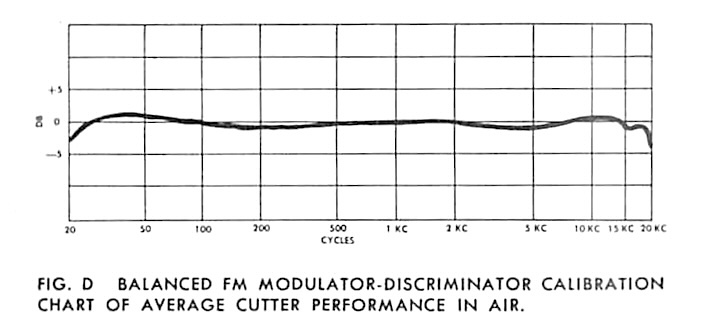
source: “Grampian / Gotham Feedback Cutter System” brochure (possibly mid-late 1950s), by Reeves Equipment Corp.
1950年代の Grampian / Gotham フィードバックカッターシステムの小冊子より。
Grampian / BBC ノンモーショナルネガティブフィードバックにより、Type B1/AGU カッターヘッド単体でのフラット特性を確保、
とはいえ、すべてのフィードバックカッターヘッドの記録特性が完全フラットになったわけではないんだ。たとえば Westrex 3D カッターヘッドの記録特性は、フィードバックをかけてもフラットではなかったんだ。
Nevertheless, not all feedback cutterheads had perfectly flat recording characteristics. For example, the recording characteristics of the Westrex 3D cutterheads were not still flat when feedback was applied.

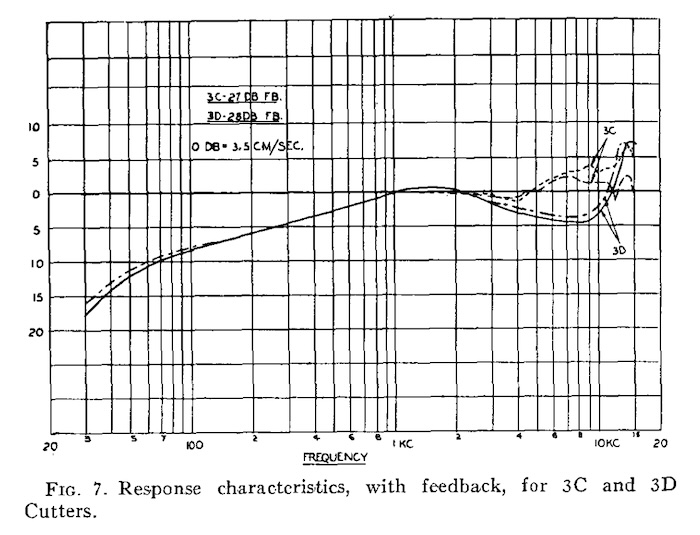
source: “The Westrex 3D StereoDisk System”, C.S. Nelson and J.W. Stafford, Journal of the Audio Engineering Society, Vol. 12, No. 3 (July 1964), pp.178-185.
Even with feedback, the response characteristic is not perfectly flat in velocity.
フィードバックありの状態での Westrex 3C および 3D カッターヘッドの特性。このままだと十分に定速度フラットではない。

え?ちょっと頭がこんがらがってきた。じゃあどうやってこれをフラットにして、さらに録音特性を付加していたんだろう?
Huh? I’m getting a little confused. So how did they flatten this out and add more recording characteristics?
それについては、あとで(セクション 25.9.2)説明するね。
I’ll explain that later in the Section 25.9.2, so don’t worry about it.

この1953年版では、NAB/NARTB 規格としては初めて、「a) 3,180μs の時定数を持つ、並列L/Rネットワーク(ベースシェルフ)」「b) 318μs の時定数を持つ、直列RCネットワーク(ターンオーバー)」「c) 75μs の時定数を持つ、並列RCネットワーク(高域プリエンファシス)」と、3つの時定数が厳密に記載された( Pt.18 セクション 18.3.3)。グラフの定義域は 30Hz〜15,000Hz である。
In this 1953 edition, for the first time in NAB/NARTB Standards, three time constants were strictly stated: a) Parallel L/R network with a time constant of 3,180μs (bass shelf); b) series RC network with a time constant of 318μs (turnover), and c) parallel RC network with a time constant of 75μs (high-frequency pre-emphasis). The graph’s definition range is from 30Hz to 15kHz.
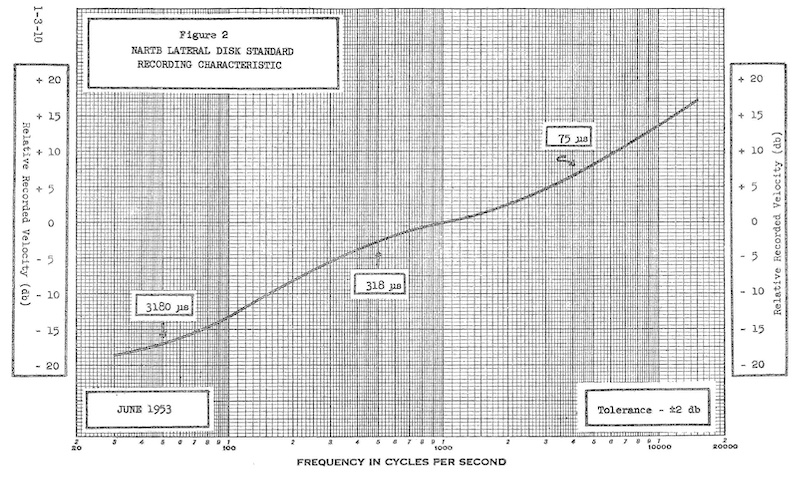
source: “Figure 2: NARTB Lateral Disk Standard Recording Characteristic, Supplement No.2 to NAB (NARTB) Engineering Handbook (Fourth edition, 1949): NARTB Recording and Reproducing Standards (June, 1953), p. 1-3-10.
1953年NARTB標準規格文書に掲載された、横振動トランスクリプション盤用録音カーブのグラフ
グラフの定義域は 30Hz〜15,000Hz
25.8.2 AES Playback Standard (1954)
英国や欧州のレコード、米国の新旧様々なレコード、それらすべてを「そこそこ」再生できるようにするための妥協案的なものとして1951年に提唱された AES 再生カーブであったが、主たるLP用録音カーブである Columbia LP や RCA Victor New Orthophonic では定義されていたベースシェルフ部分が、AES 再生カーブでは未定義である問題点が指摘されていた( Pt.18 セクション 18.4.1)。
The AES Playback Curve was advocated in 1951 as a compromise to enable “reasonable” playback of various old and new records from the U.S. as well as British and European records. However, it was pointed out that the AES Playback Curve did not define the bass shelf, which was defined in the main LP recording curves, Columbia LP and RCA Victor New Orthophonic ( Pt.18 Section 18.4.1)
そこで、1953 NARTB 規格の策定を受けて、AES再生カーブの改訂作業が始まった。結果として、1953年12月にドラフト承認後、学会論文誌に掲載され( Pt.18 セクション 18.4.2)、学会員からのレビュー期間を経て、1954年6月に正式承認された( Pt.18 セクション 18.4.4)。この新AES再生カーブ (1954)は、RCA Victor New Orthophonic = 1953 NARTB の録音特性に呼応するものとなった。
Therefore, following the development of the 1953 NARTB Standard, work began on revising the AES Playback Curve. The revised draft was approved in December 1953 then published in the journal ( Pt.18 Section 18.4.2), followed by a review period from the AES members, then finally approved in June 1954 ( Pt.18 Section 18.4.4). This new AES Playback Curve (1954) corresponded to the recording characteristics of the RCA Victor New Orthophonic = 1953 NARTB.
1953 NARTB 規格同様、この新AES再生カーブでも、75μs、318μs、3,180μs、の3つの時定数が明記され、再生特性が厳密に定義されていた( Pt.18 セクション 18.4.2)。グラフの定義域はこれも 30Hz〜15,000Hz となっていた。
Like the 1953 NARTB Standards, the new AES Playback Curve also specifies three time constants: 75μs, 318μs, and 3,180μs ( Pt.18 Section 18.4.2). The graph’s definition range is, again, from 30Hz to 15kHz.
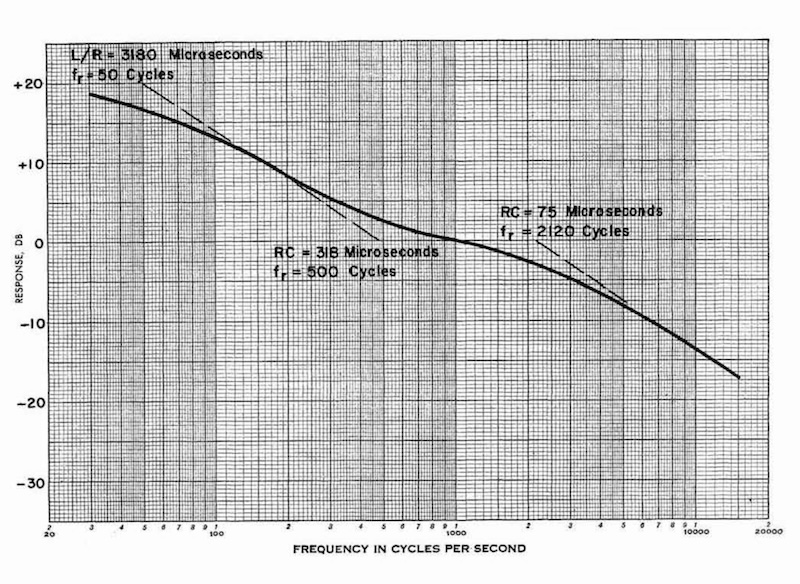
source: “The Proposed AES Standard: Standard Playback Characteristic For Lateral Disk Recordings”, Journal of the Audio Engineering Society, Vol. 2, No. 1, January 1954, pp.3-7.
グラフの定義域は 30Hz〜15,000Hz
25.8.3 RIAA Standard Recording and Reproducing Characteristic (1954)
放送局の組織である NAB / NARTB、オーディオ工学の学会である AES、これらとは独立して、当時の米国レコード業界の団体である RIAA(Recording Industry Association of America, 全米レコード工業協会)が1952年に発足( Pt.18 セクション 18.5.1)、翌年の1953年に RIAA 技術委員会が組織された( Pt.18 セクション 18.5.5)。
In 1952, the Recording Industry Association of America (RIAA), an organization of the U.S. record industry which was independent of the NAB / NARTB (an organization for broadcasting industry) and the AES (academic society of audio engineering), was formed ( Pt.18 Section 18.5.1). Then the RIAA Technical Committee was organized the following year in 1953 ( Pt.18 Section 18.5.5).
この技術委員会では、当時の米国5大レーベルを代表するチーフエンジニア、Edward H. Uecke (Capitol)、William S. Bachman (Columbia)、Charles Lauda (Decca)、H.I. Reiskind (RCA)、C. Robert Fine (Fine Sound Studios, Mercury 代理) が緊密に連携、1年かけて調査や議論を行った( Pt.18 セクション 18.5.5)。その結果、1954年1月29日、RIAA 標準録音再生特性 (1954) として承認され、RIAA Bulletin E1 として発行された( Pt.18 セクション 18.5.6)。これは 1953 NARTB や 1954 新 AES と同じ録音再生特性であった。
This technical committee consisted of chief engineers representing the five U.S. major labels at the time: Edward H. Uecke (Capitol), William S. Bachman (Columbia), Charles Lauda (Decca), H.I. Reiskind (RCA), C. Robert Fine (Fine Sound Studios, proxy for Mercury). These five sages worked closely together, conducting research and discussions over the course of a year ( Pt.18 Section 18.5.5). The result was approved as the RIAA Standard Recording and Reproducing Characteristics (1954) on January 29, 1954, and published as RIAA Bulletin E1 ( Pt.18 Section 18.5.6). This was the same recording / reproducing characteristics as the 1953 NARTB and the 1954 new AES.

この顔ぶれは文字通り錚々たるものだね。78回転時代〜LP時代に偉大な功績を残した凄腕エンジニアばかり。
This list is literally a who’s who of engineers who made great achievements in the 78 rpm to LP era.
そうだね、サファイア・グループ〜AES などのお陰もあり、生粋のエンジニア達は、自由闊達に議論が行える、そんな雰囲気が出来上がっていたんだろうね。
Yes, thanks to the Sapphire Group, Audio Engineering Society, etc., genuine engineers were able to discuss freely and openly, and such an atmosphere was created.

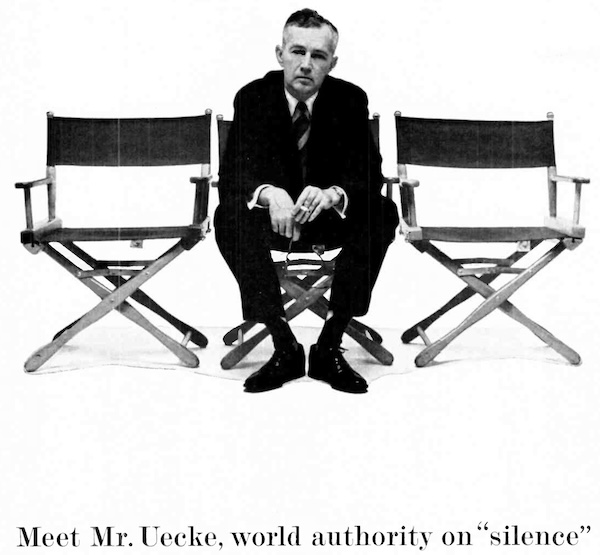
Edward H. Uecke, Chief Engineer, Capitol Records
source: High Fidelity, Oct. 1955, p.121.
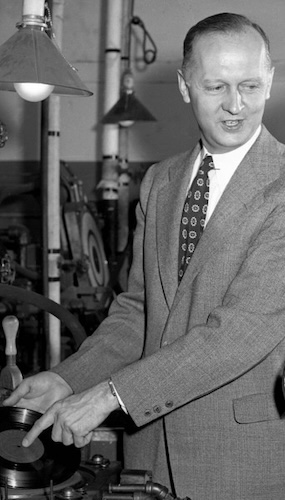
William S. Bachman, Chief Engineer, Columbia Records
(from Discogs contributed image)
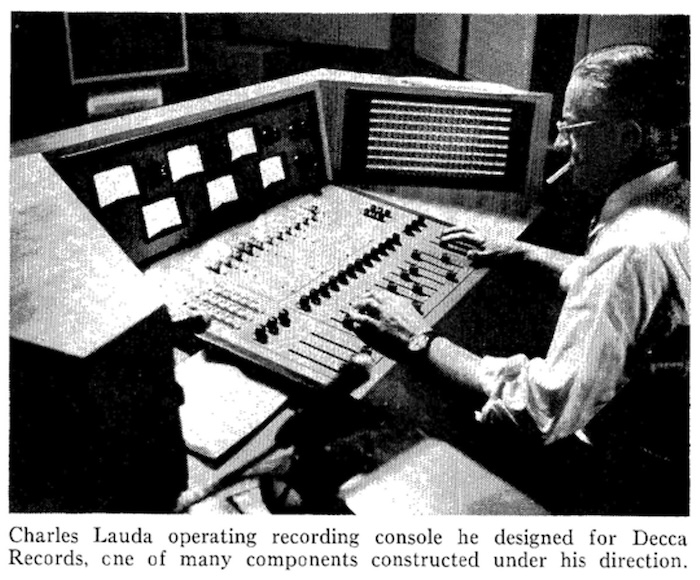
Charles Lauda, Chief Engineer, Decca Records (U.S.)
source: Journal of the AES, Jan. 1966, p.96
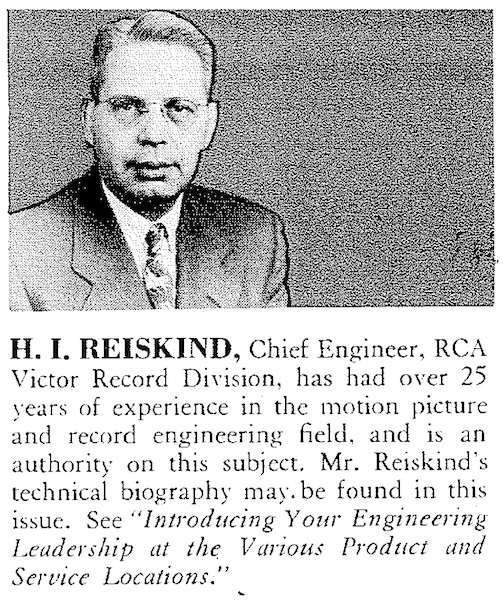
H.I. Reiskind, Chief Engineer, RCA Victor Record Division
source: RCA Engineer, Vol. 1, No. 1, June-July, 1955, p.48
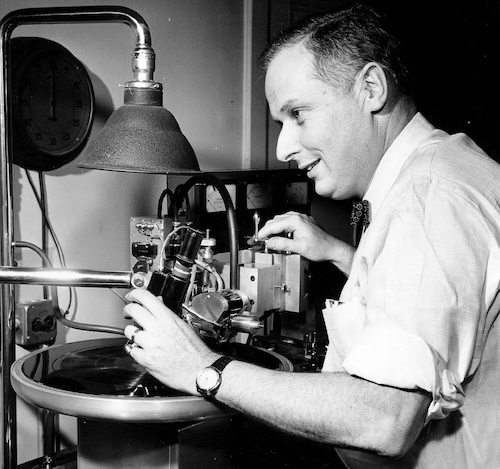
C. Robert Fine, Fine Sound Studios (proxy for Mercury Record Corporation)
source: producenci (C. Robert Fine)
この RIAA 録音再生規格においても、1953 NARTB 録音カーブや 1954 新AES再生カーブと同様、75μs、318μs、3,180μs、の3つの時定数が明記され、録音再生特性が厳密に定義された( Pt.18 セクション 18.5.6)。1978年 Bulletin E4 付属のグラフの定義域は 20Hz〜20,000Hz であるが、オリジナルの1954年 Bulletin E1 では 30Hz〜15,000Hz だった可能性もある(未確認)。ただし、Westrex RA-1703 インプットアンプの付属文書には、オリジナルの1954年 Bulletin E1 を参考にして書かれたと思われる箇所があり、こちらでは定義域が 30Hz〜15,000Hz となっている。
As with the 1953 NARTB Recording curve and the 1954 new AES Playback curve, the RIAA recording and reproducing characteristics also specified three time constants, 75μs, 318μs, and 3,180μs, which enabled the strict definition of recording characteristics ( Pt.18 Section 18.5.6). The graph accompanying the 1978 Bulletin E4 defines the range as 20Hz to 20kHz, but the original 1954 Bulletin E1 may have had a range of 30Hz to 15kHz (not confirmed yet). However, the document that came with the Westrex RA-1703 input amplifier contains a section that apears to be based on the original 1954 Bulletin E1, in which the frequency range is defined as 30Hz t0 15kHz.

source: “Appendix C: The R.I.A.A. Frequency Response Characteristic for Disc Recording”.
Westrex RA-1703 インプットアンプ(RIAA録音イコライザ内蔵)の付属文書より
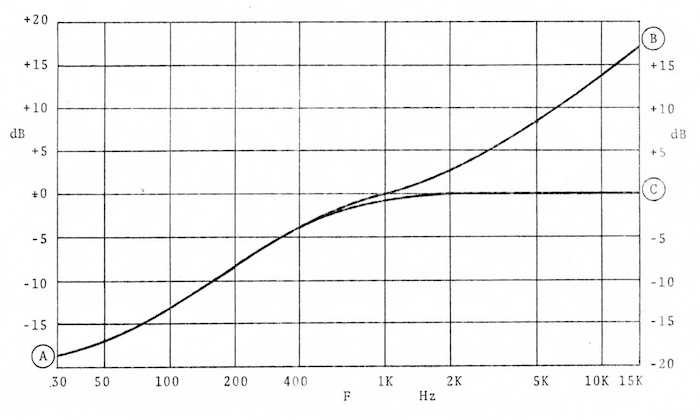
source: “Appendix C: The R.I.A.A. Frequency Response Characteristic for Disc Recording”.
Westrex RA-1703 インプットアンプ(RIAA録音イコライザ内蔵)の付属文書より
グラフの定義域は 30Hz〜15,000Hz

その、1954年に発行されたオリジナル Bulletin E1、現存するならぜひ見てみたいね。
We would love to see that original Bulletin E1 from 1954, if it still exists.
そうだよね。頑張って探したけど、見つけられなかったんだ。
Definitely. I tried so hard to find it, but I couldn’t.

25.9 After The Standardization
やっと規格が策定された1954年以降、業界はどのように進んでいったか、その頃にマスタリングスタジオで使用されていたディスク録音機材はどのようなものであったか、にまつわるあれこれ。1954年以降、1958年ないし1959年あたりの話です。
This section deals with this and that concerning how the industry had progressed since 1954, when the RIAA Standards was finally established. Also, it deals with the disc recording equipment used in the mastering studios at that time. The timespan is from 1954 to 1958 or 1959.
25.9.1 Gradual Transition to RIAA
1954年1月29日に RIAA 標準録音再生特性(RIAA Standard Recording and Reproducing Characteristics)が策定されたが、米国の RIAA 所属レーベルがある日を境にして一斉に新規格に切り替えたわけではなかった。その理由には大きく2つが考えられる。
The RIAA Standard Recording and Reproducing Characteristics was established on January 29, 1954, but U.S. labels affiliated with the RIAA did not all switch to the new standard on that day. There possibly are two main reasons for this.
[1] 製造済在庫の問題:録音特性切替前にカッティングされたラッカー由来のスタンパーでプレスされた盤は、当然機材切替前の記録特性であり、プレスされた在庫がなくなり再カットされるタイミングで初めて、機材切替後の記録特性となる。そのため、RIAA 採用後であっても、RIAA 以前のカーブでカッティングされた旧盤も混ざって市場に流通していた時期が存在するため。よって、「RIAAへの切替」とは、新規カッティング・再カッティング時のRIAA録音特性適用時期を指す。
[1] Problem of pre-production stock: Discs pressed with stampers from the lacquers that were cut before the switch in recording characteristics naturally have the old recording characteristics, and only when the pressed stock runs out and is re-cut, do they have the new recording characteristics. Therefore, even after the adoption of RIAA, there was a time when old discs cut with pre-RIAA curves were mixed together and distributed in the market. Accordingly, “the switch to RIAA” means the time of the application of RIAA recording characteristics for cutting new lacquers (and for recutting).
[2] 録音機器交換のコストの問題:ディスク録音イコライザは特性が固定であり、再生用可変フォノイコのように各種パラメータから選択可能ではないため、録音イコライザの交換が必要であった。特に全米各地にマスタリング設備を持つ大手レーベルでは、社内に独自の共通技術プラクティスを持っており、全施設で統一的に置き換えるのにはコストも手間もかかるからであった。また、単に録音イコライザを交換すれば終わり、ではなく、テストカッティングによる計測、セッティングの微調整、の繰り返しによって安定した記録特性を確保、今まで培ってきた技術プラクティスやノウハウをいちから作り直す、といった作業も必要であったから。
[2] Cost problem of replacing recording equipment: Disc recording equalizers have fixed characteristics and are not selectable from various parameters like variable phono preamps for playback. In particular, major labels with mastering facilities throughout the U.S. have their own common in-house technical practices, and it would be costly and time-consuming to replace them uniformly at all facilities. Moreover, it was necessary to ensure stable recording characteristics through repeated test cutting measurements and fine-tuning of settings, and to rebuild from scratch the engineering practices and know-how that had been cultivated up to this point.

いろんな録音特性を切替可能な、可変録音イコライザってのはなかったんだろうか?
I wonder if there was a variable recording equalizer that could be used to switch between various recording characteristics?
マイクログルーヴ盤登場以前は、通常の78回転盤向けの特性(500Hzターンオーバー、ゆるめの高域プリエンファシス、ベースシェルフなし)、トランスクリプション盤向けの NAB(500Hz ターンオーバー、100μs高域プリエンファシス、3,180μsベースシェルフ)の切替程度は一部の機器、例えば Presto カッターヘッド専用のカッティングアンプ Presto 88-A や 92-A などにはあったみたいだけど、録音スタジオでは通常はディスク録音イコライザに可変要素があることを嫌っただろうから、固定回路のものが多かったみたいだね。
Prior to the advent of microgroove records, a few models were able to switch between the characteristics for regular 78 rpm records (500Hz turnover, loose high-frequency pre-emphasis, no bass shelf) and NAB for transcription discs (500Hz turnover, 100μs high-frequency pre-emphasis, 3,180μs bass shelf). For example, the Presto 88-A and 92-A cutting amplifiers dedicated to the Presto cutterhads had such switches. In general, however, recording studios did not usually like to have variable elements in their disc recording equalizers, so many of them had fixed circuits.


そっか、やっぱりなかったんだ。
That makes sense. So there wasn’t such an instrument after all.
実は唯一、Electronics誌1954年9月号で(写真なしの文章だけで)紹介された、Fairchild 639 録音イコライザ というものがあって、「AES」「LP」「NARTB」「フラット」「中間」という5ポジションを備えた機器なんだそうだ( Pt.19 セクション 19.1 コラム)。ところがなんと、この Fairchild 639 は、この短い記事以外に情報が皆無で、現物写真もパンフレットも取説も確認されていないため、本当に製造されたのか、現時点では不明なんだ。
To be honest, the only known device, the Fairchild 639 recording equalizer, which had five positions — “AES”, “LP”, “NARTB”, “FLAT” and “Intermediate” — was featured (in text only, without pictures) in Sep. 1954 issue of the ELectronics magazine ( Pt.19 Section 19.1 Column). However, there is no other information on this Fairchild 639 other than this short article, and since no actual photo, brochure, or instruction manual has been found, it is unknown at this time if it was ever really manufactured.


なるほどね。ところで、録音イコライザを自作したエンジニアってのはいなかったんだろうか。
I see, by the way, were there any engineers who designed and developed recording equalizers by themselves?
RIAA策定前は、何もかもが手探りだったから、むしろそういうスタジオも少なくなかったみたいだね。けど、録音アンプや録音システムに内蔵されるようになってからは、当時は性能も日進月歩だったから、専門メーカ製造機器に切り替えていっただろうね。
Before the RIAA Standard was established, everything was still in the exploratory stage, it seems that there were many such studios. However, once the Standard was formulated, recording amplifiers and recording systems began to incorporate these devices, they would have switched to devices made by specialized manufacturers, as performance was advancing rapidly at that time.

RIAA 規格策定以前から RIAA と同じ録音特性を使用していたのは、1952年8月から New Orthophonic (= RIAA) を使っていた RCA Victor、そして1953年秋ごろから1954年頃にかけてすでに New Orthophonic 相当に切り替えを行なっていたとされる Capitol、そしてこの両者にマスタリングとプレスを委託していたレーベルであった( Pt.20 セクション 20.1.1)。ただし、Capitol が RIAA に移行したのは1955年頃である、とする説もあることに注意。
The labels that used the same recording characteristics as RIAA before the RIAA standard was established was: RCA Victor, which had been using New Orthophonic (=RIAA) since August 1952; Capitol, which had already switched to the New Orthophonic equivalent from around the fall of 1953 to 1954; and labels that outsourced mastering and pressing to either of these labels ( Pt.20 Section 20.1.1). Please note, however, that there is a theory that Capitol switched to RIAA around 1955.
Columbia LP カーブを使用していた Columbia は、1954年8月時点では全マスタリング設備のうち RIAA に移行済なのは半数に満たず、全て RIAA 録音特性の機材に切替完了にはまだ半年以上かかる見込み、という当時の(関係者へのインタビューを元にした)記事が確認できる( Pt.20 セクション 20.1.5)。また、1955年2月からは、Columbia のリリースする45回転シングル盤の多くが CSL(Columbia Standard Level)という技術標準に準拠した、コンプレッションをかけて音圧を一定にする措置が取られていたが、この CSL の放送局向けサンプル盤 (Columbia ZRD-429-1A/ZRD-431-1A) には「Columbia 標準特性(RIAA/NARTB 業界標準の通り)で再生すること」と明記されている( Pt.20 セクション 20.1.6)。よって、遅くとも1955年中には、Columbia は全設備の RIAA への移行が完了していたと考えるのが自然である。そして、Columbia にマスタリングとプレスを委託していたレーベルもまた、Columbia の移行タイミングに準じることとなる。
Columbia, which used Columbia LP curve, reported in the article of August 1954 (based on interviews with those involved) that less than half of is mastering facilities had been converted to RIAA, and that it would take six months or more to complete the switchover to RIAA recording equipment ( Pt.20 Section 20.1.5). In addition, from February 1955, many of Columbia’s 45 rpm single releases were subjected to the CSL (Columbia Standard Level), a technical in-house standard that applies compression to keep the sound pressure constant, but the label of the CSL promotion record for broadcast stations (Columbia ZRD-429-1A/ZRD-431-1A) clearly states that it should be played with “Columbia Standard Characteristic, as per R.I.A.A.-N.A.R.T.B. industry norm”.
1951年頃から AES 再生カーブにあわせた録音カーブを採用していた Mercury(正確には、Mercury が主に使用していた Fine Sound Studios や Mercury Sound Studios)は、1954年10月頃に RIAA に切替が完了したという説が一般的である。クラシックの Living Presence LP では MG-50026 まで、ポピュラーシングル盤ではマトリクス番号 YB9700 あたりまで、が AES で、それ以降は原則として RIAA となっている、という意見もあるが、客観的に証明する資料は公になっていないため、当時の記事からの判断、および聴感による判断と思われる。なお、1950年代中頃当時の Mercury は、マスタリング(カッティング)は Fine Sound Studios や Mercury Sound Studios で行われ、プレスは RCA Victor や MGM に委託していた。
It is generally believed that Mercury (or more precisely, Fine Sound Studios and Mercury Sound Studios, both of which were mainly used for mastering by Mercury), which had adopted a recording curve that matched the AES Playback Curve from around 1951, completed the switchover to RIAA in around October 1954. Some say that AES was used for classical “Living Presence” LPs up to MG-50026, and for popular singles up to matrix number YB 9700 or so, and that RIAA was used thereafter as a general rule. However, since there is no objective data available to the public (yet), it is considered to be a judgement based on the articles of the time, as well as a judgement based on subjective listening. Incidentally, in the mid-1950s, Mercury’s mastering (cutting) was done at Fine Sound Studios and Mercury Sound Studios, and the pressing was outsourced to RCA Victor and MGM.
米 Decca、MGM などその他の主要レーベルや、自社でマスタリング(カッティング)をしたのちプレス委託をしていた多くのマイナーレーベルについては、概して1954年〜1956年頃までには RIAA に移行したとされているが、確たる情報や資料がないため、正確なことが分かっておらず、諸説ある。
Other major labels such as U.S. Decca and MGM, as well as minor labels that did mastering by themselves then outsourced for pressing, are said to have generally transitioned to RIAA by 1954-1956, but due to a lack of reliable information and documents, this is not known with certanty, and there have been various theories.

特定のレコードがどの特性で記録されたか、を客観的に調べる方法がほとんどない上に、「そのラッカー盤はどのマスタリングスタジオでカッティングされたか」も調査しないといけないわけか〜。
There is few objective way to find out which characeristics were used for a particular pressing, and we also have to investigate “which mastering studio was used to cut the particular lacquer” — right?
そうなんだ。先述の通り、この時期にはすでにテープ録音になっていたから、いろんなパターンが考えられることになる。[1] 大手レーベルのように、自社スタジオで録音、自社スタジオでミキシング、自社スタジオでマスタリング(カッティング)、自社プレス工場でプレス、というパターン。[2] マスタリング(カッティング)を行ってから、ラッカー盤を大手レーベルのプレス工場に送り、プレスだけしてもらうパターン。[3] テープを送付し、マスタリング(カッティング)もプレスも行ってもらうパターン。ある盤の録音特性を考えるヒントになるのは、いつ、どのマスタリングスタジオで、誰によってカッティングされたか、だから、いわゆるマトリクス情報を丹念に調査していくしかないわけだね。
Absolutely. As mentioned earlier, tape recording was already widespread during this period, so various patterns are possible: [1] like the major labels, recording at their own studios, mixing at their own studios, mastering (cutting) at their own studios, and pressing at their own pressing plants; [2] after mastering (cutting), send the lacquer discs to the major label’s pressing plant and have them pressed; [3] send the tapes to the major label then have them mastered (cut) and pressed. The only way to get a cloue to the recording characteristics for a particular copy is to carefully investigate the so-called “matrix information”, which tells us when the tape was cut, at which mastering studio, and by whom.

マイナーレーベルの中には、主に予算の都合上で、既存のマスタリング機材(すなわち古い録音特性)を使い続けたところもあったと推測される。しかし遅くとも、ステレオ盤の規格が 1958年に 45/45 方式に決定し、ステレオ盤マスタリング対応のために機材を入れ替えるタイミングで RIAA に移行した、と考えられる。
It is assumed that some minor labels continued to use their existing mastering equipment (i.e. old recording characteristics), mainly for budget reasons. However, it is believed that they switched to RIAA at the latest when the standard for stereo recordings was decided to 45/45 in 1958, and they replaced their equipment to accommodate stereo recording and mastering.
25.9.2 Recording System in 1950s to 1970s
RIAA 規格策定以前は、500Hz ターンオーバーのカッターヘッドを前提にして、高域プリエンファシスやベースシェルフ、またはその両方を追加する単体録音イコライザをチェーンに挿入するのが一般的であった。
Prior to the formulation of the RIAA Standards, it was common practice to insert a standalone recording equalizer into the recording chain that added high-frequency pre-emphasis and/or bass shelf, assuming a cutterhead having 500Hz turnover characteristics.
そのような録音イコライザは、[1] 自社によるカスタム開発で、自社で録音特性を決めたもの、[2] Cinema Engineering や RCA など、固定特性の録音イコライザを製造販売していたメーカから購入したもの、 [3] Cinema Engineering など一部の製造メーカに、所望の録音特性を伝えカスタム製造してもらったもの、のいずれかであった。当時は、パッシブ LCR 型録音イコライザが一般的であった。
Such recording equalizers were either: [1] custom-developed by the company itself and the recording characteristics were determined in-house; [2] purchased from manufacturers such as Cinema Engineering or RCA who manufactured and sold recording equalizers with fixed characteristics; or [3] custom manufactured by some manufacturers such as Cinema Engineering. At that time, passive LCR recording equalizers were common.

例えばこれは、1950年代初頭の Cinema Engineering Type 4137 Orthacoustic Equalizer の特性で、100μs高域プリエンファシスのみ付加するパッシブLCRイコライザだね。
For example, this is the characteristics of the Cinema Engineering Type 4137 Orthacoustic Equalizer, a passive LCR equalizer from the early 1950s that adds only 100μs high-frequency pre-emphasis.
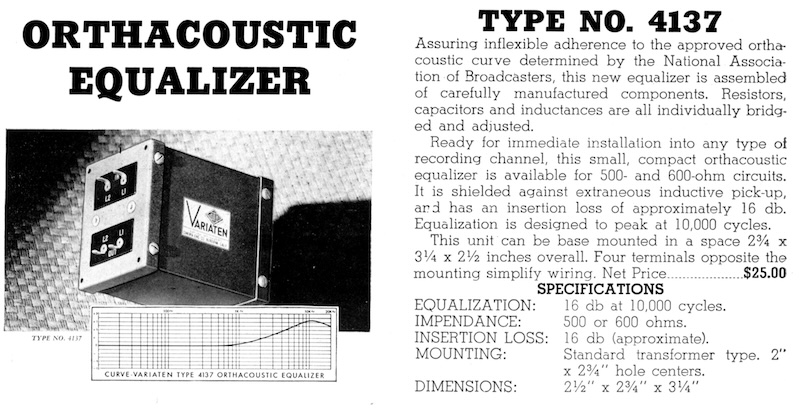
source: Cinema Engineering Company Catalog No. 10 (possibly in 1950?)
当時を代表するディスク録音用パッシブLCRイコライザ。これは Orthacoustic (NAB) 用録音EQ だが、高域プリエンファシス側のみで、ターンオーバー以下の6dBスロープは、カッターヘッドの特性で実現し、100Hz以下の重低域ターンオーバーは別回路で実現する。当時はフラットレスポンスのフィードバックカッターヘッドがまだ一般的ではなかったため。
This fixed passive LCR Equalizer was for NAB’s high frequency pre-emphasis only: 6dB droop under the turnover frequency was acomplished by the cutterhead’s response characteristic; low-bass turnover (aka “bass-shelf”) under 100Hz was added with extra circuits. Feedback cutter system with flat response was not yet common at that time.
そうだね。そしてこれが、1954年以降に登場した、Cinema Engineering Type 7095 Recording Equalizer / Type 7087 Playback Equalizer で、1953 NARTB / 1954 新AES / 1954 RIAA の特性を単体で実現する、パッシブLCRイコライザだね。この時期になると、カッターヘッドのフラット特性を前提とした録音イコライザであることがわかるね。
Yes it is. And this is the Cinema Engineering Type 7095 Recording Equalizer and Type 7087 Playback Equalizer, which was a passive LCR equalizer and was introduced after 1954, to provide 1953 NARTB / 1954 new AES / 1954 RIAA characteristics on its own. At this time, you can see that the recording equalizer assumes the flat characteristics of the cutterheads.

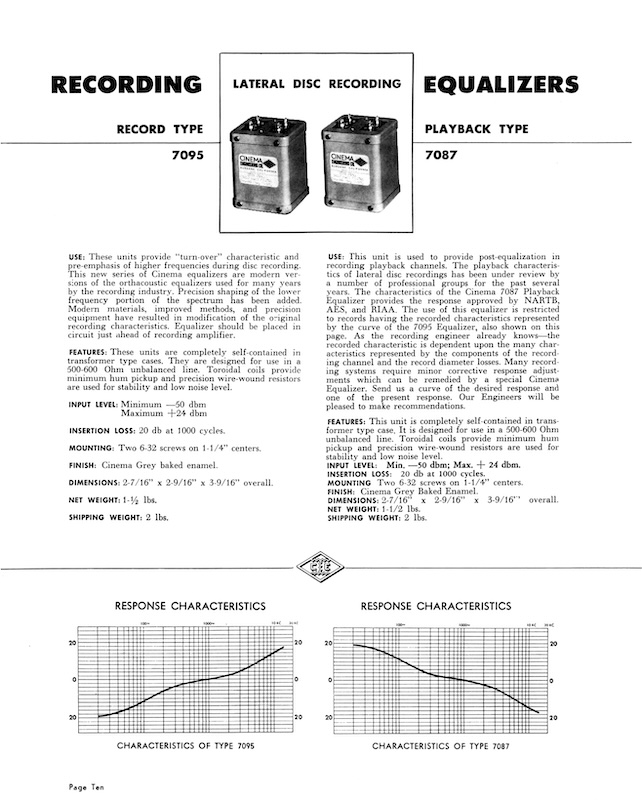
source: Cinema Engineering Company Catalog No. 12EC (possibly in 1954?)

1940年代に RCA が放送局用に出していた NAB 録音特性用の Recording Filter MI-4916-A の場合は?
What about the MI-4916-A Recording Filter, which RCA released in 1940s for broadcast stations to realize NAB recording characteristics?
RCA MI-11850-C という RCA のカッターヘッドが、裸特性でターンオーバー1000Hzになっていたんだけど、MI-4916-A はこれを補正して 500Hz ターンオーバーにし、100μs高域プリエンファシスと3,180μsベースシェルフを付加する、この全てをオールインワンのパッシブLCRユニットで実現するものだね。
The RCA MI-11850-C cutterhead had a bare characteristic with turnover at 1,000Hz, but the MI-4916-A corrects this to a 500Hz turnover, adds 100μs high-frequency pre-emphasis and a 3,180μs bass shelf, all of these in an all-in-one passive LCR unit.

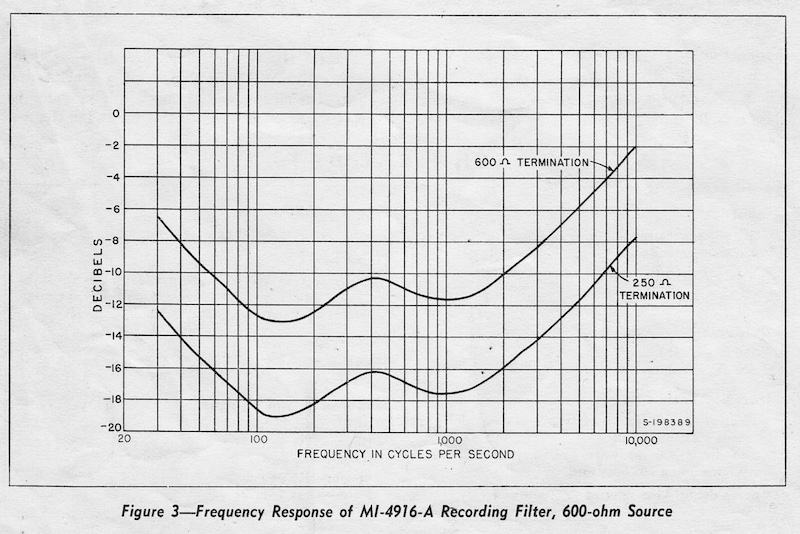
source: “Instructions for Recording Filter MI-4916-A”, p.2
1950年頃の取説に記載された、MI-4916-A 録音フィルタ自体の周波数特性グラフ
RIAA 規格が策定された頃から、Westrex / Fairchild / Gotham などディスクマスタリング機材を製造するメーカからディスク録音システムが続々登場し、全米のレーベルやマスタリング(カッティング)工場で続々と採用されていった( Pt.19 全体)。
Around the time the RIAA Standard was established, disc recording system began to appear one after another from amnufacturers of disc mastering equipment such as Westrex, Fairchild and Gotham, and were adopted one after another by labels and mastering (cutting) plants across the United States ( throughout Pt.19.)
これらのシステム構成では、録音イコライザが単独ユニットではなく、システム全体内に分散して RIAA 固定イコライザ(高域プリエンファシスのみ較正用にON/OFF可能)が巧妙に実装されていた( Pt.19 全体)。
In these system configurations, the recording equalizers were not standalone units, but were cleverly implemented with RIAA fixed equalizers (only the high-frequency pre-emphasis could be turned on and off for calibration) distributed throughout the system ( throughout Pt.19).

標準規格が策定されたことで、ディスク録音イコライザというユニットが録音チェーンに挿入する独立機器ではなくなり、カッティング関連機器メーカは標準規格に準拠した録音イコライザをシステムに内蔵し始めた、ってわけか、なるほど。
With the establishment of the standard, the disc recording equalizer unit was no longer a standalone device inserted into the recording chain, and manufacturers of cutting-related equipment had begun to incorporate standard-compliant recording equalizers into their systems, right?
例えば、1954年頃製造と言われる Westrex RA-1514 はかろうじて、独立したパッシブ LCR 録音イコライザで、米国向けの RIAA/NARTB ポジションと英国・欧州向けの CCIR (DIN) ポジションとの切替式も存在していたようだね( Pt.19 セクション 19.2.4)。Westrex の次のシステム RA-1574 あたりから、録音システム内に組み込まれるようになった、というところかな。
For example, the Westrex RA-1514, said to have been manufactured around 1954, was one of the last independent passive LCR recording equalizers, and it seems to have been switchable between the RIAA/NARTB position for the U.S. and the CCIR (DIN) position for the UK and Europe ( Pt.19 Section 19.2.4). Then, from the next Westrex system RA-1574, recording equalizers were gradually integrated into the recording system.


当時のスタジオでの具体的な使用例は知られてるのかな?
Are there any known specific examples of studio use at the time?
最も有名なのが、Rudy Van Gelder スタジオ で、1954年末〜1955年初頭に、Grampian/BBC Type B1/AGU カッターヘッド + Gotham PFB-150WA アンプに切り替えたことが知られているね( Pt.18 セクション 18.1.5)。このアンプは、Van Gelder 氏が 「より大音量でダイナミクス大きくカッティングできるアンプを開発してほしい」と Gotham Audio に依頼したものだそうだ。そして、この PFB-150WA アンプの内蔵録音イコライザは、もちろん RIAA 録音特性が前提だったんだ。ちょうどその時期の1955年10月のインタビューで「自分は標準規格であるRIAAを使用している」と発言してるね( Pt.20 セクション 20.1.7)。さらに、氏はその後ステレオ時代に入ると Fairchild 641 システムを、1965年頃からは Westrex 3D カッターヘッドを含む Westrex システムを、それぞれ使用していたことが知られているね。
The most famous example is Rudy Van Gelder Studio, where he switched to a Grampian/BBC Type B1/AGU cutterhead + Gotham PFB-150WA amplifier in late 1954 or early 1955 ( Pt.18 Section 18.1.5). Mr. Van Gelder asked Gotham Audio to develop an amplifier that could cut louder and with greater dynamics. The built-in recording equalizer of the PFB-150WA amplifier was, of course, based on the RIAA Recording Characteristics. He also stated in an interview right around that time in Oct. 1955, that “in my case, I use the standard RIAA curve”. It is also known that Mr. Van Gelder later used a Fairchild 641 system in the stereo LP era, followed by the Westrex system with Westrex 3D cutterheads from around 1965.


他にもある?
Are there any other examples?
Lou Reed の「Berlin」や Gregg Allman の「Laid Back」のエンジニアとして著名な Jim Reeves 氏が、1960年代末〜70年代前半当時の Columbia Recording Studios の内部写真を公開してくださっているサイトがあって、そこでは Sculley カッティングレースやカスタムメイドのコンソールと共に、Westrex の青色の機器(Westrex 1700 システム)が写っているのが確認できるよ。
Mr. Jim Reeves, famous engineer for Lou Reed’s “Berlin” and Gregg Allman’s “Laid Back”, has posted many interior photos of Columbia Recording Studios in the late 1960s and early 1970s. There you can see a lot of Westrex blue equipment (i.e. Westrex 1700 system) along with Sculley cutting lathes and custom-made consoles.


なるほど。ともあれ、1950年代末頃からディスク録音システムがますます統合型になっていったんだね。
I see. Anyway, since the end of the 1950s, disc recording systems have become increasingly “integrated”.
そうだね。そして、システム内の回路をわざわざ改造して非RIAA録音特性を実現するのは非現実的だし、シングル盤向けに改造された例は確認されているけど、これは例外的と言える。そういったことから、これらの録音システムが導入されたタイミングで記録特性が自然と RIAA に切り替わったと考えるのが最も自然じゃないかな。
Exactly. And it would be impractical to go to the trouble of modifying the circuitry in the system to achieve non-RIAA recording characteristics, and while there are confirmed cases (which were very rare) of modifications made for single records, these are the exception. Therefore, it is most natural to assume that the recording characteristics naturally switched to RIAA at the time these recording systems were introduced, I guess.

具体的には、カッターヘッド記録特性を完全にフラットに補正する回路、500Hz ターンオーバーを実現する回路、75μs高域プリエンファシスを実現する回路、3,180μsベースシェルフを実現する回路、これらが複合的に組み合わされ、録音システムの各所に分散して実装され、RIAA 録音特性を実現していた。
Specifically, a circuit that corrects the cutterhead’s bare characteristics to completely flat, a circuit that realizes 500Hz turnover, a circuit that realizes 75μs high-frequency pre-emphasis, and a circuit that realizes 3,180μs bass shelf, all of which are combined and distributed throughout the recording system and implemented in various locations to achieve RIAA recording characteristics.

ところで、さっき上で、Westrex 3D フィードバックカッターはフラット特性でなかった、と言ってたけど、それをどうやって RIAA 録音特性にしていたんだろう?
By the way, you said earlier above that the Westrex 3D feedback cutter was not flat characteristics, how did it achieve RIAA recording characteristics?
まず、RA-1574-D というパワーアンプの中に装着されたプラグインカード上の回路によって、Westrex 3D の特性を補正するんだ。3D カッターヘッドの特性には個体差があるから、このプラグインカード上の可変抵抗で微調整できるようになっていて、テストカットなどをして 500R-FLAT(500Hzターンオーバー、ベースシェルフ3,180μs、高域プリエンファシスなし)になるよう較正するわけだね( Pt.19 セクション 19.2.5)。
First, the circuitry on the plug-in card installed in the RA-1574-D power amplifier corrects the characteristics of the Westrex 3D cutterhead, which can be fine-tuned with the variable resistors on the card, since the characteristics of the 3D currehead vary from one unit to another. Then you calibrate to 500R-FLAT (500Hz turnover, 3,180μs bass shelf, no high-frequency pre-emphasis) by making test cuts ( Pt.19 Section 19.2.5).


あれ、高域プリエンファシスはどこいった?
Hey, where’s the high-frequency pre-emphasis?
RA-1574-D パワーアンプ内に75μs高域プリエンファシスを実現する回路が別にあって、ON/OFF スイッチで切り替えられるようになっていたんだ。OFF はテストカッティングによる記録特性チェックの較正用、ON は通常のカッティング用、ってことだね( Pt.19 セクション 19.2.5)。
There was a separate circuit in the RA-1574-D power amplifier that provided 75μs high-frequency pre-emphasis, which could be toggled on and off with an ON/OFF switch, OFF being for calibrating the recording characteristics check by test cutting, and ON being for ordinary cutting ( Pt.19 Section 19.2.5).


なるほど、カッターヘッドの記録特性をフラットにし、ターンオーバーとベースシェルフを付加する回路があって、高域プリエンファシスはアンプで付加される、という構成だったのか。システム全体が、完全に RIAA 録音特性前提で設計されている感じがするね。そうじゃないと、録音システムのあっちこっちのユニットに録音イコライザが分散したり組み込まれてたりするわけないもんね。
I see… so the configuration was that there was a circuit that flattened the recording characteristics of the cutterhead, added turnover and bass shelf, and high-frequency pre-emphasis was added by the amplifier. It seems that the entire system was designed based completely on the RIAA recording characteristics. Otherwise, there wouldn’t be recording equalizers distributed here and there in the recording system.
そうだね。のちの Westrex RA-1703 インプットアンプでも類似の構成となっていたし( Pt.19 セクション 19.2.7)、1970年代の Ortofon GO-741 カッティングアンプ内でも巧妙な仕組みで RIAA 録音特性が達成されているよ(Pt.19 セクション 19.2.10)。
It was. A similar configuration was also used later in the Westrex RA-1703 input amplifier ( Pt.19 Section 19.2.7), and Ortofon GO-741 cutting amplifier in the 1970s, which achieve the RIAA recording characteristics by a clever mechanism (Pt.19 Section 19.2.10).


source: “Appendix C: The R.I.A.A. Frequency Response Characteristic for Disc Recording”.
Line AB is the RIAA characteristic of RA-1703, while line AC is the “response with the 75 μs high-frequency emphasis portion of the RIAA curve omitted, and is the response recorded with the switches on the RA1703 amplifiers in their FLAT position”.
Westrex RA-1703 インプットアンプ(RIAA録音イコライザ内蔵)の付属文書より
(A)〜(B) が RIAA 録音特性 (RIAAポジション)、(A)〜(C) は「RIAAカーブのうち 75μs高域増幅部分を割愛したもので、RA1703をFLATポジションにした時の特性」。

Fairchild の場合は?
What about Fairchild?
1958年登場の Fairchild 641 システムでは、643 ベータアンプで 500Hz ターンオーバーのみ実現、後段の 644 録音イコライザで 75μs高域プリエンファシスと 3,180μsベースシェルフが実現される、という2段構えで RIAA 録音特性にしていたんだ( Pt.19 セクション 19.2.3)。
The Fairchild 641 system, which appeared in 1958, had a two-stage RIAA recording equalizers, with a 641 beta amplifier providing only 500Hz turnover, and a 644 recording equalizer in the second stage providing 75μs high-frequency pre-emphasis and 3,180μs bass shelf ( Pt.19 Section 19.2.3).


じゃあ Neumann の場合は?
And what about and Neumann?
モノーラル時代の Neumann LV-60 パワーアンプでは、すべてパワーアンプ内部で実装し、高域プリエンファシス部分は交換可能なプラグインモジュールで 75μs (RIAA) / 50μs (DIN) / 較正用のフラット、を切り替えられるようになっていたんだ( Pt.19 セクション 19.2.8)。さらに、オペアンプ構成の近代的な Neumann VG-66 システムおよびそれ以降では、専用の録音イコライザユニットが RIAA 録音特性を実現していて、較正用に高域プリエンファシス 75μsの ON/OFF ができるようになっていたね( Pt.19 セクション 19.2.9)。
In the monaural Neumann LV-60 power amplifier, everything was implemented inside the power amplifier, and the high-frequency pre-emphasis portion could be switched between 75μs(RIAA), 50μs (DIN), and FLAT for calibration purpose, via interchangeable plug-in module ( Pt.19 Section 19.2.8). Furthermore, in modern Neumann VG-66 systems and later with op-amp configurations, a dedicated recording equalizer unit provided RIAA recording characteristics, and you could turn on/off the 75μs high-frequency pre-emphasis for calibration ( Pt.19 Section 19.2.9).


なるほど。いずれにせよ、再生側の可変フォノイコみたいにターンオーバーとロールオフ部分を自在に切り替えられる仕組みじゃなかったってことだね。
That makes sense. In any case, it wasn’t like a variable phono preamp on the playback side, where you can freely switch turnover and rolloff positions.
1950年代は、まだ自社開発の独自録音イコライザを使っていたところもあったかもしれないけど、いずれにせよ固定特性だっただろうね。さらに1960年代、ましてや1970年代には、Westrex / Ortofon / Neumann など既存の録音システムを原則そのまま使っていただろうからね。もし、あえて改造するなどして RIAA 以外の録音カーブを適用していたスタジオがあったとしたら、そのような改造済機器の存在が確認されそうなもんだよね。で、実際には確認されてない、と。
In the 1950s, some studios might have used their own proprietary recording equalizers, but they would have been fixed characteristics anyway. Furthermore in the 1960s, and even more so in the 1970s, they would have used existing recording systems such as Westrex / Neumann / Ortofon / etc. as is. If there were studios that dared to use non-RIAA recording curves, it would be possible to confirm the existence of modified gears. But in fact, such gears have not been confirmed.

RCA Victor は New Orthophonic 導入当初、録音イコライザを自社開発しており、現存する当時の回路図からパッシブ LCR 回路であることが確認できる( 2022 ARSC Conference における Nicholas Bergh 氏の発表スライド、ARSC 会員のみ閲覧可能)。Columbia や Capitol は、資料は公になっていないが、やはり当初は自社製または Westrex 製パッシブ LCR 回路の録音イコライザを使用していたとされる。また、Western Electric (Westrex) 製マスタリングシステムでは、1960年代までやはり伝統的にパッシブ型 LCR 型録音イコライザが使用されていた。
RCA Victor developed its own recording equalizer when New Orthophonic was first introduced, and the surviving schematics from that time confirm that it was a passive LCR circuit ( slides presented by Nicholas Bergh at the 2022 ARSC Conference, available only to ARSC members). Columbia and Capitol are also said to have initially used its own (or Westrex’s) passive LCR recording equalization, although this information is not publicly available. Western Electric (Westrex) mastering systems also traditionally used passive LCR recording equalizers until the 1960s.

米国メジャーレーベルでは長らく、Bell Labs / Western Eletric のレガシーが生きていたってことなんだね。それにしても RCA Victor は本当に技術文書や資料がふんだんに現存し閲覧可能だなんて、すごいね。
So the legacy of Bell Labs / Western Electric has been alive for a long period of time among major U.S. labels. By the way, it is truly amazing that so many technical documents and materials of RCA Victor are still in existence and can be accessed.
RCA 研究開発部門には多分野に渡り名だたる研究者やエンジニアが所属していたし、ことあるごとに学会論文として発表していたりと、科学的工学的な側面がしっかりしていたのは頼もしいよね。
RCA’s R&D department was staffed by renowned researchers and engineers in many fields, and they were always presenting their work in conference papers, so it was encouraging to see that the scientific and engineering aspects of the company were strong.

そのため、これらでカッティングされたレコードの再生には、厳密には再生イコライザも LCR 型が望ましいが、RCA / Columbia / Capitol などでのプレス後の試聴などは民生用再生機器と同様の RC 型イコライザで行われていた。これは1960年代前半〜中頃まで続いたと考えられている( Pt.23 セクション 23.2)( 2022 ARSC Conference における Nicholas Bergh 氏の発表スライド、ARSC 会員のみ閲覧可能)。Neumann 製の録音システムが業界のデファクトスタンダードとなる頃には、ほぼ全ての録音イコライザがアクティブ RC/NF 型となっている。
Therefore, although LCR-type playback equalizers are strictly desirable for playback of records cut with these systems, the same RC-type equalizers as those used in consumer playback equipment were used for auditioning after pressing at RCA, Columbia and Capitol. This is believed to have continued until early to mid 1960s ( Pt.23 Section 23.2) ( slides presented by Nicholas Bergh at the 2022 ARSC Conference, available only to ARSC members). By the time Neumann recording systems became the de facto standard in the industry in the States, almost all recording equalizers were of the active RC/NF type.
25.10 Frequency Test Records
再生機器のチェックのほか、カッティング機器の微調整用のリファレンスとしても使われる周波数テストレコードは、1930年代頃から存在し、その時代時代にさまざまな目的を念頭にさまざまな特性で記録されたものが存在していました。そんなプロフェッショナルユースの周波数テストレコードのあれこれ。
Frequency test records, which are used not only for checking playback equipment but also as a reference for fine-tuning cutting equipment, have existed since around the 1930s, and were recorded with various characteristics with various purposes in mind at that time. This section deals with such frequency test records for professional use.
78回転盤時代から、プロフェッショナルユースの周波数テストレコードが多種製造されており、再生機器の厳密な応答特性チェックに使われたほか、カッティング機器の記録特性の厳密なチェックのリファレンスとしても現場で重宝された( Pt.21 全体)。1950年代後半には RCA Victor 12-5-49(New Orthophonic = 1954 RIAA)が、1960年代からは NAB Test Record(1964 NAB = 1954 RIAA = 1953 NARTB)が、それぞれ米国のマスタリングスタジオでの標準的なリファレンステストレコードとして使われていた( Pt.21 セクション 21.2.5 コラム)。
Since the 78rpm era, a wide variety of frequency test records were produced for professional use, and were used to check the exact response characteristics of playback equipment, and were also useful in the field as a reference for checking the exact recording characteristics of cutting equipment ( entire Pt.21). In the late 1950s, RCA Victor 12-5-49 (New Orthophonic = 1954 RIAA), and from the 1960s, NAB Test Record (1964 NAB = 1954 RIAA = 1953 NARTB) were used as standard reference test records in mastering studios in the U.S. ( Pt.21 Section 21.2.5 column).
いかなる録音特性を使うにしても、カッティング機材の微調整のために、リファレンスとなる記録がされている盤との比較が必要となるため、これらのプロフェッショナル向け周波数テストレコードの変遷を追っていくことで、当時マスタリングスタジオで使われていた主たる録音特性を間接的に推測することができる。
Whatever recording characteristics are used, a comparison with reference recordings is necessary for fine-tuning the cutting equipment. Therefore, it is possible to follow the evolution of these professional frequency test records and indirectly infer the primary recording characteristics used in mastering studios at the time.
これらの周波数テストレコードのほとんどは、78回転時代には、高域プリエンファシスとベースシェルフなし、ターンオーバーのみのカーブ、たとえば 500N-FLAT や 300N-FLAT で記録されていた。後年の RIAA 策定後には、ベースシェルフ込みのカーブ、たとえば 500R-FLAT で記録されているものが多くあった。これは、当時のカッティングシステムの較正用ポジションの特性と同一である( Pt.21 セクション 21.1 コラム1)。
Most of these frequency test records from the 78rpm era were recorded without high-frequency pre-emphasis nor bass shelf, but only with the turnover, such as 500N-FLAT and 300N-FLAT. On the other hand, many of the later test records after the RIAA Standard was established were recorded with curves including a bass shelf, e.g. 500R-FLAT. This is identical to the characteristics of the calibration positions of the cutting systems of the time ( Pt.21 Section 21.1 column 1).

なるほど、録音システム上の較正用ポジションと、全く同じ特性で記録されていたわけか。
I see, so it was recorded with exactly the same characteristics as the calibration position on the recording system.
78回転盤時代からそうだったみたいだね。一例として、Columbia 10004-M という12インチ78回転周波数テストレコードでは、1,000Hz 以下は NAB カーブ、1,000Hz 以上は定速度フラットになっていたことが、付属のグラフから明らかになっているね( Pt.21 セクション 21.2.2 コラム)。
It looks like this has been the norm since the 78 rpm era. For example, the accompanying graph plot of a 12-inch 78 rpm frequency test record, Columbia 10004-M, shows a NAB curve below 1,000Hz, and a constant velocity flat above 1,000Hz ( Pt.21 Section 21.2.2 column).

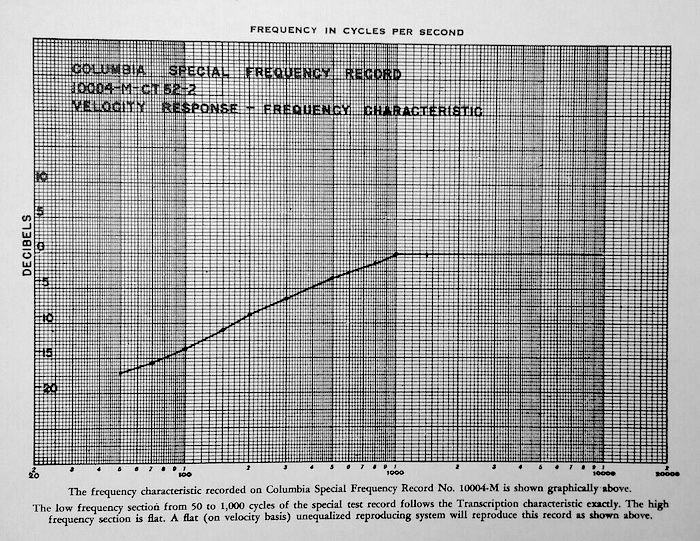
source: eBay listing by debbie6438 (retrieved: May 15, 2024).
“The low frequency section from 50 to 1,000 cycles of the special test record follows the Transcription characteristic exactly. The high frequency section is flat.”
例外的に、世界中で使われていた DENON XL-7001(日本国外輸出用は XL-7004)、その復刻である日本オーディオ協会 AD-1 は、250N-FLAT で記録されており、ライナーノーツには専用の再生イコライザの回路図が記載されている( Pt.21 セクション 21.3.8、セクション 21.1 コラム2)。カートリッジの応答特性計測などには、1kHz 以上、すなわち FLAT 部分だけが使われていた例がある( Pt.21 セクション 21.1 コラム1)。
Exceptions are the DENON XL-7001 (domestic) / XL-7004 (for export outside Japan), which had been used around the world, and its reissue Japan Audio Society AD-1, which was recorded in 250N-FLAT and includes a dedicated playback equalizer circuit diagram in the liner notes ( Pt.21 Section 21.3.8, Section 21.1 column 2). There are also examples where only the FLAT portion (i.e. above 1kHz) was used, e.g. for measuring cartridge response characteristics ( Pt.21 Section 21.1 column 1).
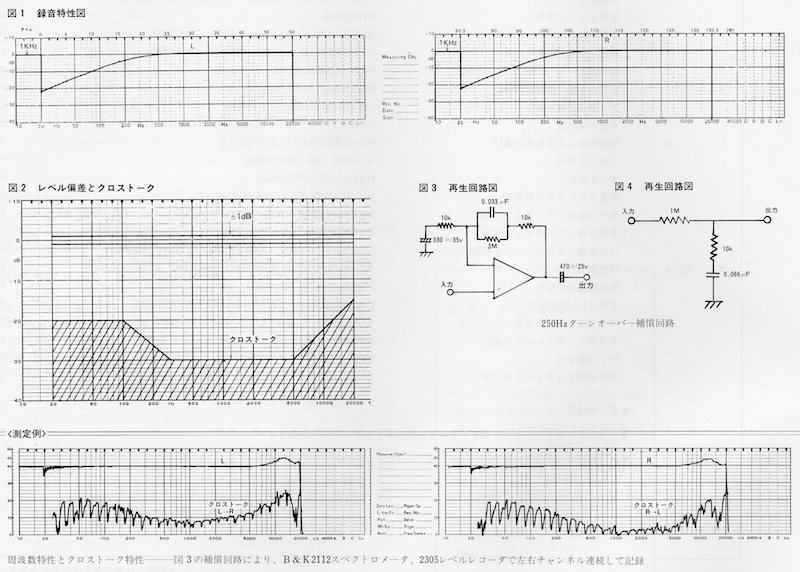
Recording Characteristics, Replay Compensator Circuits, and Frequency Response of DENON XL-7001 (XL-7004) Tracks A-1 & A-2
on the booklet of DENON XL-7001/3, from my own collection
XL-7001 A-1 と A-2 の録音特性カーブ(250N-FLAT)、専用の再生補償回路図、測定例が掲載されている
また、デモンストレーション用テストレコード、そして再生機器チェック用周波数テストレコードでは、全帯域が特定の録音特性で記録されている。特に後者については、RIAA 策定前は、NAB カーブ用、Columbia LP カーブ用、New Orthophonic カーブ用、英 Decca ffrr カーブ用、Bartók カーブ用などが存在した。しかし RIAA 策定後は RIAA カーブ用のものしか流通していなかった ことが確認できた( Pt.21 セクション 21.2 全体)。
In addition, in test records for demonstration purposes and frequency test records for checking playback equipment, all bands are recorded with specific recording characteristics. Especially for the latter discs, it was confirmed that before the RIAA was established, there existed records for the NAB curve, Columbia LP curve, New Orthophonic curve, U.K. Decca ffrr curve, Bartók curve, etc. However, after the RIAA was established, only those for the RIAA curve were in circulation ( Pt.21 Section 21.2).
興味深く珍しい例として、RIAA 策定前の1953年に出された Dubbings D-101 というテストレコードがあり、これは Columbia LP / RCA New Orthophonic / 1949 NARTB (NAB) / 1951 AES の4つの特性でテストトーンが記録されている( Pt.21 セクション 21.3.3)。切替式フォノイコを内蔵した当時のアンプの性能測定用を目的とした、オーディオ機器販売保守用の特殊なレコードと考えられる。
An interesting and unusual example is the Dubbings D-101 test record, issued in 1953, before the RIAA was established, which recorded test tones in four characteristics: Columbia LP, RCA New Orthophonic, 1949 NARTB (NAB) and 1951 AES ( Pt.21 Section 21.3.3). It is thought to be a special record for audio equipment sales and maintenance, intended for measuring the performance of amplifiers of the time with built-in switchable phono equalizers.
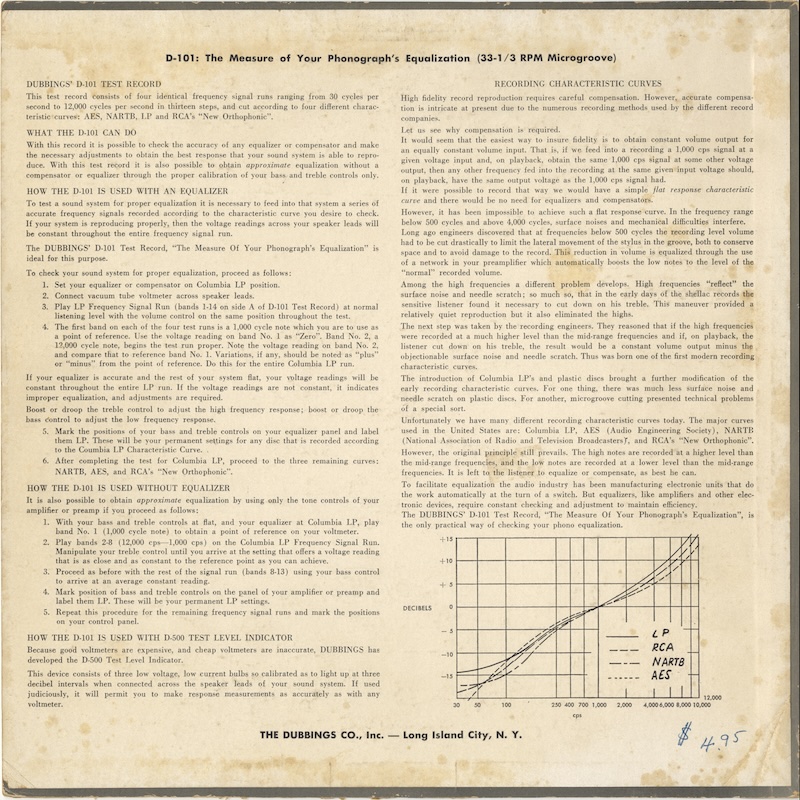
The Measure of Your Phonograph’s Equalization (Dubbings D-101, 1953)
from my own collection

この Dubbings D-101 の入手は結構大変だったよね。値段は高くなかったけど。
It was quite difficult to obtain the copy of Dubbings D-101, wasn’t it? The price was not much, though.
中古市場でも滅多にみない上に、状態の悪いテストレコードって入手してもあまり意味がないしね(笑) ともあれ、1951 AES カーブで記録されたテストレコードというのは、これ1種類しか存在してなかった可能性があるね。
It is rare to find it on the used market, and there is not much point in acquiring test records in poor condition 🙂 Anyway, it is possible that Dubbings D-101 was only one, recorded with the 1951 AES curve.

25.11 Phono EQs in Consumer Amplifiers
1950年代〜1960年代の民生用アンプでは、トーンコントロールだけではなく、ディスク再生イコライザを各種設定可能なものが多く存在していました。これらのポジションや実装回路の変遷を追っていくことで、当時のメーカのスタンスを間接的に確認できます。本セクションは1952年〜1965年頃のさまざまな民生用アンプのフォノEQ回路に関する内容です。
Many consumer amplifiers of the 1950s and 1960s had not only tone controls but also various disc playback equalizer settings. By following the transition of these positions and implemented circuits, we can indirectly confirm the stance of the manufacturers at that time. This section deals with the phono EQ circuits of various consumer amplifiers circa 1952-1965.
ハイファイブームが起こった1950年代〜1960年代、米国で販売されていた多種多様な民生用アンプの回路図を調べ、その変遷をたどることで、当時の再生機器メーカがどのようなEQカーブにどのようなポリシーで対応しようとしていたか、確認することができる。
By studying the circuit diagrams of various consumer amplifiers sold in the U.S. during the “Hi-Fi” boom of the 1950s and 1960s and tracing their evolution, we can confirm what kind of EQ curves and what kind of policies manufacturers of reproducing equipment at that time tried to follow.
45/45ステレオLP、およびステレオアンプ登場前の1957年までは、多くのプリメインアンプおよびプリアンプで、複数のEQカーブに対応していたことが確認できる。特に RIAA 策定以前の多くの機器では、Columbia LP ポジションがデフォルト、AES ポジションは New Orthophonic 用も兼用、あとは78回転盤用のロールオフなしのポジション、というものが一般的であった( Pt.17 セクション 17.7)。
It can be seen that until 1957, before the 45/45 stereo LP and the introduction of stereo amplifiers, many integrated amplifiers and preamplifiers were compatible with multiple EQ curves. Especially before the RIAA Standard was established, many amplifiers shared the following common positions: the Columbia LP position being the default; AES position (also used for New Orthophonic); the position for 78 rpm discs without roll-off ( Pt.17 Section 17.7).

Pt.17 セクション 17.7 では、1951年〜53年の、米国のさまざまな民生用アンプの内蔵フォノイコをみたんだったね。Bell 2200、Fisher 50-C Master Audio Control、Newcomb Classic 25、Marantz Audio Consolette、Stromberg-Carlson AR-425、Pickering 230H/132E、H.H. Scott 120-A、GE A1-900、Brooks 22A など。
In Pt.17 Section 17.7, we have overviewed built-in phono compensators of U.S. consumer amplifiers from 1951-53, including: Bell 2200, Fisher 50-C Master Audio Control, Newcomb Classic 25, Marantz Audio Consolette、Stromberg-Carlson AR-425, Pickering 230H/132E, H.H. Scott 120-A、GE A1-900 and Brooks 22A.
当初は Columbia LP と RCA (old) Orthophonic の折衷案的なポジション(ロールオフ 14dB)を備えた機種があったり、マイクログルーヴ盤向けには AES ポジションしかない機種があったりしたのが、1953年くらいにやっと New Orthophonic ポジションを備えた機種が登場していたね。Marantz Audio Consolette だけ1951年登場なのに多彩な設定が可能で別格な感じだったけど。
Initially, there were some models with a compromise position between Columbia LP and RCA’s (old) Orthophonic position, and some models with only AES position for microgroove records. But finally in 1953, a model with a New Orthophonic position was introduced. Interestingly, the Marantz Audio Consolette was the only one that had a wide variety of settings and was exceptional, even though it was introduced in 1951.

RIAA 策定後も、旧譜への対応から複数ポジションが選択可能なモノーラルアンプが一般的であったが、ステレオアンプ登場後の1958年あたりから、RIAA 一択の機種が徐々に増加していった。また、1965年頃になると、McIntosh、Marantz、Harman-Kardon といったごく一部の高級アンプのみが非RIAA対応機能を備えているのみであった。
It can be confirmed that the number of RIAA-only models gradually increased from 1958, after the introduction of stereo amplifiers, and by 1965, only a handful high-end amplifiers such as McIntosh, Marantz and Harman-Kardon were equipped with non-RIAA positions.

1958年度から1964年度の Allied Radio Catalog、および Audio 誌1964年8月号に掲載された当時の民生用アンプのスペックを、取説や回路図を順に調べて、その実装方法を確認したんだったよね。
We went through the specifications of the consumer amplifiers of the time in the Allied Radio Catalog from 1958 to 1964, plus Aug. 1964 issue of Audio magazine, going through the instruction manuals and schematics in order to see how they were implemented, right?
詳しくは Pt.22 全体をみてもらうとして、RIAA オンリーのアンプが増えていった過程は確認できたね。まとめた表を下に載せるね(1958〜1964 は Allied Catalog、1965 は Audio 誌)。
Yes, we were able to confirm the process of the increase in the number of RIAA-only amplifiers (for details, please refer to Pt.22 in its entirety).Below is the summary table of: “RIAA-only”, “RIAA with tone controls as EQ compensators”, “selectable from more than one EQ curves”, and “independent turnover/rolloff selectors”. Please note the year 1965 is from Audio magazine, the rest from the Allied Catalog.

| RIAA only |
RIAA + tone controls |
selectable | variable | |
|---|---|---|---|---|
| 1958 | 3 | 1 | 32 | 5 |
| 1959 | 12 | 6 | 23 | 3 |
| 1960 | 25 | 6 | 10 | 1 |
| 1961 | 29 | 5 | 9 | 2 |
| 1962 | 44 | 1 | 8 | 2 |
| 1963 | 54 | 1 | 9 | 3 |
| 1964 | 58 | 0 | 6 | 2 |
| 1965 | 70 | 0 | 7 | 1 |

当初はトーンコントロールで代用という機種も見られたんだったよね。そして1964年になると、ターンオーバー/ロールオフ可変方式を備えた民生用アンプは、Harman-Kardon Citation “A” と Citation I のみになっていたね。
In the beginning, there were some models that used tone controls as a substitute for playback curve adjustment. And by 1964, the only consumer amplifiers with variable turnover/rolloff systems were the Harman-Kardon Citation “A” and Citation I.
そうだね、そして、Fisher / Marantz / McIntosh は、せいぜい RIAA / Columbia LP の切替式だけになっていたね。
Yes, and Fisher / Marantz / McIntosh amplifiers at the time had only RIAA / Columbia LP switches at best.

さらに、1958〜59年頃のステレオLP黎明期のアンプ(KNIGHT KN-720、Bell 3030、Fisher X-101、Fisher 400-C)では、非RIAAカーブは左チャンネルのみ対応、という実装がなされており、これらのメーカはモノーラル盤のみ非RIAA対応としていたのが非常に興味深い( Pt.22 セクション 22.1.2)。
Furthermore, it is very interesting to note that in the early days of stereo amplifiers around 1958-59 (KNIGHT KN-720, Bell 3030, Fisher X-101, Fisher 400-C), non-RIAA curves were implemented only on the left channel, which means that these manufacturers only supported non-RIAA curves for monaural records ( Pt.22 Section 22.1.2).
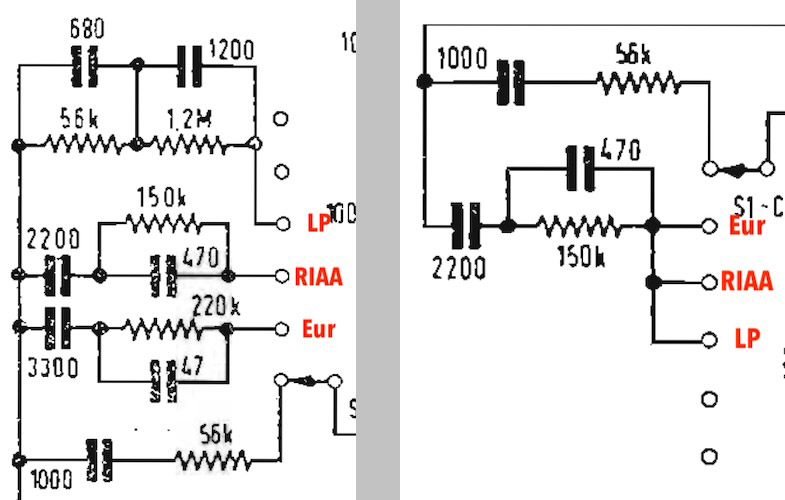
source: Scribd.
Bell 3030 アンプの PHONO プリアンプ部回路図抜粋
左チャンネルは Eur / RIAA / LP それぞれに専用フォノEQ回路があるのに、右チャンネルは3ポジションともに同一 (RIAA) 回路となっている
From Bell 3030 Amplifier’s schematic: right channel shares the RIAA de-emphasis circuit among the Eur / RIAA / LP position.

少し下でも紹介するけど、英国の Quad 22 プリアンプも同様に、モノーラルの時だけ非RIAAを選べる仕組みだったんだよね。
Quad 22 preamplifier also had a similar system that allowed the users to select non-RIAA position only when in mono (it’ll be mentioned a little further down).
そうだね、当時のほとんどの製造メーカは、「ステレオ盤はRIAAオンリー」という前提で回路設計してたんだろうね。
It is, and I guess most manufacturers at that time designed compensation circuits based on the assumption that stereo records were RIAA-only.

余談だが、1972年に日本で発行された、季刊ステレオサウンド特別増刊(No.21 ’72)「プリアンプ・パワーアンプのすべて」では、当時販売されていた国内外のプリアンプについて、フォノEQ回路のRIAA偏差を計測したグラフが掲載されており、RIAA カーブ対応内蔵フォノイコであっても、機種やその実装によって周波数応答特性に大きなばらつきがあったことが確認できる( Pt.23 セクション 23.1)。
As a side note, in “All About Preamplifiers and Power Amplifiers”, a special extra issue of Stereo Sound quarterly magazine (No.21, 1972), published in Japan, graphs of RIAA deviations of phono equalizer circuits are shown for all preamplifiers sold at the time, both domestic (Japanese) and import, and it is confirmed that even amplifiers with built-in RIAA equalizers had a large variation in frequency response characteristics depending on the model and its implementation ( Pt.23 Section 23.1).
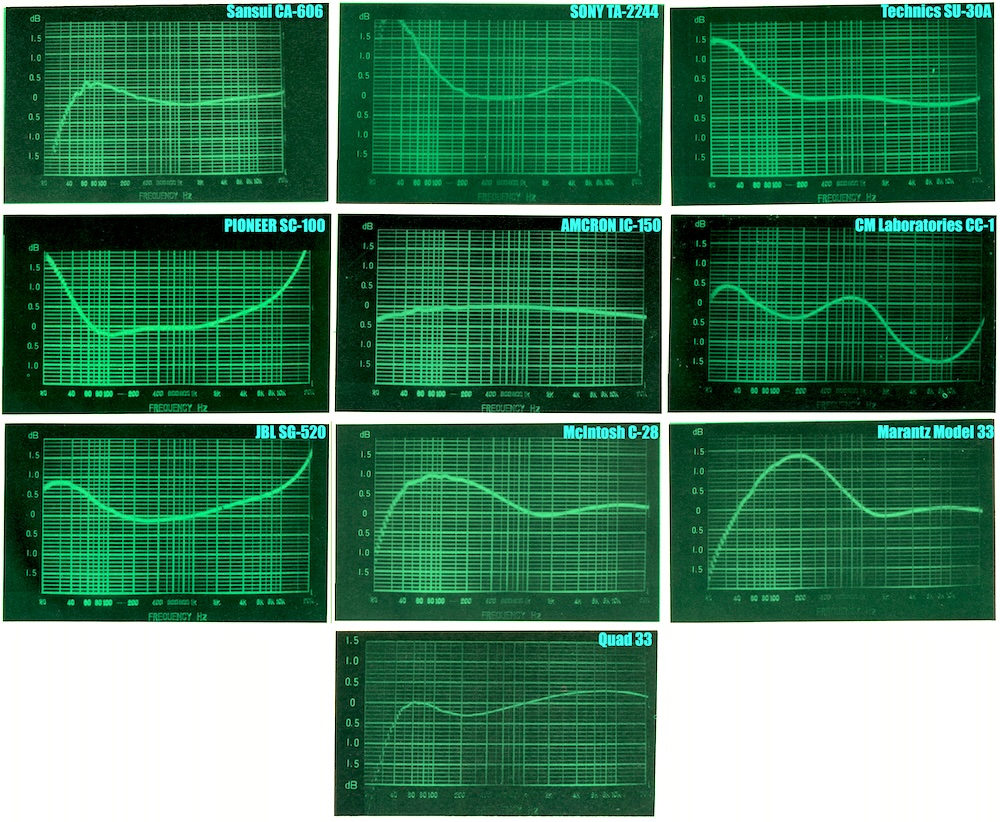
source: 季刊ステレオサウンド No.21 ’72 (Vo. 7, No. 2) 特別増刊 プリアンプ・パワーアンプのすべて (1972)
レビューされたプリアンプのRIAA偏差グラフの一例
定義域は20Hz〜100kHz
Some examples of RIAA deviation graphs (from 20Hz to 100kHz), measured by this particular magazine, of various preamplifiers.
25.12 History and Variety of EQ Curve List
マイクログルーヴLP登場と民生用ハイファイブーム以降、かつRIAA規格策定前後にあたる1950年代前半頃から、どのレーベルのどのレコードはどの再生カーブ適用が望ましいか、の一覧表が流通し始めました。また、1980年代末頃からも、さまざまなカーブ一覧表が出回り出しました。これらの歴史について。
This section deals with the history of “EQ Curve List”, initially began to circulate in the early 1950s — after the advent of the microgroove LPs and the consumer Hi-Fi boom, and around the time the RIAA Standards was established — as well as variety of recent lists that has been circulating again since the late 1980s.
LP登場、ハイファイブーム、RIAA規格策定以前、である1950年代に、どのレーベルのどのレコードがどの再生特性が適切か、のリストが雑誌に掲載されたのが、EQカーブ一覧の源流と考えられる。
The origin of the EQ Curve List is thought to be the publication in magazines in the 1950s, from the advent of LPs, the Hi-Fi boom, and before the establishment of the RIAA Standards, of lists of which playback characteristics are appropriate for which labels and which records.
最も有名なものは High Fidelity 誌の1953年1/2月号〜1957年10月号に掲載された「Dialing Your Disks」である( Pt.17 セクション 17.6)。連載開始当初は、レーベルに直接問い合わせをして「どの再生カーブが適切か」(「どの録音カーブか」ではないことに注意)の回答を掲載していた。しかし、途中からカテゴリー分けが変わったり、編集部による恣意的な書き換えが見られたりと、データにあまり一貫性がなかったりするため、信頼できる資料とはいいがたい。
The most famous is “Dialing Your Disks”, which appeared in the January/February 1953 to October 1957 issues of High Fidelity magazine ( Pt.17 Section 17.6). At the beginning of the series, the answers to “which playback curve is appropriate” (note that it is not “which recording curve”) were published by contacting the labels directly. However, since the categorization changed in the middle of the series, and the data was not very consistent, with some arbitary rewriting by the editorial staff, it is difficult to say that the data is a very reliable source.
一覧表ではないが、Radio & Television News 誌の1953年9月号〜1960年1月号に掲載された、Bert Whyte 氏による「Certified Record Revue」も参考になる( Pt.20 セクション 20.1.8)。こちらは、主にクラシックLPを対象として、試聴機器一覧も載せた上で1枚1枚試聴をし、音楽内容のレビューと共に、最も適切と思われる再生カーブが掲載されている。こちらによると、1955年11月号でレビューされた Columbia ML-4992 が「RIAAのはずだが、非RIAA (Columbia LP) の方が好ましく聴ける」とされたのを最後に、その後はすべてのレーベルのすべての盤が RIAA とされている。ただし、Whyte 氏による主観的判断であるので、これも絶対的に信頼できる資料とはいえない。
Although not a list, “Certified Record Revue” by Bert Whyte, which appeared in the September 1953 – January 1960 issues of Radio & Television News magazine, is also a useful reference ( Pt.20 Section 20.1.8). This is mainly for classical LPs, and includes a list of listening equipment units, reviews of the musical content, and the most appropriate playback curves for each LP. According to this, the Columbia ML-4992, which was reviewed in the November 1955 issue, was last judged to be “supposed to be RIAA, but non-RIAA (Columbia LP) is preferable”, and thereafter all reviewed discs by all labels were judged to be RIAA. However, since this is a subjective judgement by Mr. Whyte, it is not an absolutely reliable source either.
当時の可変フォノイコ内蔵プリアンプ、例えば1954年頃登場した McIntosh C-108 にも、レーベルとEQスイッチ設定の一覧表が付属していた( Pt.17 セクション 17.7.10)。一方、1959年頃登場とされる Quad 22 にはレーベル一覧表のプレートが存在していた( Pt.22 セクション 22.2.1)が、取説では時定数のみの表記となっている。
Variable phono preamplifiers of the time, such as the McIntosh C-108 (debuted probably in 1954), also came with a list of labels and EQ switch settings ( Pt.17 Section 17.7.10). On the other hand, a label listing plate existed for the Quad 22, debuted probably in 1959 ( Pt.22 Section 22.2.1), but the “installation and operation manual” only lists time constants.

これがその Quad 22 用プレートだね。実質4ポジションのみかな。
This is the plate for the Quad 22. I see it is practically equipped with only 4 positions.
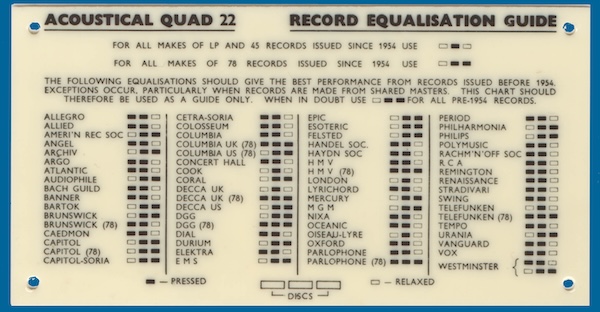
source: www.keith-snook.info.
McIntosh C-8 / C-108 を彷彿とさせる、Quad 22 プリアンプのフォノEQ設定表
「1954年以後は原則としてRIAA」「1954年以前についても例外もあるため、この表はあくまで参考として使用すべし」と記載がある
「FOR ALL MAKES OF LP AND 45 RECORDS ISSUED SINCE 1954 USE □■□」(1954年以降のLPと45回転は□■□ポジションを使用すべし)とあるね。だから、1954年以降は原則として RIAA だよ、あとは自分でいい感じに聴けるポジションを探してみてね、って立ち位置で作られたんだろうね。
It reads “FOR ALL MAKES OF LP AND 45 RECORDS ISSUED SINCE 1954 USE □■□”. So, I guess it was made from the standpoint of “in principle, use RIAA after 1954, and then find a desirable position to listen to”.


で、Quad 22 の取説には時定数のみ書かれていた、と。3,180μs/318μs/75μs は RIAA、3,180μs/318μs/100μs は 1942/1949 NAB、と一致してるけど、残り2つはなんだろう。
So, the Quad 22’s operating manual only mentioned time constants. The combination of 3,180μs/318μs/75μs is for RIAA, and 3,180μs/318μs/100μs for 1941/1949 NAB, but what are the other two?
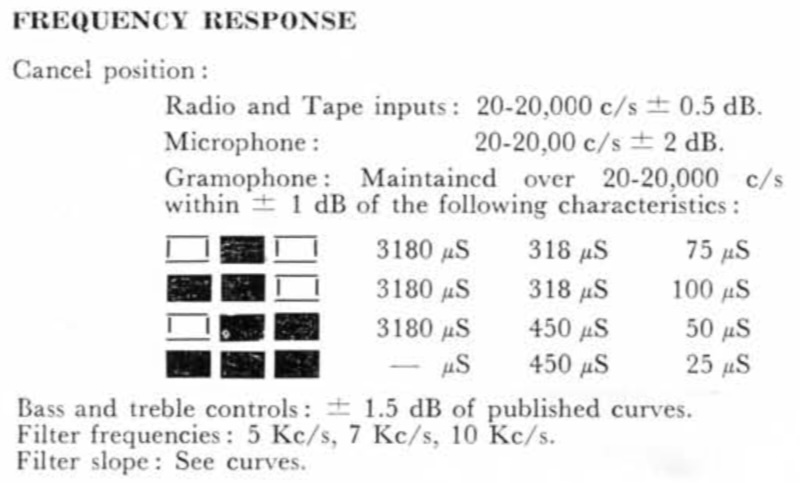
source: Quad 22 Control Unit Instruction Book.
時定数から判断すると、一番上の RIAA と2番目の NAB 以外は近似値でしかないことがわかる
3つ目の「3,180μs/450μs/50μs」ってのを考えてみよう。3,180μsは 1942/1949 NAB や RIAA と同じベースシェルフ、50μsは CCIR(DIN) の高域プリエンファシスだから英国・欧州向け、450μsってのはターンオーバー周波数としては354Hz あたりになるね。だから、恐らくは欧州盤LPや新し目の78回転盤向けのジェネリックな設定という狙いだったんじゃないかな。そして4つ目の「—/450μs/25μs」は一般的な78回転盤向けのジェネリックな設定だろうね。つまり、RIAA や NAB 以外は「だいたいいい感じに聴けるポジション」ってことだね。また、2つ目のポジションは、ベースシェルフ値だけ異なる Columbia LP 用も兼ねてたんだね。
Let’s consider the third one, “3,180μs / 450μs / 50μs”. 3,180μs is the same bass shelf as 1942/1949 NAB and RIAA, 50μs being the CCIR (DIN) high-frequency pre-emphasis for U.K. and Europe, and 450μs being the turnover frequency around 354Hz. So this position was probably intended as a generic setting for European LPs and postwar 78rpm recordings. And the fourth setting “—/450μs/25μs” is probably a generic setting for general 78rpm recordings. In other words, except for RIAA and NAB, these positions are “general position for adequate reproduction”. The second position was also for Columbia LPs, which differ only in the bass shelf value.


なるほどね。そういえば、Quad 22 でも、RIAA 以外はモノーラルのみ適用されるんだったね。
I see. Come to think of it, even in Quad 22, non-RIAA position is available only for mono.
そうだね、STEREO ボタン押下時は RIAAオンリーで、MON ボタン押下時は非RIAAも適用可能で片側のスピーカだけから音が出て、STEREO も MON も押下してないときは、MON と同じ状態で両方のスピーカから音が出る、という仕組みだね。つまり、ステレオ盤は RIAA オンリーという前提ということだね。
Yes, when the STEREO button is pressed, it is RIAA only. When the MON button is pressed, non-RIAA can also be applied and sound comes out of only one speaker. Then when neither STEREO nor MON is pressed, sound comes out of both spakers in the same state as MON. In other words, the stereo disc is supposed to be RIAA-only.


それで思い出した。EMT930st や 927st に搭載されていたフォノイコ、EMT155st も、ステレオは RIAA (75/318/3180μs) オンリーで、DIN 45 333 (50/318/3180μs) や BBC (25/318/3180μs) を選べるのはモノーラルだったね。
That remindes me, EMT155st, phono equalizer amplifier in EMT930st/927st was that only RIAA (75/318/3180μs) was available for stereo mode, while DIN 45 333 (50/318/3180μs) and BBC (25/318/3180μs) were available for monaural.
放送局用ターンテーブルだから、欧州や英国で過去〜当時に使われてきたマイクログルーヴ用の再生特性を選べるようになってたんだね。較正用のフラットポジション(高域プリエンファシス/ロールオフのみオフ)があるのも興味深いね。
It was a broadcast turntable, so it was capable of choosing the playback characteristics for microgroove records used in Europe and U.K. in the past and at the time. It’s also interesting that there’s a FLAT position for calibration (only high-frequency pre-emphasis/roll-off being off).

その後、1960年代に入ると、業界は RIAA で統一されてから十分な期間が経過したこともあり、カーブ一覧表のようなものは特に流布されていなかった(正確には、私は見つけられなかった)。
Later in the 1960s, when the industry had been unified under the RIAA long enough that no specific list of curves was being circulated (or, more accurately, I couldn’t find such a list).
次にそのようなカーブ一覧表が現れたのは、1987年頃に登場した78回転盤用可変フォノイコ、Owl Audio Products Owl 1 Restoration Module の取説(および関連する論文 “The Audiophile’s Guide to Phonorecord Playback Equalizer Settings”, James R. Powell, 1989)である( Pt.20 セクション 20.2.1)。主に78回転盤の忠実再生を目的とした機器であり、選択可能なターンオーバー値も FLAT/250/500/1Kと、それらの中間値である375/750という、実際には存在していなかった値が含まれていた。これは恐らくは機器製造上の都合、そして「あくまで近似値」という割り切りと思われる。しかしこの値により、「AESカーブはターンオーバー375Hzが正しい」と一部に誤解を与える結果も生んでしまった(取説を注意深く読むと「AESのターンオーバーは400Hz」「本機器では近似値の375Hzを使用」と書いてある)。
The next time such a list of curves appeared was in the instruction manual for the Owl Audio Products Owl 1 Restoration Module (a variable phono preamp for 78 rpm records) that appeared around 1987, as well as the related article “The Audiophile’s Guide to Phonorecord Playback Equalizer Settings” (James R. Powell, 1989) ( Pt.20 Section 20.2.1). This equipment was designed primarily for faithful reproduction of 78 rpm records, and the selectable turnover values included FLAT/250/500/1K as well as the intermediate values of 375/750 — the values not actually known to exist. This was probably due to manufacturing reasons, or perhaps because they were only approximate values. However, these values may have caused some people to misunderstand that the AES curve is correct with a turnover of 375Hz (if you read the instruction manual carefully, it says that the AES turnover is 400Hz and that this equipment uses the approximate value of 375Hz).

これがその該当部分か〜。「375」ってのは、あくまで Owl 1 のスイッチのポジションであって、AES が厳密に 375Hz って意味じゃないんだよね。同様に、Bartók カーブの 630Hz(正確には 629Hz)も、「750」って書かれているね。
So, this is the relevant part, isn’t it? the “375” is just the position of the Owl 1 switch, and doesn’t mean that the AES’s turnover is exactly 375Hz. Likewise, the Bartók curve’s 630Hz (629Hz to be exact) turnover frequency is written as “750”.

source: “Audiophile’s Guide to Phonorecord Playback Equalizer Settings”.
Powell氏の論文中のカーブ一覧のうち、「AES (375)」という表記が現れる例
そう。そしてこれが、その数ページあとに記載されている、「AES のターンオーバーは400Hzである」という箇所だね。だから、「Owl 1 には、400Hz ターンオーバーに相当するポジションはないけど、近似値である 375Hz のポジションを使ってね」という意味ってことだ。
Right. And this is what it says a few pages later: “The AES’s turnover is 400Hz”. So it means that “Owl 1 doesn’t have a position that corresponds to 400Hz turnover, but you may use this approximate 375Hz position”.


source: “Audiophile’s Guide to Phonorecord Playback Equalizer Settings”.
Powell 氏の文書の末尾「Definitions(定義)」で、AES の厳密なパラメータについて簡潔に書かれている箇所

そっか。そしてこの一覧表部分だけが一人歩きして引用されたものが流通したりしたわけか。
I see. And only this list section was circulated by itself, and the quoted materials was circulated as well.
そうだね。個々の値の出典が明記されていないEQカーブ一覧表の場合は、なぜそうなっているのか、を調べた方がいいってことだね。
Exactly. If a certain list of EQ curves does not specify the source of the individual values, we better find out why each value is listed as it is.

その他、現在に至るまでさまざまな一覧表が流布しているが、その多くは、過去の記事や過去の一覧表の「レーベルと設定値の一覧」だけをつまみ食いし恣意的につなぎ合わせたものであることが多いため、信憑性に乏しいと考えられる。
Various other lists have been circulated to this day, but many of them lack credibility because they are often arbitrarily pieced together by picking and choosing only the “list of labels and setting values” from past articles and past lists.
現時点で最も信頼できると考えられる一覧表のひとつに、Audacity の「Playback equalization for 78 rpm shellacs and early 33⅓ LPs」がある。これは、現在進行形で調査研究の結果が反映され更新され続けているほか、複数の説があるレーベルの設定については、論拠となる過去の情報源を逐一明記しているため、客観的に分析・比較することが可能となっている( Pt.20 セクション 20.2.5)。
One of the most reliable listings at this time is Audacity‘s “Playback equalization for 78 rpm shellacs and early 33⅓ LPs”. This list is continually updated to reflect the results of ongoing research and studies, and for each of the multiple theories on label settings, it clearly lists the past sources of information that suport each theory, making it possible to objectively analyze and compare them ( Pt.20 Section 20.2.5).
その他、PsPatial Audio のサイトでは、ディスク録音機器の歴史を丹念に調査研究されており、論理的推測を行う上での資料として有力である( Pt.20 セクション 20.2.3)。また、RIAA フォノイコと組み合わせて使う可変フォノイコライザ Esoteric Sound Rek-O-Kut Re-Equalizer III のマニュアルで解説されている独自分析も非常に参考になる資料である( Pt.20 セクション 20.2.4)。
Additionally, the PsPatial Audio website has a meticulously researched history of disc recording equipment, which is another powerful source for making logical inferences ( Pt.20 Section 20.2.3). Also, the operating manual for Esotreic Sound Rek-O-Kut Re-Equalizer III (variable phono equalizer for use with RIAA phono preamp) describes an independent analysis, which is a very informative document ( Pt.20 Section 20.2.4).

古今東西、いろんな「EQカーブ一覧表」が各所で出回ってるけど、一覧表を見て、その値を盲目的に鵜呑みにするってのはよくない傾向な気がするね…
All sorts of “EQ curve lists” have been floating around in various places, old and new, but it seems like a bad tendency to look at a list and blindly believe the values…
そうなんだ。ある一覧表ではなぜその値となっているか、その根拠はなにか、諸説ある場合はなぜ諸説あるのか、までさかのぼって考える、そのための資料として使う分にはいいんだけどね。
I agree. I think that it is fine to use such lists as reference materials for thinking about why a certain list has a certain value, what is the basis for that value, and if there are various theories, why there are various theories.


もちろん、ご本人が気持ちよく聴ける、そっちの方がいい感じに聴こえる、ってこと自体は自由だと思う…
Of course, one is free to listen to what you feel comfortable with or what sounds better that way…
…あくまで個々人の好みによる趣味だからね。ヴィンテージ機器を使用した色付け、グラフィックイコライザによる再生音作り、REW (Room EQ Wizard) などのソフトによるスピーカやルームアコースティックの補正、などなどと同様の立ち位置で「RIAA とされてるけど AES で聴いた方がかなり気持ちよかった!」とかは、全然ありだと思うよ。可変フォノイコを目的外使用でトーンコントロールのように使う、といった感じで。ただ、そのことと、客観的事実に基づかないまま「このレコードは1975年カッティングだけどRIAAカーブではなく○○カーブで記録された」と言い切ってしまうこととは、さすがに飛躍がありすぎ、ってことだね。
…because it’s just an hobby with individual’s preference and personal taste. I’d be happy to hear “this particular record is supposed to be RIAA, but it was much more pleasing to listen to it with AES curve!” or something like that, if it is in the same standpoint as coloring the sounnd with vintage equipment, creating playback sound with a graphic equalizer, or correcting loudspeaker and room acoustics with software such as REW (Room EQ Wizard), or anything like that. It’s just like using a variable phono preamp as a tone control, for non-purpose use. However, declaring “this record was cut in 1975 but recorded with XXX curve!” without being based on objective facts is a too much of a leap.


とはいえ、客観的データが一切見つからないレーベルも多いわけで、あれこれ推測し、いろんなカーブで聴いてみるってのが楽しいのもすごくよく分かるな。
Nevertheless, there are many labels for which no objective data can be found at all, and I can understand why it is fun to guess this way and that, and to listen to them with various curves.
そうだね。実際、あーでもない、こーでもない、って、いろんなカーブを当てはめて聴いてみるのは、それが客観的に正しいかどうかはさておき、楽しくないわけはないからね。
As a matter of fact, it’s simply fun to listen with various curves, deciding between this, that, and the other, whether they are objectively correct or not.

25.13 Conclusion and My Final Thoughts / 結論、および雑感
この2年間強の学びを通じて感じたこと、雑感、総まとめ、その他あれこれ。
Finally, this last section is a summary of what I have felt through my studies and researches over the past two years, miscellaneous impressions, general summary, and so on.
まずもって、ディスク録音という電子工学や物理学に立脚した技術、およびその歴史は、我々人類が生み出したものであり、その卓越した先人達の不断の試行錯誤の恩恵を受けていることに感謝するものである。
First of all, I am really grateful that the technology of disc recording, which is based on electronics and physics, and its history was created by human beings, and that we have benefited from the tireless trial and error of our distinguished predecessors.

だってね、そもそも「音が記録できる」「あとで聴くことができる」というだけで、とてつもなく素晴らしい発明だからね。Édouard-Léon Scott de Martinville (1817-1879) が「Phonautograph」と呼ばれる機械で実験的な音声録音を行い、当時は再生方法はなかったけど、技術と研究の進歩で1857年の記録を再生できたなんて、もう凄すぎるよね。この世に残る最も古い音が、たった170年ほど前のものだなんて。
To begin with, isn’t it a tremendously wonderful invention that we are able to “record sa ound” then “listen to later”? I can’t believe that the oldest sound left in this world is only about 170 years old — Édouard-Léon Scott de Martinville (1817-1879) made experimental sound recordings with a machine called “Phonautograph”, and although there was no way to play them back at the time, subsequent advanced advances in technology and research have made it possible to play back the recordings from 1857 — isn’t it just too amazing?
しかも、Thomas Edison (1847-1931) による1878年の錫箔円筒式「Phonograph」、Emil Berliner (1851-1929) による1881年の円盤式「Gramophone」、そこから考えても150年ほどしか経ってないんだよね。そこから、両面盤、電気録音、記録可能な周波数帯域の拡大、録音機器の進化、再生技術の進化、果ては4チャンネル、DMM、と、CD にその座を奪われるまであっという間の技術発展だったわけだね。人類が連綿と生み出し発展させてきた(そして現在進行形でますます進化する)ありとあらゆる技術史を前にすれば、先駆者の方々には本当に感服するしかない。
Furthermore, even if we consider 1878 tin-foil cylinder “Phonograph” by Thomas Edison (1847-1931), and 1881 disc “Gramophone” by Emil Berliner (1851-1929), only about 150 years have passed since them. From there, double-sided discs, electrical recording, expansion of recordable frequency range, evolution of recording equipment and reproducing technology, 4-channel, DMM, and so on — all developed very rapidly and quickly until the CD took its place. When we look back at the history of all kinds of technologies that mankind has continuously created, invented and developed (and that are still evolving), we can only admire these pioneers and predecessors.

本稿はそのような様々な技術史のうち、いわゆる「レコード」と呼ばれる音溝による円盤型記録メディア、その中でもさらに電気録音時代に発展した録音再生特性にまつわる(主に米国における)歴史のみにフォーカスしたものである。
This series of articles, including this one, focuses only on the history (mainly in the U.S.) of the so-called “phonograph/vinyl records”, a disc-type recording medium with sound grooves, and within that, on the recording and reproducing characteristics that developed in the electrical recording era.
21世紀の現在、さまざまな調査探究によって、ディスク録音特性の仕組み、そして適切な再生特性に関する情報と知見が蓄積しているが、その歴史を学べば学ぶほど、特に1950年代中頃までは、単に「ターンオーバー」「ロールオフ」の値だけで解決するような単純な話ではない、ということが非常に理解できる。
And now in the 21st century, various investigations and explorations have accumulated knowledge and information on the mechanism of disc recording characteristics and appropriate reproducing characteristics. However, the more we learn about the history of this process, the more we understand very well that it is not a simple story that can be solved simply by choosing from several parameters of “turnover” and “roll-off” values, especially until the mid-1950s.

当時のマイクや録音チェーン内の各機器の特性、ローパスフィルタの適用量、はたまた LCR イコライザか CR/NF イコライザかの違い、などなど、録音特性自体やその実現方法もそれこそ数えきれないほどあったわけだしね。しかも、それらの回路図など技術詳細が詳細に明らかになっているものばかりじゃないからね。
There were countless ways to realize recording characteristics, such as the characteristics of microphones and many other equipment in the recording chain at that time, the amount of low-pass filter applied, the difference betwen passive LCR equalizers and active CR/NF equalizers, etc. Moreover, not all of these technical details, such as schematics, are known in detail.
現代の我々が可変フォノイコのノブで見ている一連の値ですら、詳細が明確になっているごく一部の録音特性を除き、あくまで暫定的な値でしかないわけだよね。だから、ほとんどの場合は「この辺りの設定だといい感じで聴ける」つまり「その再生特性に対応する録音特性が正しいとは必ずしも保証されているわけではない」ってくらいに考えるべきだろうね。
Even the series of values we see today found on the front panels of the variable (archival) phono preamps are only tentatie values, except for a few recording characteristics for which the technical details are well known. So, in most cases, we should just think of it as “we can listen to the sound good at this setting”, or in other words, “it is not always guaranteed that the recording characteristics corresponding to the playback characteristic are correct”.

その上で、1954年〜1958年頃の米国のモノーラル盤(特にマイナーレーベル)における RIAA への切り替え時期、そして1960年代中頃までの英国および欧州のレーベル(U.K. Decca や Deutsche Grammophon など)における CCIR/DIN から RIAA 相当への切り替え時期、に関する議論は、マトリクス情報など客観的データも活用して継続的かつ地道な調査が行われているか、少なくとも過去の諸説を出典込みで併記して比較可能にし、個々の判断材料としてもらおうとしていることが確認できる。
On top of that, the discussion on the timing of the switch to RIAA for U.S. monaural recordings (especially minor labels) from 1954 to 1958, and the timing of the switch from CCIR/DIN to the RIAA equivalent for U.K. and European labels (U.K. Decca, Deutsche Grammophon, etc.) until the mid-1960s, can be confirmed by continuous and steady research using objective data, including matrix information on the dead wax area. It also can be confirmed that many reliable sources have been trying to make the past theories comparable by including their references, or at least to have them used as a basis for individual decisions.
残念ながら、当時のマスタリングスタジオの資料も、見つかっていなかったり、現存が確認されているものの社外秘扱いになっていたり、といったものが多く、客観的に確認することが難しい( Pt.20 セクション 20.1.9)ため、諸説あることは理解できる。
Unfortunately, many of the mastering studio documents from that period are not found, or some have been confirmed to exist but are treated as confidential, which make it difficult to objectively confirm their contents ( Pt.20 Section 20.1.9), and it’s understandable that there have been many theories.
その一方で、「1960年代〜1970年代のステレオLP時代であっても、非RIAAカーブが多くの米国レーベルでも使われていた」という説を目にすることがある。欧米では Michael Fremer 氏の継続的な記事などにより、ほぼ鎮火しているが、日本では依然として一部の層で根強く支持されている。
On the other hand, we sometimes see a theory that “even during the stereo LP era of the 1960s and 1970s, non-RIAA curves were used by many U.S. labels”. In Europe and the U.S., such theory has been almost extinguished by Mr. Michael Fremer’s continuous articles, but in Japan, it still has a strong following among a certain segment of the population.
さまざま調べていく過程で、「そのような説は、1990年代に日本のとあるオーディオメーカから始まったもので、オーディオフェアなどを通じて一部が欧州に伝播した(多くは出版物上ではなく、web掲示板上のカジュアルな情報交換の場に書き込まれたもの)」という有力な情報を複数人から得た。
After some research, with the help of several people, I found out that “such theory started with a certain Japanese audio manufacturer in the 1990s, and spread to Europe through audio fairs and other events (most of such discourses were not in publications but in casual online forums such as web bulletin boards)”.
これらは試聴による個々人の主観的判断のみに基づいたものであったり、それらの一覧表の類は、過去のさまざまな一覧表の恣意的な選定とつぎはぎによって作られたものがほとんどであると考えられる。これらの説は当然ながら、当時を知る録音エンジニア、現代の録音エンジニア、オーディオ工学研究者からは、明確に否定されている(あるいは、そもそも相手にされていない)。また、1960年代〜1990年代の欧米の雑誌や技術資料では同様の主張を確認できなかった。
These are based on personal judgments by individuals only through subjective auditioning, and most of these lists are thought to have been created by arbitrary selection and merging of various lists from the past. Such theories are, of course, unequivocally rejected (or not taken seriously in the first place) by recording engineers who knew about the period, contemporary recording engineers, and audio engineering researchers. I was also unable to confirm similar claims in Western journals and technical documents from the 1960s to the 1990s.

確かに、AES (Audio Engineering Society) や ARSC (Association for Recorded Sound Collections) といった、歴史あるアカデミックなオーディオ工学系・録音の保存研究系の学会論文などで、そのような主張を目にすることは皆無だね。
Certainly, we have not seen such a claim in academic papers from any of the historic academic audio engineering or recording preservation research, such as AES (Audio Engineering Society) or ARSC (Association for Recorded Sound Collections).
近接領域の論文はいくつかあって、例えば近年のものだと Gary A. Galo 氏の「The Columbia Lp Equalization Curve」(Spring 2009, ARSC Journal) ってのがあるね。周波数特性グラフしか明らかになっていない Columbia LP 録音カーブの、正確な時定数を探求するといった内容だね。
There are several papers on the near field, such as the recent one by Gary A. Galo, “The Columbia Lp Equalization Curve” (Spring 2009, ARSC Journal). This is an attempt to find the exact time constant of the Columbia LP recording curve, of which only the frequency response graph was published.

それでもなお、セッションごと、レーベルごと、時期ごと、担当エンジニアごと、に音の感触が大きく異なって聴こえるケースが大量にあり、非RIAAカーブで再生すると好ましく聞こえる場合があるのは事実である。
Still, it is true that there are many cases in which the reproduced sound differs from session to session, label to label, period to period, and engineer to engineer. And it is also true that they may sound preferable when played back using non-RIAA curves.

これはホントにそうなんだよね。EmArcy の YMG マトリクスとか、高域が暴れすぎていると感じてしまう盤もあって、本当に RIAA なのか、まさか NAB じゃねぇのか?とか思ってしまうほど。
This is so true. some of the EmArcy’s YMG matrix copies, for example, the high frequencies are so rampant, and sometimes I wonder if it is really RIAA — or is it NAB?
1954〜55年の Fine Sound Studios カッティングだから、AES はありえても、NAB なんて使うわけは絶対にないんだけどね。とにかく高域キンキンのカッティングがあるよね。
They are cut at the Fine Sound Studios in 1954-55, so there is no way they would have used NAB, even though AES is a weak possibility. Anyway, some of these records have a lot of shrilling high frequency.


なんか他にも極端な例を見つけてなかった?
Did you find any other extreme examples?
François Rabbath の「Bass Ball」(Philips U.S. PHM 200-128, 1964)ってアルバムだね。オリジナルはフランスの Philips B 77.973 L なんだけど。ともあれ、この PHM 200-128、異常にベースが薄くて、ターンオーバー1,000Hz、ロールオフ12dB にすると、なんとか聴ける感じになるんだけど、だからといってそんな意味不明な録音カーブでカッティングされたわけはないはずだよね。どう考えてもRIAAでカッティングされたはず。
The one is François Rabbath‘s “Bass Ball” (Philips U.S. PHM 200-128, 1964), although it is a equivalent U.S. release to the original French Philips B 77.973 L. Anyway, this PHM 200-128 has unusually thin bass, and when I set it to the exaggerated EQ setting, say, 1,000Hz turnover and 12dB roll-off, it sounds listenable. However, this doesn’t mean it was cut with such a nonsensical recording curve! For all intents and purposes, it should have been cut with RIAA.

フランソワ・ラバス (François Rabbath) の1964年の迷作(?) 怪作(?) “Bass Ball” (Philips PHM 200-128) があります。内容は非常に面白くて個人的には好きなのですが。
— Kohji Matsubayashi (@kohji405mi16) December 12, 2023
なんとも冴えない音で、ベースが薄いです。
無理やりターンオーバー1000Hz、ロールオフ 12dB… pic.twitter.com/jTtRg6XGqe
しかしこれらは、ディスク録音イコライザのせいではないと考えられる。むしろ、可変イコライザやコンプレッサ、高域減衰アンプ、ハイパス/ローパスフィルタ、ディエッサなど、1950年代以降に開発が進み広く普及し広く使われた、録音チェーン上の各種機材の適用による周波数応答特性や位相特性の変化によってマルチトラックテープや最終的なカッティング用マスターテープに記録されたものと考る方が自然である。エンジニアごと、レーベルごと、のさまざまな音作りは、それらの機器を駆使することで可能であり、固定であるべき録音イコライザをわざわざ変えて音作りをする必要がないからである( Pt.24)。
However, I believe that these are not likely to be due to differences in the disc recording equalizers. Rather, they are due to changes in frequency response characteristics and phase characteristics caused by the application of various equipment in the recording chain, such as variable equalizers, compressors, high-frequency reduction amplifiers, high-pass/low-pass filters, de-essers, etc, all of which have been developed, widely spread, and commonly used since the 1950s, and which change the frequency characteristics and phase characteristics of original recordings, then recorded on multitrack tapes or cutting master tapes. The reason for this is that it is highly possible to create different sounds of different engineers, labels and period, by making full use of such equipment, and there is no need to change the recording equalizer itself, which should be fixed, in order to create different sounds ( Pt.24).
特に、Pultec EQP-1/1A に代表される可変イコライザは、当時の全スタジオで必須の機材となったが、これらのアナログイコライザはその仕組み上、周波数応答特性をいじると、あわせて位相ずれが発生するという宿命がある(現代のリニアフェイズイコライザでは高調波歪や位相ずれは起こらないが、それとはまた別のプリリンギングやレイテンシなどの問題が発生する)。そしてまた、その高調波歪と位相ずれこそが、可変イコライザを通すことで得られる「なんとも言えない『いい感じ』の音」に寄与している。
In particular, variable equalizers such as the Pultec EQP-1/1A became indispensable equipment in virtually all studios at the time, but these analog equalizers, because of their mechanism, are destined to have harmonic distortions and phase shifts if their frequency response characteristics are tampered with (although phase shifts do not occur with modern “linear phase” equalizers, but they would have different issues such as pre-ringing and greater latency). And it is also true that the harmonic distortions and phase shifts are what contribute to the “indescribably rich and warm sound” obtained through the variable equalizers.

例えば可変イコライザで200Hzあたりをブースト(緑)してみると、位相シフト(紫)が起こっているのが確認できるね。
For example, if you boot around 200Hz with tha variable equalizer (green line), you can see the phase shift happening (purple).
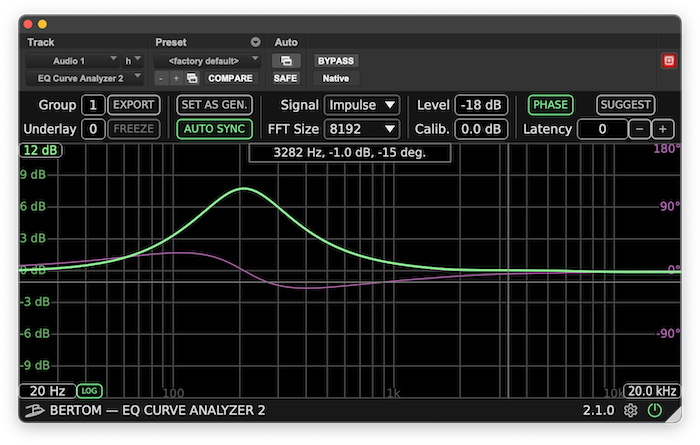
こちらは、ローパスフィルタとハイパスフィルタを適用してみた場合だね。
And this is a case where a low-pass filter and a high-pass filter is applied.

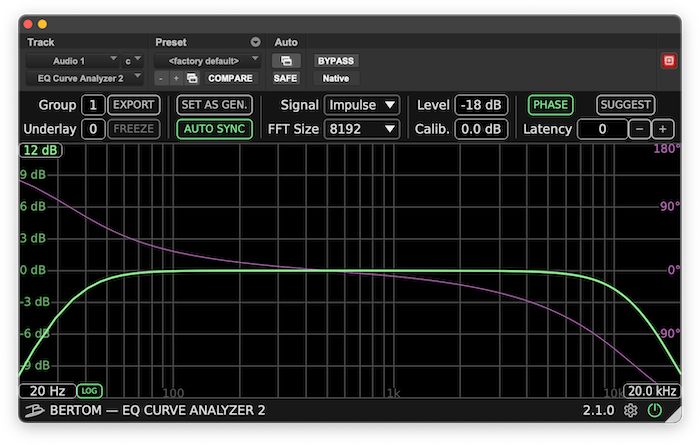

そういえば、マルチトラックマスターからリミックスされたCDの音、トラックダウンマスターから直接リイシューされたCDの音、当時のカッティングマスター由来と思われるCDの音、を、それぞれ比較してなかったっけ。
Come to think of it, I remember we compared the sound of CDs remixed from multitrack masters, CDs reissued directly from tracked-down masters, and CDs supposedly derived from the cutting masters of the time, respectively.
Pt.24 セクション 24.3 のことだね。提示した音源に偏りがあってゴメンナサイだけど(笑)、当時のスタジオでどのようにミキシングが行われ、どのように音作りがされていたのか、を間接的に知る、または想像を膨らませられる、面白いサンプルだったね。
You mean Pt.24 Section 24.3, right? Excessive bias for choosing the sound sources I presented, and sorry for that 🙂 but they actually were interesting examples that give an indirect idea or imagination of how mixing was done and how the sound was created in teh studios at that time.

ディスク録音イコライザと再生イコライザ(フォノイコ)も、単体では同様に位相がずれる。よって、録音イコライザと再生イコライザが完全に補完し合う関係(録音イコライザでの周波数特性と位相ずれを再生イコライザで打ち消す)にあったとしても、可変イコライザなどで発生した位相ずれがそのまま残るため、音源やミキシング、マスタリングによっては、定位や空間表現になんらかの影響をもたらす可能性がある。これが、時期的に RIAA 録音特性が使われているはずのレコードであるにも関わらず、非RIAAカーブで再生する方が定位や空間描写が良く聴こえる場合がある理由の可能性の1つと考えられる。
A disc recording equalizer and a playback equalizer similarly occurs phase shift if used individually. Therefore, if the recording equalizer and playback equalizer are in a perfect complementary relationship (the frequency response and phase shift of the recording equalizer is perfectly canceled by the playback equalizer), the phase shift generated by the variable equalizers, etc. will remain, and depending on the sound source, mixing and mastering, it may affect sound image localization and spatial representation. This may be one of the possible reasons why sound image and spatial representation may sound better when a certain record, even though the RIAA recording characteristics should have been used for ie, is played back with a non-RIAA curve,

そりゃそうか、イコライザを通すと位相がずれるのは宿命だもんな。
It’s a fate that the phase is shifted when it passes through the equalizer.
例えば下のグラフは、典型的なパッシブ LCR RIAA 再生イコライザの特性グラフだけど、破線が位相ずれを表しているね。
For example, the graph below shows the frequency characteristics of a typical passive LCR RIAA playback equalizer, and the dashed line showing the phase shift.

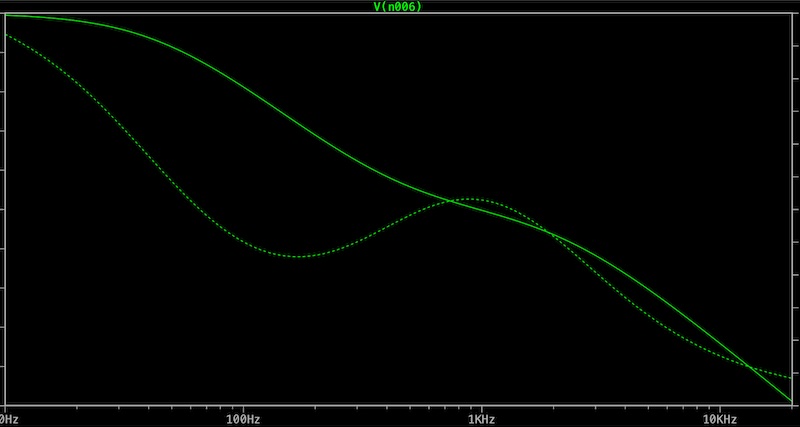
また、録音イコライザが本当に非RIAAに変えられていたのであれば、再生時にも再生イコライザの変更を促す旨レーベルやジャケットに記載がないと、そもそも意味をなさない。そして、RIAA再生カーブ前提で非RIAA録音カーブが使用されたのであれば、RIAAカーブで再生するのがマスタリングエンジニアの意図通りの音、ということになる。
Also, if the recording equalizer was indeed changed to non-RIAA, it would make no sense to begin with unless there is a statement on the label of the album cover that the playback equalizer should be changed accordingly as well. And if a non-RIAA recording curve was used based on the assumption that the RIAA playback curve was used, then playing back with the RIAA curve would be the sound the mastering engineer intended.

まんがいち、意図的に非RIAA録音特性を使ったのであれば、かつそれをどこにも書いていないとしたら、正しく適切な再生特性を使ってもらう術がないことになるからね…
Should there be non-RIAA recording characteristics intentionally used, and if that was not stated anywhere, then there is no way to get customers to use the correct and appropriate reproducing characteristics…
カッティング後の試聴やプレス後のチェックも RIAA 再生特性で行われていたわけだからね。まさか、秘密結社か密教のように、「意識高い系の人達」以外には門外不出の秘伝だったりしたわけでもないだろうからね。
…because listening checks after lacquer cutting, and after the records are pressed, were conducted using RIAA playback characteristics. And that’s impossible that there were some secret societies or esoteric religion that they never shared with the outside world, except for the “Wokes”.


門外不出の秘伝を、数百万枚とか製造される大量消費メディアでやるのか、ってことだね。
It means, did they do this with mass-consumed media that was manufactured in millions of copies?
1960年代中頃以降、あえてヴィンテージの可変フォノイコ内蔵アンプを持っていた「意識高い系の人」が仮に数万人いたとしよう。しかし、主たる購買層、すなわち残り数億人にとってはどうなるのか、ってことだね(笑)
Let’s say there were tens of thousands of “wokes” who dared to own vintage amplifiers with variable phono preamps built-in even after the mid-1960s. But what would happen to the main group of buyers, i.e. the remaining hundreds of millions of people? 🙂

あるレコードのカッティングに使用された録音イコライザの特性を聴感によって推定する方法として、「当時使われたカッティング用マスターテープからのストレートリイシューの音」との比較、あるいは「当時民生用に販売された 7½ ips (19cm/s) オープンリールテープの音」との比較、を行うというものが考えられる。この方法であれば、カッティング時の録音イコライザの特性(および、カッターヘッドの特性、カッティングアンプの特性、なども含む)のみの違いを聴けるからである。
One of the most appropriate ways to estimate the recording characteristics used in the cutting of a particular record would be to compare the sound on the record with “the sound of a straight reissue from a master tape used at the time for cutting” or “the sound of a 7½ ips (19cm/s) reel-to-reel tapes sold for consumer use at the time”. In this way, we can listen to the differences only in the characteristics of the recording equalizer (including the characteristics of the cutter heads, cutting amplifiers, etc.) used at the time of cutting.
とはいえ、ここまでに記してきた事柄はあくまで一般論であり、絶対に例外が存在しないとは言い切れない。上記のうち確度の高い客観的情報をベースとして、個別の事例について調査探究していくほかない。
That being said, everything described so far are only generalities, and it cannot be said that there are absolutely no exceptions. Based on the above objective information with a very high degree of certanty, we will have to continue to investigate individual cases.
25.14 Notable References (for my entire articles)
最後に、この長期間に渡る調査と学びで出会った、貴重な歴史的資料、当時の動向を伝える業界誌バックナンバー、オーディオ工学の礎を形作ってきた学術論文、そして同様の探究を行ってこられた多くの先達によるオンライン記事、などなどの中から、個人的に特に有用であったものを選りすぐって列挙します。
One last time, I would like to list a few of the things that I have personally found particularly useful in this long period of research and study, including various historical documents, back issues of trade magazines that tell the trends of the time, academic papers that have shaped the foundation of audio engineering, and online articles by many of those who have done similar research and study. Not the entire list of what I have read, but I have carefully selected the finest picks and listed them below.
なお、回路図、取扱説明書、サービスマニュアル、製品カタログ、そして雑誌類全般などは、膨大になるため、ここには記載していません。また、その他の事情で、一部の歴史的資料もここに列挙していません。
Please note that circuit diagrams, instruction manuals, service manuals, product catalogs, magazines in general, etc. are not included here because they would be voluminous. Also, for other reasons, some historical sources are not listed here.
もちろん、ここに列挙したものは、全て読みました(笑)
Of course, I have read everything listed here 🙂
25.14.1 Notable Books of Technical References in General
音響工学、アナログ電子回路、オーディオ工学、ディスク録音再生技術、などに関する、専門家向け(一部は一般読者向け)の包括的な解説書・参考書をまとめました。
Comprehensive manuals and reference books for professionals (and some for general readers) on acoustics, analog electronics, audio engineering, disc recording and reproducing technology, and more.
- “Sound Projection”, Rudolph Miehling. Mancall Publishing Corp., 1929.
- “Manual of Direct Disc Recording”. Berners (Publishers), Ltd., 1944.
- “Practical Disc Recording”, Richard H. Dorf. Gernsback Library No. 39, 1948.
- “Elements of Sound Recording”, John G. Frayne & Halley Wolfe. John Wiley & Sons, Inc., 1949.
- “BBC Recording Training Manual”. British Broadcasting Corporation, 1950.
- “The Recording and Reproduction of Sound, 2nd Edition”, Oliver Read. Howard W. Sams & Co. Inc., 1952.
- “Radiotron Designer’s Handbook, 4th Edition”, edited by F. Langford-Smith. RCA Victor Divisiion, 1952.
- “音響工学原論 上巻”, 伊藤毅, コロナ社, 1955.
- “音響工学原論 下巻”, 伊藤毅, コロナ社, 1957.
- “Audio Design Handbook”, H.A. Hartley. Gernsback Library No. 71, 1958.
- “レコードプレーヤ”, 山本武夫, 日本放送出版協会, 1971.
- “National Audio Handbook”, National Semiconductor Corporation, 1976.
- “プレーヤー・システムとその活きた使い方”, 井上敏也 監修. 無線と実験/初歩のラジオ 別冊, 誠文堂新光社, 1977
- “Handbook of Recording Engienering, 1st Edition”, John Eargle. Van Nostrand Reinhold Company, 1986.
- “Manual of Analogue Sound Restoration Techniques”, Peter Copeland. The British Library, 2008
- “Sound System Engineering, 4th Edition”, Don Davis, Eugene Patronis, Jr. and Pat Brown. Focal Press, 2013.
- “Basic Disc Mastering, 3rd Edition”, Larry Boden. self-published, ISBN 979-8-88896-058-5, 2022
25.14.2 Notable Books of History and Chronology
上記の技術解説書とは別に、技術的概要、歴史的背景、人物相関、業界勢力図、当時の世界情勢との関連、などを読み解くストーリーとして秀逸な書籍です。
Apart from the technical references mentioned above, here are excellent books that provides technical overview, historical background, character correlations, industry power structure, and connection to the word situation of the time, etc.
- “From Tin Foil To Stereo: Evolution of the Phonograph”, Oliver Read, H.W. Sams, 1959.
- “Maverick Inventor: My Turbulent Years at CBS”, Peter C. Goldmark with Lee Edison, Saturday Review Pres, 1973.
- “オーディオ50年史”, 日本オーディオ協会. 1986.
- “Sessions with Sinatra: Frank Sinatra and the art of recordings”, Charles L. Granata. A Cappella, 1999.
- “The Life and Times of A D Blumlein”, R.W. Burns, IET, 2000.
- “America on Record: A History of Recorded Sound”, Andre Millard, Cambridge University Press, 2005.
- “The Label: The Story of Columbia Records”, Gary Marmorstein, Thunder’s Mouth Press, 2007.
- “Recording The Thirties: The Evolution of the American Recording Industry, 1930-1939”, Allan Sutton, Mainspring Press, 2011.
- “360 Sound: The Columbia Records Story”, Sean Wilentz. Chronicle Books, 2012.
- “Chasing Sound: Technology, Culture, and the Art of Recording from Edison to the LP”, Susan Scmidt Horning, The John Hopkins University Press, 2013.
- “Playback: From the Vitrola to MP3, 100 Years of Music, Machines and Money”, Mark Coleman, Da Capo Press, 2003.
- “Vinyl-Lexikon: Fachbegriffe, Sammlerlatein, Praxistipps”, Frank Wonneberg. Schwarzkopf & Schwarzkopf Verlag GMBH, 2016.
- “The Vinyl Countdown: The Album from Vinyl to IPod and Back Again”, Travis Elborough. Soft Skull, 2009.
- “アナログディスクレコード技術の系統化報告と現存資料の状況”, 穴澤健明. 国立科学博物館技術の系統化調査報告, Vol.21, March 2014.
- “The Art of Sound: A Visual History for Audiophiles”, Terry Burrows. EMI Archive Trust, 2017.
25.14.3 Notable Interviews with Key Persons; Autobiographies
幸いなことに、当時のエンジニアや業界関係者に対するインタビューが、オーラルヒストリーとしてそこそこ記録されており、自伝と併せて非常に貴重な資料となっています。
Fortunately, interviews with engineers and industry professionals of the time have been recorded and preserved as oral histories, which are very valuable materials.
- “Oral History: Frederick Hunt – Session II”, interviewed by Beranek and Charles Weiner on January 8, 1965, AIP.
- “Interview with Edward Wallerstein: the development of LP”, interviewed by Ward Botsford in April 1969, ARCHIVEGRID.
- “Inventing The LP: An Interview with Dr. Peter Goldmark”, interviewed by Gerald Piel in 1970. (on website Past Daily: A Sound Archive of News, History, Music)
- “Haddy Addresses the 39th” (transcript of the speech by Arthur Haddy at the 39th AES Convention in October 1970, where he received the Emil Berliner Award), Journal of the Audio Engineering Society, Vol. 19, No. 1, January 1971, pp.70-72.
- “Oral-History: Arthur C. Keller”, interviewed by Julian Tebo on March 13, 1973, ETHW (Engineering and Technology History Wiki). (archived on June 14, 2024)
- “Creating the LP Record”, Edward Wallerstein as told to Ward Botsford, High Fidelity, Vol. 26, No. 4, April 1976, pp.56-61.
- “William S. Bachman Oral-History Interview”, interviewed by James A. Drake on October 28, 1977. (archived on March 2, 2023)
- “Putting the Record Straight: the Autobiography of John Culshaw”. The Viking Press, 1982
- “The Audio Interview: Emory Cook — First Take”, interviewed by David Lander in 1989. Audio, Vol. 73, No. 9, September 1989, pp.51-61.
- “An Afternoon with Bill Putnam”, interviewed by Peter Sutheim on December 21, 1980, Journal of the Audio Engineering Society, Vol. 37, No. 9, September 1990, pp.723-724,726,728,730.
- “An Afternoon with John G. Frayne”, interviewed by Peter Sutheim on March 9, 1980, Journal of the Audio Engineering Society, Vol. 38, No. 7/8, July/August 1990, pp.597-599.
- “Notable New Yorkers: Frank Stanton”, pp.618-624, interviewed by Mary Marshall Clark on February 17, 1994.
- “Interview with Clair Krepps”, interviewed by Susan Schmidt Horning on March 31, 1999.
- “John T. Mullin: The Man Who Put Bing Crosby on Tape”, Peter Hammer. Mix Online, October 1, 1999.
- “The Search for Roy DuNann”, Thomas Conrad, Stereophile, Vol. 25, No. 4, April 2002, pp.81-87.
- “Stan Ricker Live and Unplugged: True Confessions of a Musical and Mastering Maven” (Pt.1, Pt.2, Pt.3), Dave Glackin. Positive Feedback Issue 1-3.
- “Mastering Maven Mills Microscopically Minute Miracle”, Dave Glackin and Stan Ricker. Positive Feedback Issue 2.
- “Peter Bartók Interview”, interviewed by Paul Stamler in 2006. audioxpress.
- “Jim Reeves Autobiography”, possibly in 2013 or 2014.
- “Historically Significant Phono Cartridges, Part 1: Shure”, interview with Michael Patterson by Marc Silver on April 15, 2020.
25.14.4 Notable Academic Papers and Magazine Articles
最も多く参考にしたのは、学術論文、および業界技術雑誌に掲載された技術解説記事でした。面白いのが、当初の Audio Engineering 誌(のちの Audio 誌)で、一般向け月刊誌でもあり、同時に学会論文誌パートも含んでいました。
The most frequently referenced sources were academic papers, as well as technical commentary articles published in industry technical journals. It is interesting to note that the Audio Engineering magazine (later became Audio magazine) was both a monthly magazine for the general public, while also included an academic journal part.
1920s and 1930s
- “Methods of High Quality Recording and Reproducing of Music and Speech Based on Telephone Research”, J.P. Maxfield & H.C. Harrison. Bell System Technical Journal, Vol. 5, 1926, p.493-523.
- “Progress in the Recording and Reproduction of Sound”, A. Whitaker. Journal of Scientific Instruments, Vol. 5, pp.35-41, 1928.
- “Recent Advances in Wax Recording”, Hasley A. Frederick. Bell System Technical Journal, Vol. 8, No. 1, 1929, pp.159-172.
- “Audible Frequency Ranges of Music, Speech and Noise”, W.B. Snow. The Bell Technical Journal, October 1931, pp.616-627.
- “Vertical Sound Records”, H.A. Frederick. Journal of the Society of Motion Sound Picture Engineers, Vol. 18, No. 2, February 1932, pp.141-163.
- “Victrolac Motion Picture Records”, F.C. Barton. Journal of the Society of Motion Picture Engineers, Vol. 18, No. 4, April 1932, pp.452-460.
- “A New System of Sound Recording”, H.C. Harrison. Bell Laboratories Record, Vol. 10, No. 11, July 1932, pp.389-393.
- “New Horizons in Music”, Leopold Stokowski. The Journal of the Acoustical Society of America, Vol. 4, No. 1A, July 1932, pp.11-19.
- “An Instantaneous Recording Head”, George J. Saliba. Communication and Broadcast Engineering, Vol. 4, No. 3, March 1937, pp.8-9.
- “Recent Development in Hill and Dale Recorders”, L. Vieth & C.F. Wiebusch. Journal of the Society of Motion Picture Engineers, Vol. 30, No. 1, January 1938, pp.96-104.
- “HP6A: A Radical Departure in Phonograph Pick-up Design”, F.V. Hunt & J.A. Pierce. Electronics, Vol. 11, No. 3, March 1939, pp.9-12
- “Distortion in Sound Reproduction From Phonograph Records”, J.A. Pierce & F.V. Hunt. Journal of the Society of Motion Picture Engineers, Vol. 31, No. 2, August 1938, pp.157-186.
- “Phonograph Records”. Fortune, Vol. 20, No. 3, September 1939, pp.72-75,94,98,100,102.
- “RCA-NBC Orthacoustic Recording”, Robert M. Morris. ATE Journal, December 1939, pp.15-16.
1940s
- “Improvements in Disc Records Through Constant Amplitude Recording”, A.W. Duffield. Communications, Vol. 20, No. 3, March 1940, pp.13-14, 28.
- “Some Problems of Disk Recording”, S.J. Begun. Proceedings of the Institute of Radio Engineers (IRE), Vol. 28, No. 9, September 1940, pp.389-398.
- “A Lightweight Crystal Pickup Design”, A.P. Dank. ATE Journal, Vol. 8, No. 1, January 1941, pp.2-3.
- “A Theory of Tracing Distortion in Sound Reproduction from Phonograph Records”, W.D. Lewis & F.V. Hunt. The Journal of Acoustical Society of America, Vol. 12, No. 3, January 1941, pp.348-365.
- “Lateral Disc Recording”, B.F. Fredendall. RCA Broadcast News, No. 35, February 1941, pp.4-5.
- “Standards for Electrical Transcriptions”, Howard A. Chinn. Communications, Vol. 21, No. 9, September 1941, pp.10-11, 33.
- “Properties of the Dulled Lacquer Cutting Stylus”, C.J. LeBel. Journal of the Acoustical Society of America, Vol. 13, No. 3, January 1942, pp.265-273.
- “Recording and Reproducing Standards: As recommended by the Recording and Reproducing Standards Committee of the National Association of Broadcasters”, Howard A. Chinn. The Broadcast Engineers’ Journal, Vol. 9, No. 3, March 1942, pp.3-5.
- “A Discussion of Several Factors Contributing To Good Recording”, R.A. Lynn. RCA Review, Vol. 6, No. 4, April 1942, pp.463-472.
- “Recording and Reproducing Standards”, Lynne C. Smeby. Proceedings of the Institute of Radio Engineers (IRE), Vol. 30, No. 8, August 1942, pp.355-356.
- “Wireless World Brains Trust: Future of the Disc”, L.E.C. Hughes & Donald W. Aldous. The Wireless World, Vol. 50, No. 1, January 1944, pp.8-9.
- “Phonograph Dynamics”, William S. Bachman. Electronics Industries, Vol. 4, No. 7, June 1945, pp.86-89,124,128 & 190.
- “Tonal-Range and Sound-Intensity Preferences of Broadcast Listeners”, Howard A. Chinn & Philip Eisenberg. Proceedings of the Institute of Radio Engineers (IRE), Vol. 33, No. 9, September 1945, pp.571-581.
- “Crystal Pickup Compensation Circuits”, B.B. Bauer. Electronics, Vol. 18, No. 11, November 1945, pp.128-132.
- “Disc Recording”, Howard A. Chinn. Electronic Industries, Vol. 18, No. 11, November 1946, pp.64 & 66.
- “Recording Styli”, Isabel L. Capps. Electronic Industries, Vol. 18, No. 11, November 1946, pp.65,67,100,102,104,106,108 & 110.
- “NAB Recording Standards Meeting”. Audio Engineering, Vol. 31, No. 9, October 1947, pp.32 & 44.
- “Hollywood Sapphire Group”, Robert J. Callen. Audio Engineering, Vol. 32, No. 1, January 1948, pp.17 & 39.
- “A 33-1/3 Revolution in Recording”, Goddard Lieberson. Saturday Review (in Recording), Vol. 31, No. 26, June 26, 1948, pp.40-41.
- “One Record Holds Entire Symphony: New long-playing 12-inch disk contains 45 minutes of music”. LIFE, Vol. 25, No. 4, July 26, 1948, pp.39-40.
- “Proposed Standards for the Measurement of Distortion in Sound Recording”. Journal of the Society of Motion Picture Engineers, Vol. 51, No. 5, November 1948, pp.449-467.
- “The How and Why of RCA Victor’s New Record and Player”, D.D. Cole. Audio Record, Vol. 5, No. 3, March 1949, pp.1-4.
- “Disc Recording for Broadcast Stations”, W.J. Mahoney. Audio Engineering, Vol. 33, No. 4, April 1949, pp.9-13, 45-46.
- “A Record Changer and Record of Complementary Design”, B.R. Carson, A.D. Burt and H.I. Reiskind. RCA Review, Vol. 10, No. 2, June 1949, pp.173-190.
- “Crossover Filter for Disk Recording Heads”, H.E. Roys. RCA Broadcast News, No. 55, June 1949, pp.20-23.
- “Lateral Feedback Disk Recorder”, G.R. Yenzer. Audio Engineering, Vol. 33, No. 9, September 1949, pp.22-26 & 44.
- “The Columbia Long-Playing Microgroove Recording System”, Peter C. Goldmark, René Snepvangers and William S. Bachman. Proceedings of the Institute of Radio Engineers (IRE), Vol. 37, No. 8, August 1949, pp.923-927.
- “Design of Recording Systems, Pts. 1-3”, Leon A. Wortman. Fairchild Recording Equipment Corporation, as published in FM and Television, 1949.
1950s
- “RCA Policy on Records”, Frank M. Folsom. RCA Radio Age, Vol. 9, No. 2, January 1950, pp.20-21.
- “How to Use Standard Filters with New Flat Magnetic Pickup”, H.E. Roys. RCA Broadcast News, No. 58, March-April 1950, pp.4-6.
- “The Columbia Hot Stylus Recording Technique”, William S. Bachman. Audio Engineering, Vol. 34, No. 6, June 1950, pp.11-16.
- “AES Standard Playback Curve”, Audio Engineering Society. Audio Engineering, Vol. 35, No. 1, January 1951, pp.22, 44-45.
- “A World of Recording at WOR”. Audio Record, Vol. 8, No. 2, February 1952, pp.2-3 & 6.
- “Recording Binaural Sound on Discs”, Emory Cook. Tele-Tech, Vol. 11, No. 11, November 1952, pp.48-50,136, 138 & 140.
- “The Inside Story of FINE SOUND, Inc., Leon A. Wortman. Audio Record, Vol. 8, No. 8, November-December 1952, p.2”
- “RCA Records Have Improved Quality”, H.I. Reiskind. Radio Age, Vol. 12, No. 1, January 1953, pp.26-27.
- “Evolution of a Recording Curve”, R.C. Moyer. Audio Engineering, Vol. 37, No. 7, July 1953, pp.19-22 & 53-54.
- “The Proposed AES Standard: Standard Playback Characteristic for Lateral Disk Recordings”, Audio Engineering Society. Journal of the Audio Engineering Society, Vol. 2, No. 1, January 1954, pp.3-7.
- “The Curve That Conforms”, (possibly the magazine’s editorial). Radio & Television News, Vol. 52, No. 1, July 1954, pp.49 & 78.
- “A Moving-Coil Feedback Disk Recorder”, Charles C. Davis. Journal of the Audio Engineering Society, Vol. 2, No. 4, October 1954, pp.228-233.
- “An Introduction to RCA Victor Record Engineering”, Charles O’D. Knue. RCA Engineer, Vol. 3, No. 2, October-November 1957, pp.4-7.
- “RCA Disc Recording Practices”, William H. Miltenburg. RCA Engineer, Vol. 3, No. 2, October-November 1957, pp.8-10.
- “Standard Disc Recording Characteristic”, Robert C. Moyer. RCA Engineer, Vol. 3, No. 2, October-November 1957, pp.11-13
- “Factors in Phonograph Record Reproduction”, Roy S. Fine. RCA Engineer, Vol. 3, No. 2, October-November 1957, pp.26-27.
- “Behind the Scenes at Universal Recording Studios”, Marshall Lewis. Audio Record, Vol. 13, No. 4, December 1957, pp. 4-5 & 6
- “人工高分子のレコード”, 柳本孝男. 高分子, Vol. 8, No. 7, June 1959, pp.364-367.
1960s and beyond
- “Automatic Measurement of Phonograph Reproducers”, B.B. Bauer. The General Radio Experimenter, Vol. 36, Nos. 1 & 2, January-February 1962, pp.15-21.
- “The Saga of the Recording Stylus”, Arnold Schwartz, Arthur J. Gust and Benjamin B. Bauer. AES Convention Paper 15, 1963.
- “The Westrex 3D StereoDisk System”, C.S. Nelson and J.W. Stafford. Journal of the Audio Engineering Society, Vol. 12, No. 3, July 1964, pp.178-185.
- “The RIAA Engineering Committee”, H.E. Roys. Journal of the Audio Engineering Society, Vol. 16, No. 1, January 1968, pp.18-20.
- “Test Records”, Arnold Schwartz. db, Vol. 3, No. 4, April 1969, pp.21-24.
- “Test discs”, Hugh Ford. Studio Sound, Vol. 17, No. 2, February 1975, pp.38-44.
- “A Thirty-five Year History and Evolution of the Recording Studio”, Milton T. Putnam. AES Convention Preprint 1661, 1980.
- “Stokowski and the Bell Telephone Laboratories: Collaboration in the development of high-fidelity sound reproduction”, Robert E. McGinn. Technology and Culture, Vol. 24, No. 1, 1983, pp.38-75.
- “History of Disk Recording”, John G. Frayne. Journal of the Audio Engineering Society, Vol. 33, No. 4, April 1985, pp.263-266, 269 & 270.
- “Diseno y construccion de un control con microprocesador para un torno de corte de acetatos master, utilizado en la fabrication de discos fonográficos”, Diego Fernando Tapia Tapia. Tesis previa a la obtencion del titulo de ingeniero en electronica y telecomunicaciones, Escuela Politécnica Nacional, Ecuador. April 1988.
- “SOUND AND RECORDINGS: To the LP At 40: Hail! (And Farewell?)”, David Hamilton. The New York Times, Sunday, June 5, 1988, p.29 & 32.
- “Audio Technology in the United States to 1943 and Its Relationship to Magnetic Recording”, Mark Clark. AES Convention Paper 3481, 1993.
- “Disc Recording Equalization Demystified”, Gary A. Galo. The LP Is Back!, pp.44-54. Based on the paper of the same title, appeared on the ARSC Journal, Vol. 27:2, 1996.
- “A new theory about the 1932 Stereo recordings”, Michael Shoshani. DEMS Bulletin, 1999/1 (March-May), p.11.
- “The Development of Disc Cutting Heads”, Sean Davies. AES Convention Paper 5751, 2003.
- “The Columbia Lp Equalization Curve”, Gary A. Galo. ARSC Journal, Vol.40:1, 2009.
- “The Columbia Graphophone Company, 1923–1931: Commercial Competition, Cultural Plurality and Beyond”, David Patmore. Musicae Scientiae, Vol. 14, No. 2, September 2010, pp.115-137.
- “History of The Early Days of Ampex Corporation, as recalled by John Leslie and Ross Snyder”, AES Historical Committee, December 17, 2010.
- “The Art and Science of Acoustic Recording: Re-enacting Arthur Nikisch and the Berlin Philharmonic Orchestra’s landmark 1913 recording of Beethoven’s Fifth Symphony”, Aleks Kolkowski, Duncan Miller & Amy Bier-Carruthers. Science Museum Group Journal, Spring 2015 (online).
- “The New Age of Sound: How Bell Telephone Laboratories and Leopold Stokowski Modernized Music”, Gabrielle E. O’Brien. Acoustics Today, Vol. 14, No. 2, 2018, pp.17-24.
25.14.5 Notable Patents
ディスクレコード録音再生技術の発展を垣間見ることができる、これらの特許文書も非常に貴重な資料です。ここでは原則としてLP誕生直前までのものに絞っています。
These patent documents are also extremely valuable resources that provide a glimpse into the development of recording and reproducing technology of phonograph records. Here I focus on those dating back to just before the birth of the LP.
- “Phonograph Recording and Reproducing”, Lloyd Espenschied, U.S. Patent 1,713,039. Filed November 1919, Patented May 14, 1929.
- “Device for the transmission of mechanical vibratory energy”, H.C. Harrison, U.S. Patent 1,678,116. Filed October 16, 1924, Patented July 24, 1928.
- “Improvements in and relating to sound-transmission, sound-recording and sound-reproducing systems”, A.D. Blumlein, G.B. Patent 394,325. Filed December 14, 1931, Patented June 14, 1933.
- “Phonograph Record”, James H. Hunter, U.S. Patent 2,130,239. Application February 27, 1937, Patented September 13, 1938.
- “Sound Recording and Reproducing System”, Stuart W. Seeley, U.S. Patent 2,139,916. Application January 19, 1931, Patented December 13, 1938.
- “Vibratory System”, L. Vieth, U.S. Patent 2,161,489. Application October 7, 1937, Patented June 6, 1939.
- “Electromechanical-conversion device”, Frederick Vinton Hunt & John Alvin Pierce, U.S. Patent 2,239,717. Application August 2, 1938. Patented April 29, 1941.
- “Sound Translating System”, Roland A. Lynn & Jarrett L. Hathaway, U.S. Patent 2,286,494. Application February 28, 1940, Patented June 16, 1942.
- “Phonograph Recording and Reproducing System”, Issac P. Rodman, U.S. Patent 2,426,241. Application February 11, 1943, Patented August 26, 1947.
- “Magnetic Phonograph Pickup”, William S. Bachman, U.S. Patent 2,511,663. Application December 29, 1945, Patented June 13, 1950.
25.14.6 Other Notable Web Articles
その他、web 上で公開されている情報からも、多くのことを学ばせていただきました。
I also learned a lot from other information available on the web.
- “Licensing the Western Electric Electrical Recording System”, stokowski.org. (archived on June 21, 2023)
- “1978 Technical Seminar on High Fidelity Phonograph Cartridges”, Shure Incorporated, 1978.
- “Decca/London Records Myths Exploded!”, Michael Fremer. AnalogPlanet, March 2, 2013.
- “Phono Equalization B.S. Continues!”, Michael Fremer. AnalogPlanet, October 4, 2014.
- PSPATIAL AUDIO (Stereo Lab)
- Historical Recording Characteristics
- Early Recordings and how to deal with them
- Disc-cutting lathes
- 78 RPM records: EQ, getting rid of crackles and surface noise…..
- “The Genesis of Vinyl Stereo Record”, Rolf Badenhausen.
- “The World of Inductive RIAA deemphasis Networks”, PAEng.
- “Inside the Archival Box: The First Long-Playing Disc”, Amanda Jenkins. Library of Congress Blog, April 13, 2019.
- “Audio Tape Restoration Tips & Notes”, Richard L Hess.
- “【技術情報】真空管式フォノイコライザーアンプの製作 実験編”, marutsu SELECT.
- “LCR Phono preamplifier” (Pt.1, Pt.2, Pt.3, Revisited), a Direct Heating Triode blog.
- “LCRイコライザアンプ”, M.I.の趣味の部屋
- “低コストで作れるLCR型RIAAイコライザアンプの試作”, MOHのオーディオ部屋
- “Etude d’un préamplificateur à haute définition, 1. Etage phono à correction passive LCR”, Jean Hiraga. Audiophile n°39, automne 1986.
- “Mastering for Vinyl: Tips for Digital Mastering Engineers”, Jett Galindo. iZOTOPE, January 25, 2022.
- “アナログレコード再生のページ”
- “Battle of the Speeds: LPs, 45s, and the Decline of the 78 (1939 – 1950)”, Allan Sutton. Mainspring Press, May 8, 2024.
25.15 Special Thanks To…(titles omitted, 敬称略)
正式な学術論文でもないこの一連の長編駄文を最後までお読みくださり、ありがとうございます。
Thank you for reading this series of long-winded ramblings, which are not even formal academic papers.
最後に、この2年強の学びにおいて、以下の方々から情報提供、資料貸与、コメント、アドバイス、など、直接的・間接的になんらかの貢献をいただきました。この場を借りて感謝致します。
Lastly, the following people have contributed in some way — directly or indirectly — whether by providing information, materials, comments, advice, or otherwise, during the past two plus years of my study. I would like to take this opportunity to express my appreciation to them all.
(抜けている方がいらっしゃいましたら、ご連絡下さい)
(If anyone is missing, please let me know)
via e-mails:
- Nicholas Bergh, Endpoint Audio Lab
- Tom Fine
- Miles Showell, Abbey Road Studios
- Mark Wilder, Battery Studios, Sony Music Entertainment
- James Michael Baxter, University of Maryland
- Ron Cornelius, McIntosh
via X (was: Twitter) and its direct messages:
- Neu (@doctordyper on X)
- saboten records (@sabo_reco on X)
- ランブリンボーイズ (@ramblinboys on X)
- せりえりる (@serieril on X)
- onojii (@onojii1020 on X)
- tuesdaybreakheart (@tuesdaybreakhea on X)
- 嶋護 (しま・もり)(@bestsoundingcds on X)
via Facebook, Messengers, and mailing:
- 瀬谷 徹
- 貝田 雅之
- 指宿 明



